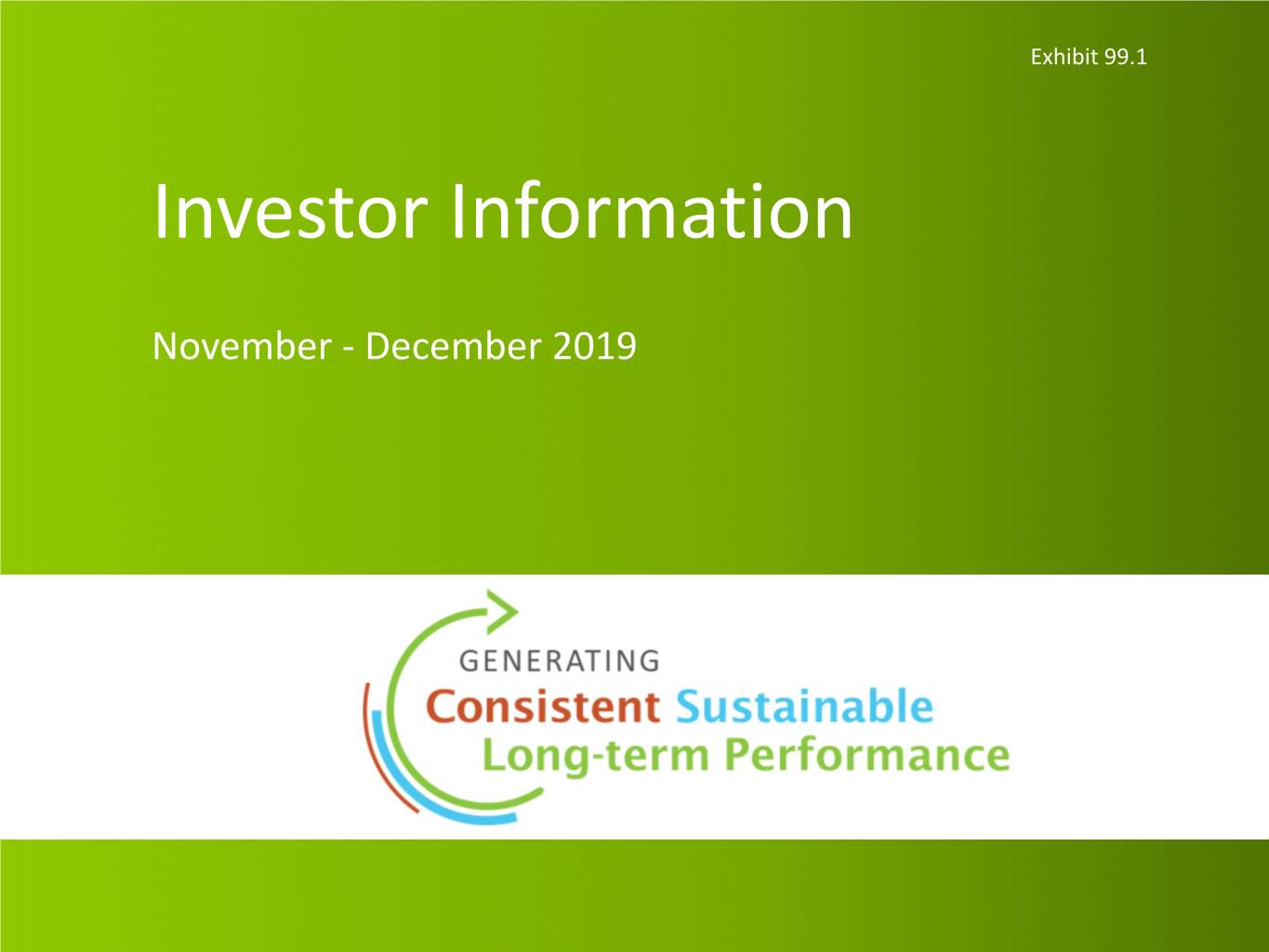
Exhibit 99.1 Investor Information November - December 2019
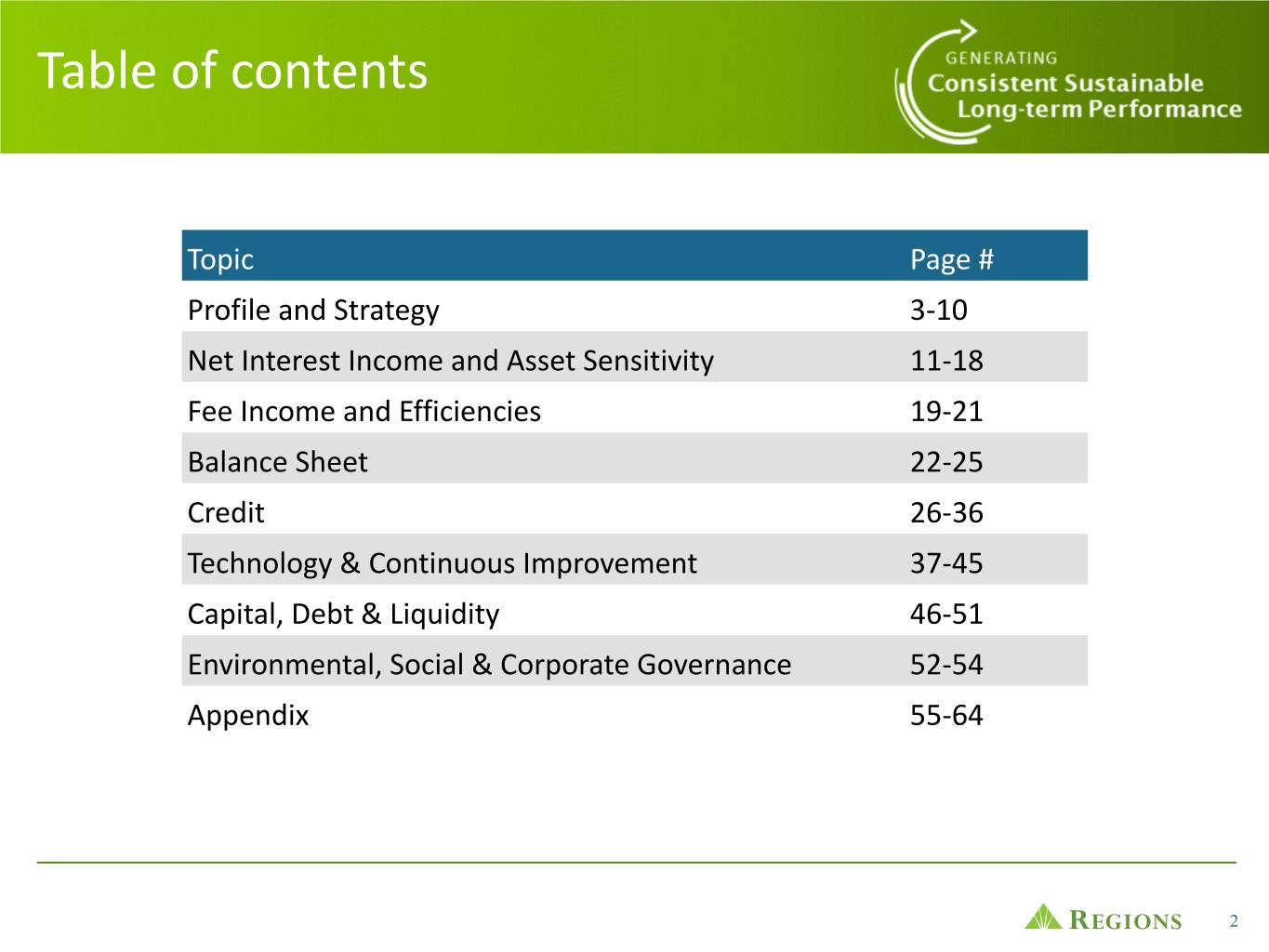
Table of contents Topic Page # Profile and Strategy 3-10 Net Interest Income and Asset Sensitivity 11-18 Fee Income and Efficiencies 19-21 Balance Sheet 22-25 Credit 26-36 Technology & Continuous Improvement 37-45 Capital, Debt & Liquidity 46-51 Environmental, Social & Corporate Governance 52-54 Appendix 55-64 2
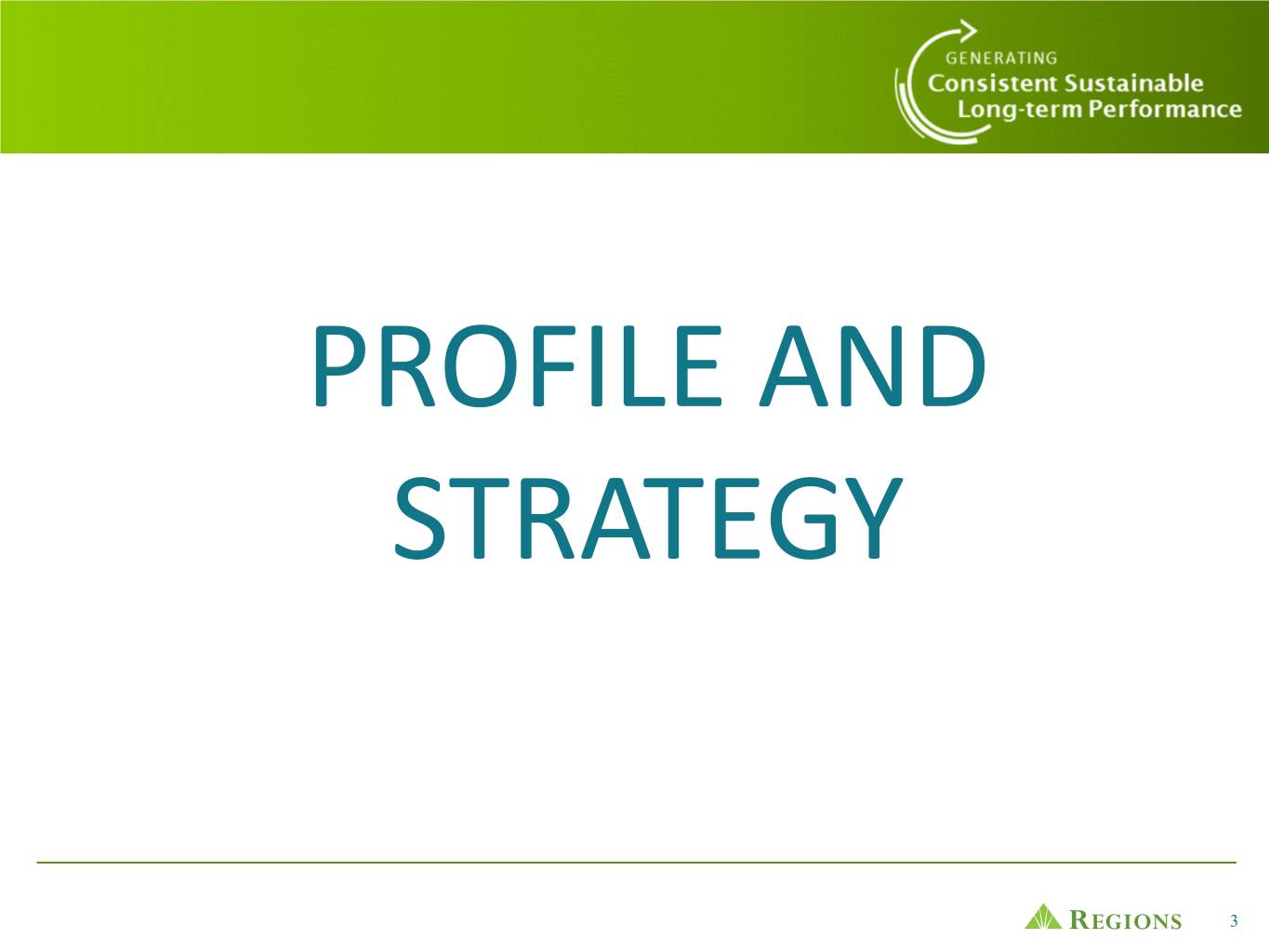
PROFILE AND STRATEGY 3
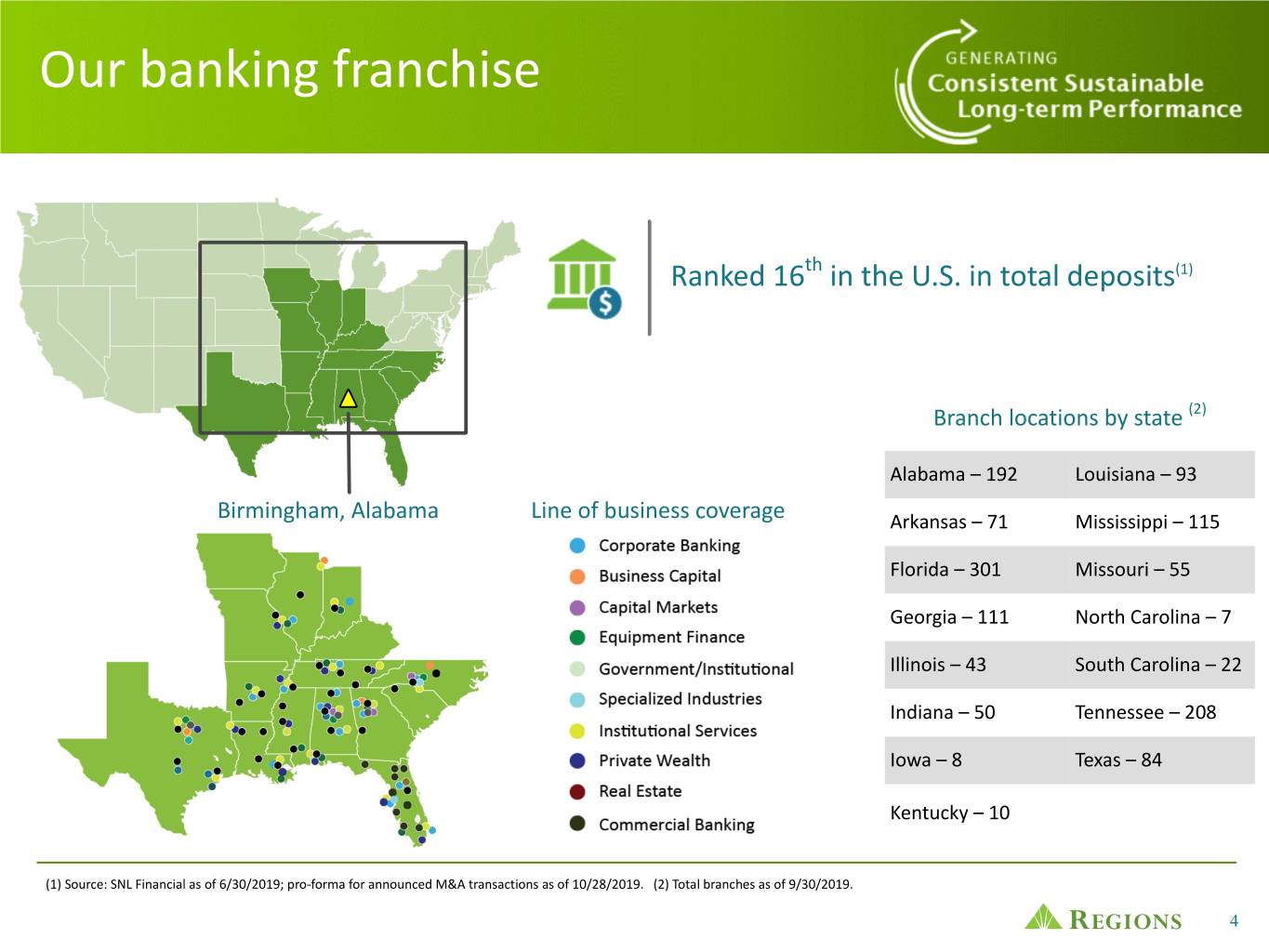
Our banking franchise Ranked 16th in the U.S. in total deposits(1) Branch locations by state (2) Alabama – 192 Louisiana – 93 Birmingham, Alabama Line of business coverage Arkansas – 71 Mississippi – 115 Florida – 301 Missouri – 55 Georgia – 111 North Carolina – 7 Illinois – 43 South Carolina – 22 Indiana – 50 Tennessee – 208 Iowa – 8 Texas – 84 Kentucky – 10 (1) Source: SNL Financial as of 6/30/2019; pro-forma for announced M&A transactions as of 10/28/2019. (2) Total branches as of 9/30/2019. 4
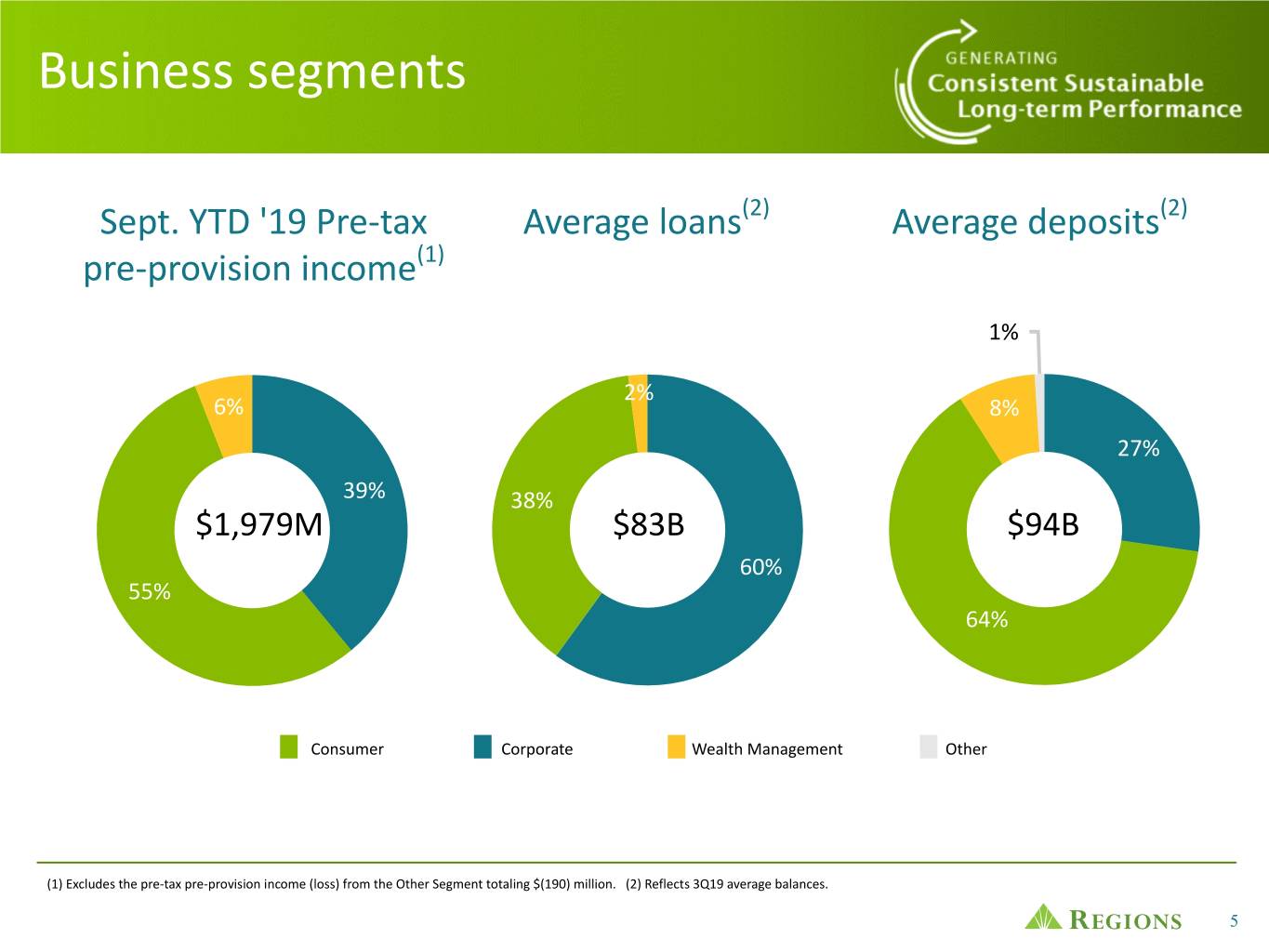
Business segments Sept. YTD '19 Pre-tax Average loans(2) Average deposits(2) pre-provision income(1) 1% 2% 6% 8% 27% 39% 38% $1,979M $83B $94B 60% 55% 64% Consumer Corporate Wealth Management Other (1) Excludes the pre-tax pre-provision income (loss) from the Other Segment totaling $(190) million. (2) Reflects 3Q19 average balances. 5
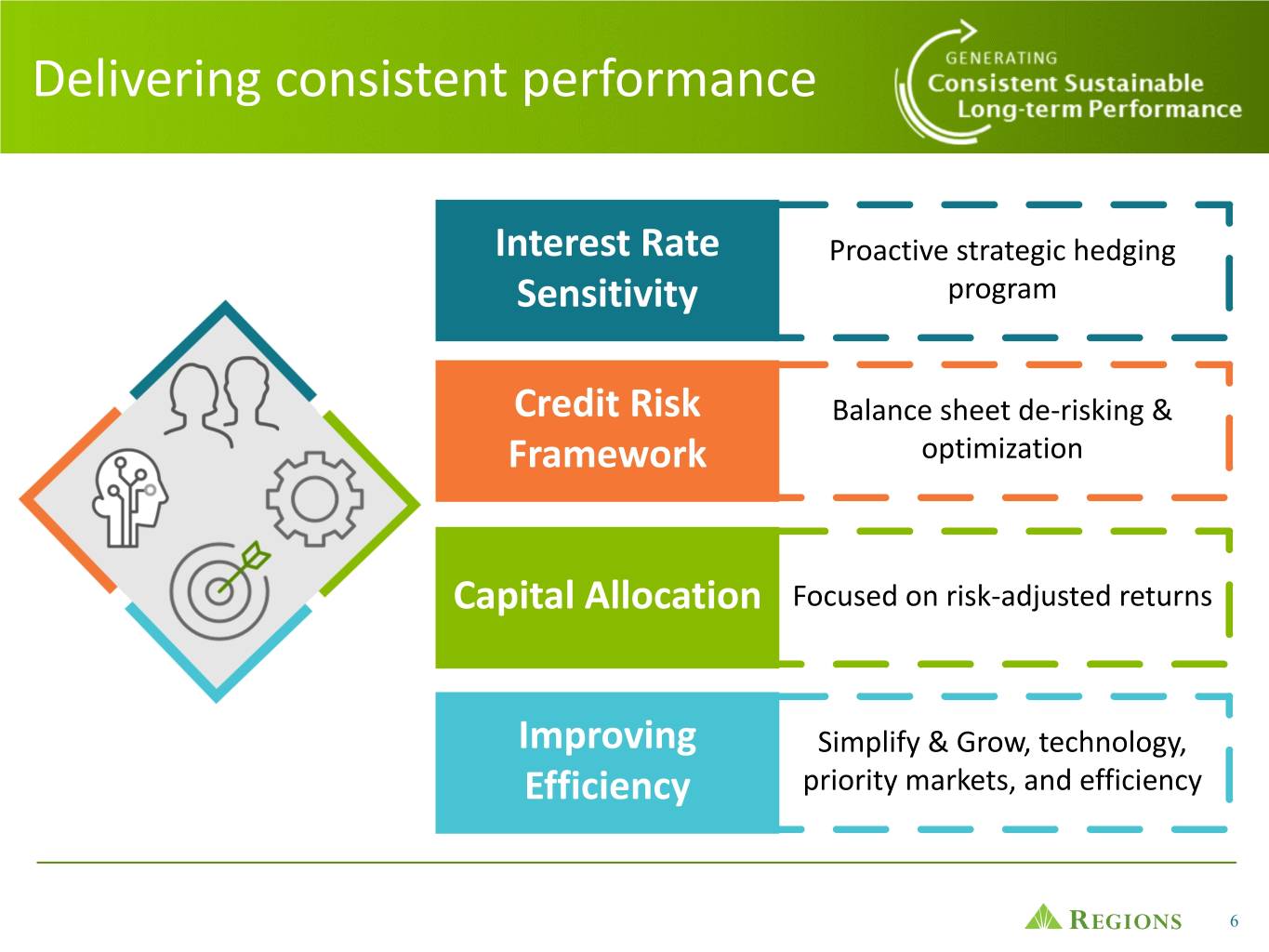
Delivering consistent performance Interest Rate Proactive strategic hedging Sensitivity program Credit Risk Balance sheet de-risking & Framework optimization Capital Allocation Focused on risk-adjusted returns Improving Simplify & Grow, technology, Efficiency priority markets, and efficiency 6

Top market share plays a valuable role in the competitive landscape (1) Markets with top 5 market share • Ranked 16th in the U.S. in total deposits(1) • 87% of deposits in 7 states: Alabama, Tennessee, Florida, Louisiana, Mississippi, Georgia, Arkansas • Top 5 or better market share in ~70% of MSAs across 15-state footprint(1) • ~70% of deposits in markets without a significant money center bank presence(2) • Investing in priority markets • St. Louis, Missouri • Atlanta, Georgia MSAs • Orlando, Florida Non-MSA counties • Houston, Texas (1) Based on MSA and non-MSA counties using FDIC deposit data as of 6/30/2019; pro-forma for announced M&A transactions as of 10/28/2019. (2) Significant money center bank presence (JPM, BAC, C, WFC) defined as combined market share using 6/30/2019 FDIC deposit data of 20% or more. 7
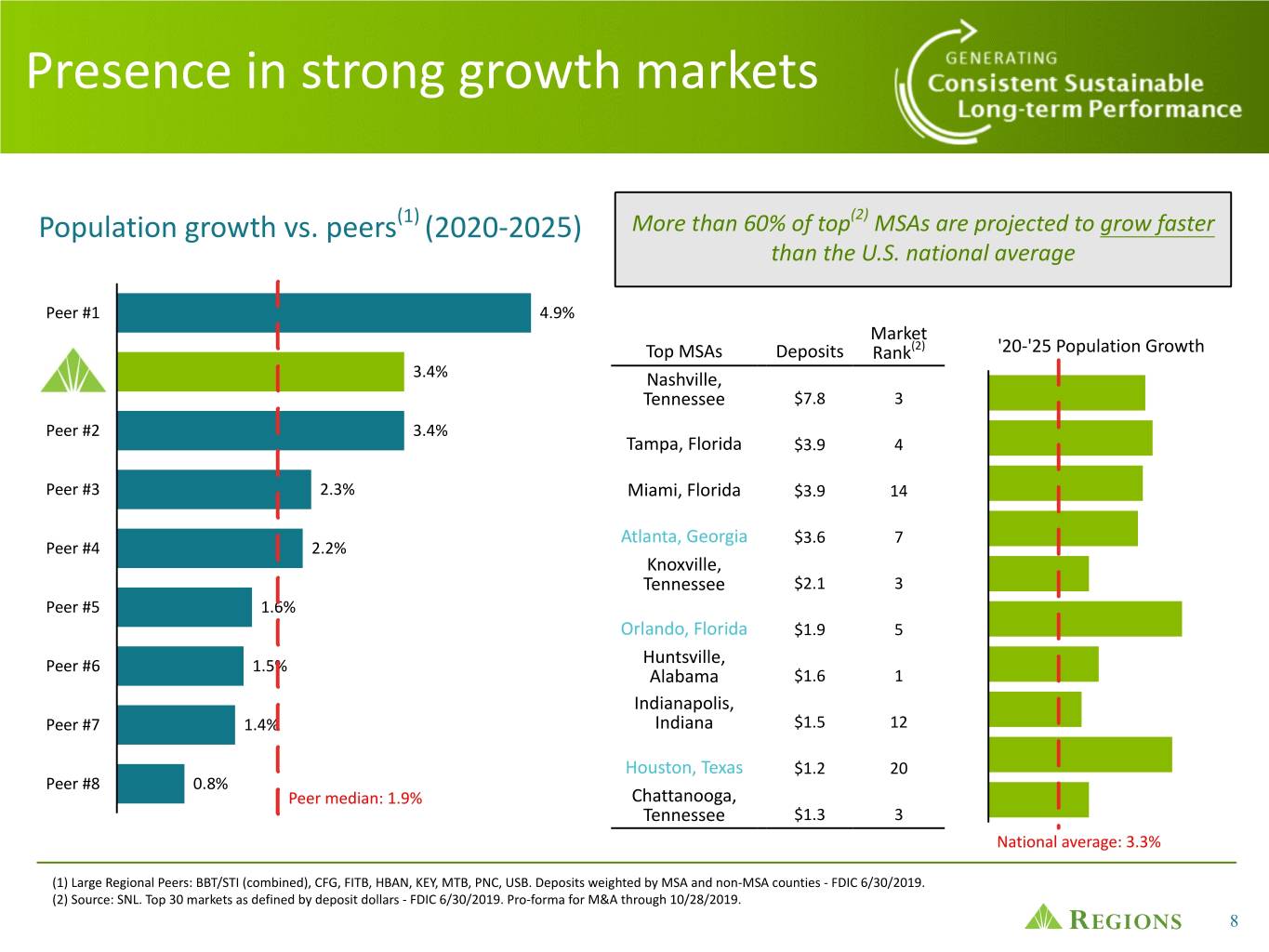
Presence in strong growth markets Population growth vs. peers(1) (2020-2025) More than 60% of top(2) MSAs are projected to grow faster than the U.S. national average Peer #1 4.9% Market Top MSAs Deposits Rank(2) '20-'25 Population Growth RF 3.4% Nashville, Tennessee $7.8 3 Peer #2 3.4% Tampa, Florida $3.9 4 Peer #3 2.3% Miami, Florida $3.9 14 Atlanta, Georgia $3.6 7 Peer #4 2.2% Knoxville, Tennessee $2.1 3 Peer #5 1.6% Orlando, Florida $1.9 5 Peer #6 1.5% Huntsville, Alabama $1.6 1 Indianapolis, Peer #7 1.4% Indiana $1.5 12 Houston, Texas $1.2 20 Peer #8 0.8% Peer median: 1.9% Chattanooga, Tennessee $1.3 3 National average: 3.3% (1) Large Regional Peers: BBT/STI (combined), CFG, FITB, HBAN, KEY, MTB, PNC, USB. Deposits weighted by MSA and non-MSA counties - FDIC 6/30/2019. (2) Source: SNL. Top 30 markets as defined by deposit dollars - FDIC 6/30/2019. Pro-forma for M&A through 10/28/2019. 8
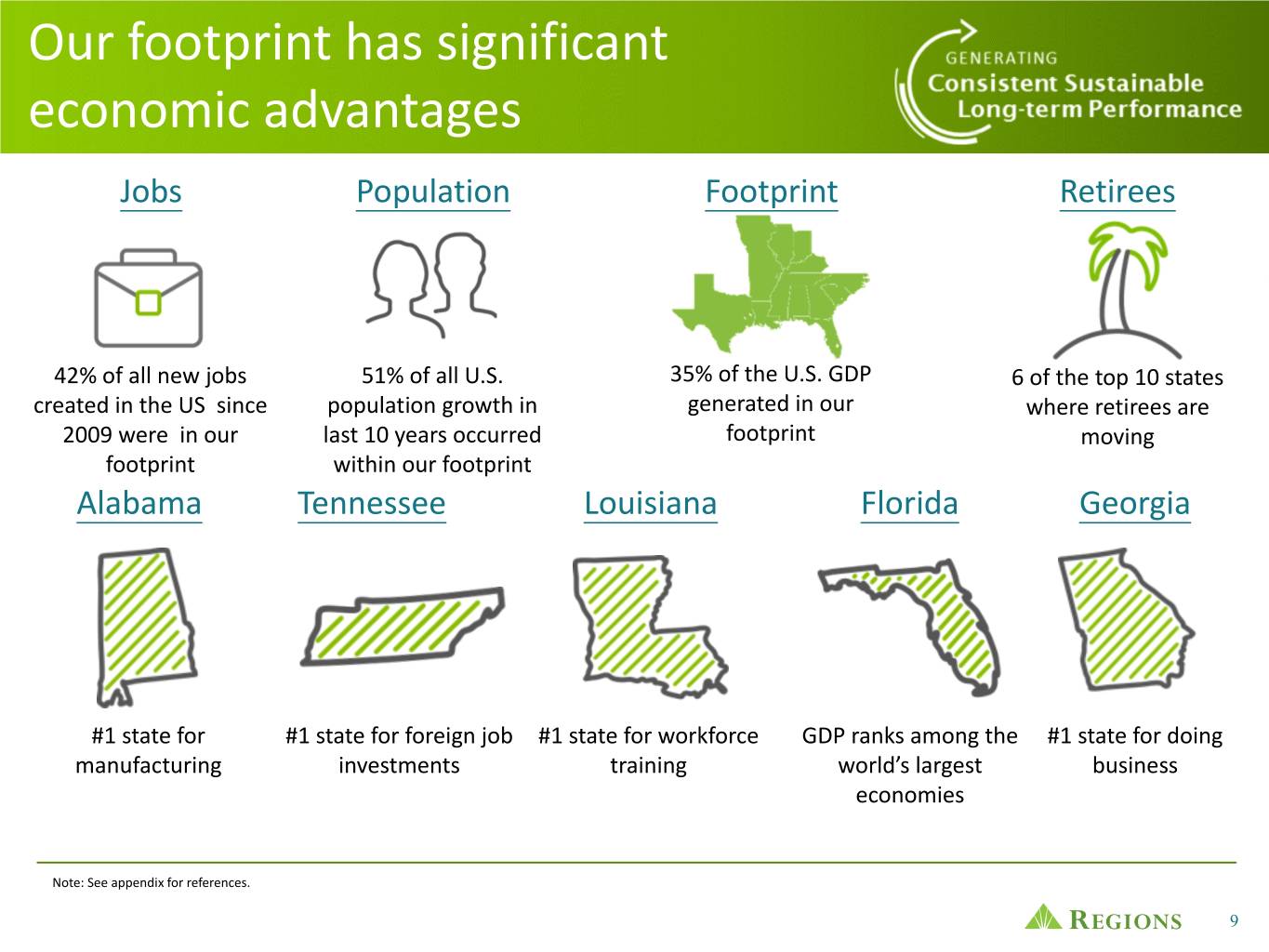
Our footprint has significant economic advantages Jobs Population Footprint Retirees 42% of all new jobs 51% of all U.S. 35% of the U.S. GDP 6 of the top 10 states created in the US since population growth in generated in our where retirees are 2009 were in our last 10 years occurred footprint moving footprint within our footprint Alabama Tennessee Louisiana Florida Georgia #1 state for #1 state for foreign job #1 state for workforce GDP ranks among the #1 state for doing manufacturing investments training world’s largest business economies Note: See appendix for references. 9

Regions receives top honors Regions Bank Named Top Customer Experience Leader Five Years Strong: Regions Bank Regions Bank Named 2018 Temkin Group Ranks in Large Retail Bank Again Named Gallup Great Javelin Trust in Banking Regions Bank Among Top Segments in Market Force Workplace Award Winner in Leader for Second Companies for Customer Information 2019 Retail 2109 Consecutive Year Experience Banking Study 10
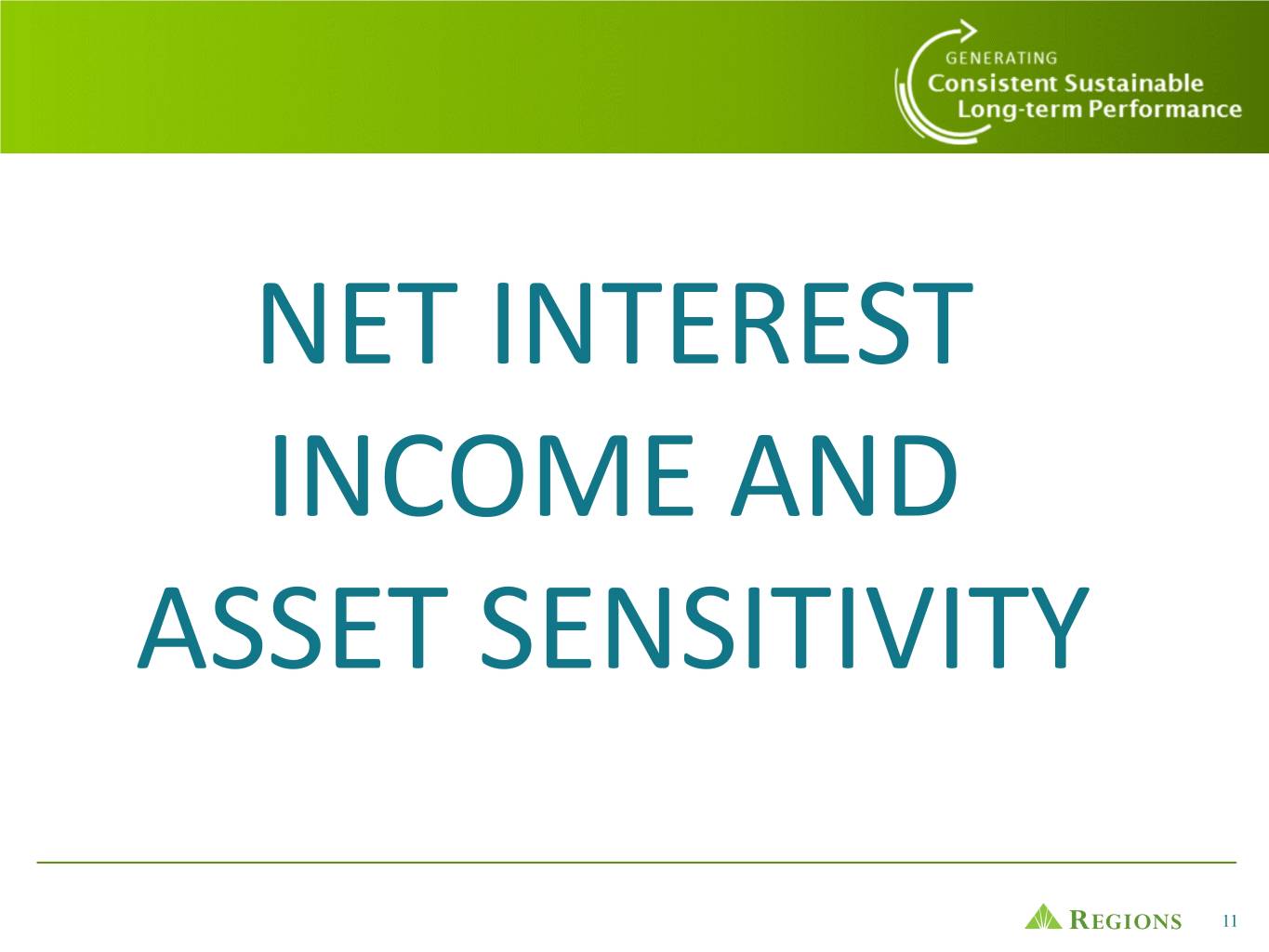
NET INTEREST INCOME AND ASSET SENSITIVITY 11

$956 $955 $950 956 955 950 Focused on earnings stability NII(1) and NIM NIM Performance vs Peers ($ in millions) 3.6 3.51% $955 $956 $950 3.5 3.46% 3.47% 3.44% 3.4 3.36% 3.3 3.25% 3.34% 3.34% 3.35% 3.47% 3.45% 3.44% 3.2 3.27% 3.24% RF 3.1 3.11% Peer Median2 3.0 2.9 6 7 7 7 7 8 8 8 8 9 9 9 3Q18 2Q19 3Q19 1 1 1 1 1 1 1 1 1 1 1 1 4 1 2 3 4 1 2 3 4 1 2 3 NII(1) NIM Q Q Q Q Q Q Q Q Q Q Q Q • NII, NIM, and overall profitability recently • Based on Oct and Dec 25bps Fed Funds cuts, we supported by: expect 4Q19 NIM to be in the high 3.30’s, then • Balance sheet optimization strategies, and expand to low 3.40’s in 1Q20 as forward starting hedges begin • Prudent deposit cost management • FY 2019 NII is expected to grow modestly over • Focused on earnings stability through the cycle; 2018 forward hedges reduce asset sensitivity in 1Q20 and beyond (1) Net interest income and other financing income on a fully taxable equivalent basis. (2) Source: company filings with the SEC; peers include BBT, CFG, CMA, FHN, FITB, HBAN, HWC, KEY, MTB, PNC, SNV, STI, USB, ZION. 12
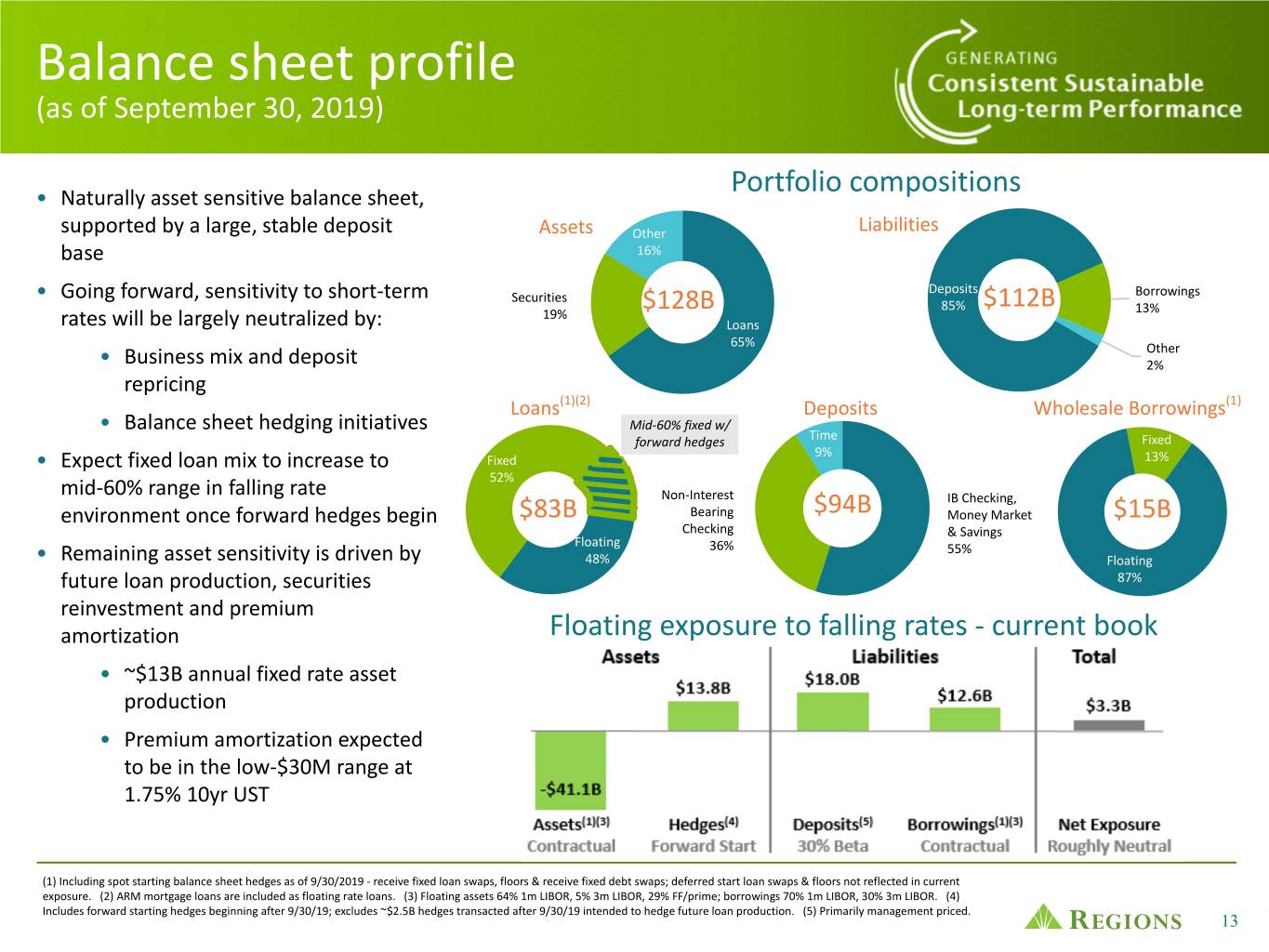
Balance sheet profile (as of September 30, 2019) Portfolio compositions • Naturally asset sensitive balance sheet, supported by a large, stable deposit Assets Other Liabilities base 16% Deposits • Going forward, sensitivity to short-term Securities Borrowings 85% $112B 19% $128B 13% rates will be largely neutralized by: Loans 65% Other • Business mix and deposit 2% repricing Loans(1)(2) Deposits Wholesale Borrowings(1) • Balance sheet hedging initiatives Mid-60% fixed w/ forward hedges Time Fixed 9% • Expect fixed loan mix to increase to Fixed 13% 52% mid-60% range in falling rate Non-Interest IB Checking, environment once forward hedges begin $83B Bearing $94B Money Market $15B Checking & Savings Floating 36% 55% • Remaining asset sensitivity is driven by 48% Floating future loan production, securities 87% reinvestment and premium amortization Floating exposure to falling rates - current book • ~$13B annual fixed rate asset production • Premium amortization expected to be in the low-$30M range at 1.75% 10yr UST (1) Including spot starting balance sheet hedges as of 9/30/2019 - receive fixed loan swaps, floors & receive fixed debt swaps; deferred start loan swaps & floors not reflected in current exposure. (2) ARM mortgage loans are included as floating rate loans. (3) Floating assets 64% 1m LIBOR, 5% 3m LIBOR, 29% FF/prime; borrowings 70% 1m LIBOR, 30% 3m LIBOR. (4) Includes forward starting hedges beginning after 9/30/19; excludes ~$2.5B hedges transacted after 9/30/19 intended to hedge future loan production. (5) Primarily management priced. 13
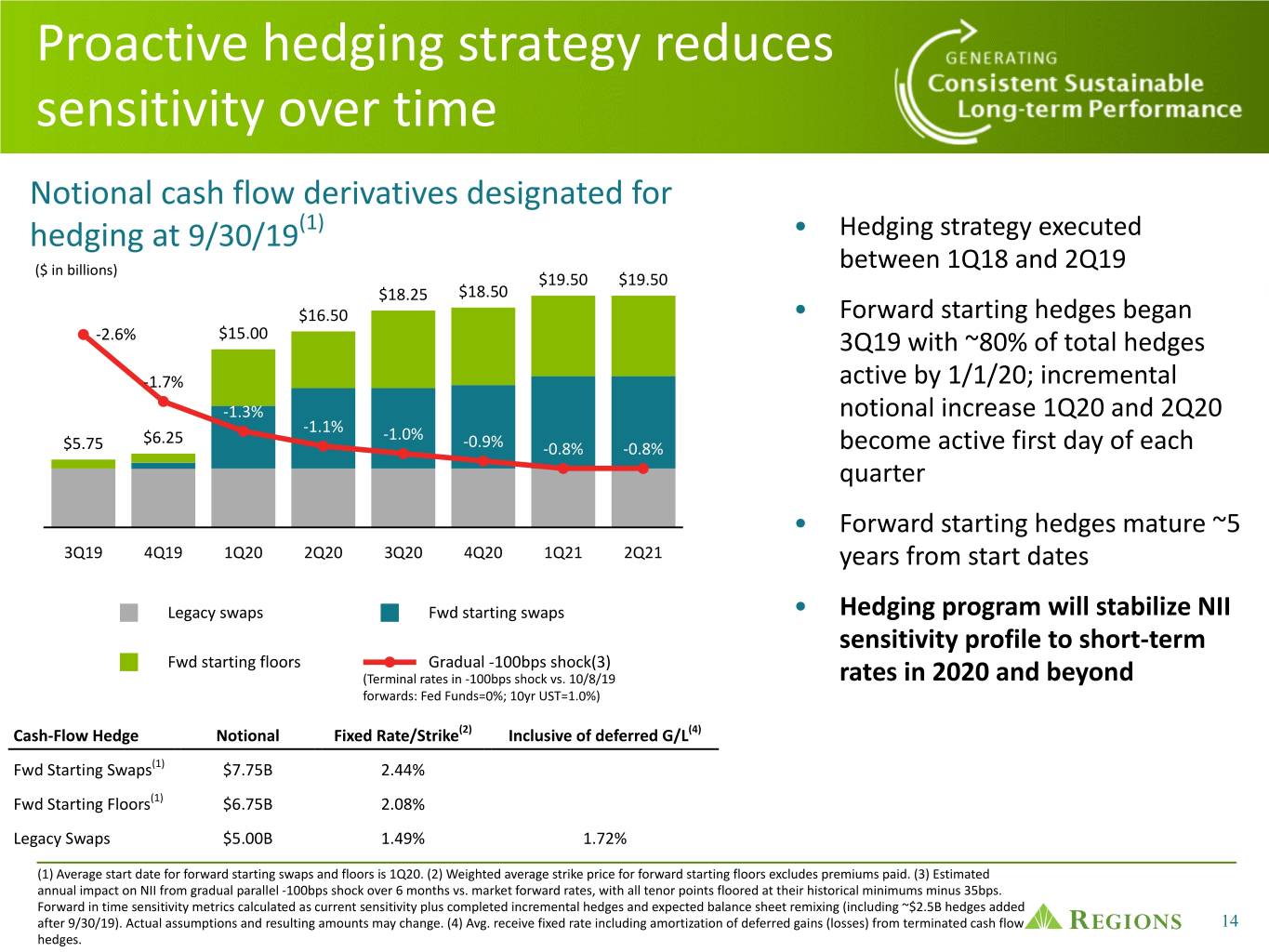
Proactive hedging strategy reduces sensitivity over time Notional cash flow derivatives designated for hedging at 9/30/19(1) • Hedging strategy executed ($ in billions) between 1Q18 and 2Q19 $19.50 $19.50 $18.25 $18.50 $16.50 • Forward starting hedges began -2.6% $15.00 3Q19 with ~80% of total hedges -1.7% active by 1/1/20; incremental -1.3% notional increase 1Q20 and 2Q20 -1.1% $6.25 -1.0% $5.75 -0.9% -0.8% -0.8% become active first day of each quarter • Forward starting hedges mature ~5 3Q19 4Q19 1Q20 2Q20 3Q20 4Q20 1Q21 2Q21 years from start dates Legacy swaps Fwd starting swaps • Hedging program will stabilize NII sensitivity profile to short-term Fwd starting floors Gradual -100bps shock(3) (Terminal rates in -100bps shock vs. 10/8/19 rates in 2020 and beyond forwards: Fed Funds=0%; 10yr UST=1.0%) Cash-Flow Hedge Notional Fixed Rate/Strike(2) Inclusive of deferred G/L(4) Fwd Starting Swaps(1) $7.75B 2.44% Fwd Starting Floors(1) $6.75B 2.08% Legacy Swaps $5.00B 1.49% 1.72% (1) Average start date for forward starting swaps and floors is 1Q20. (2) Weighted average strike price for forward starting floors excludes premiums paid. (3) Estimated annual impact on NII from gradual parallel -100bps shock over 6 months vs. market forward rates, with all tenor points floored at their historical minimums minus 35bps. Forward in time sensitivity metrics calculated as current sensitivity plus completed incremental hedges and expected balance sheet remixing (including ~$2.5B hedges added after 9/30/19). Actual assumptions and resulting amounts may change. (4) Avg. receive fixed rate including amortization of deferred gains (losses) from terminated cash flow 14 hedges.
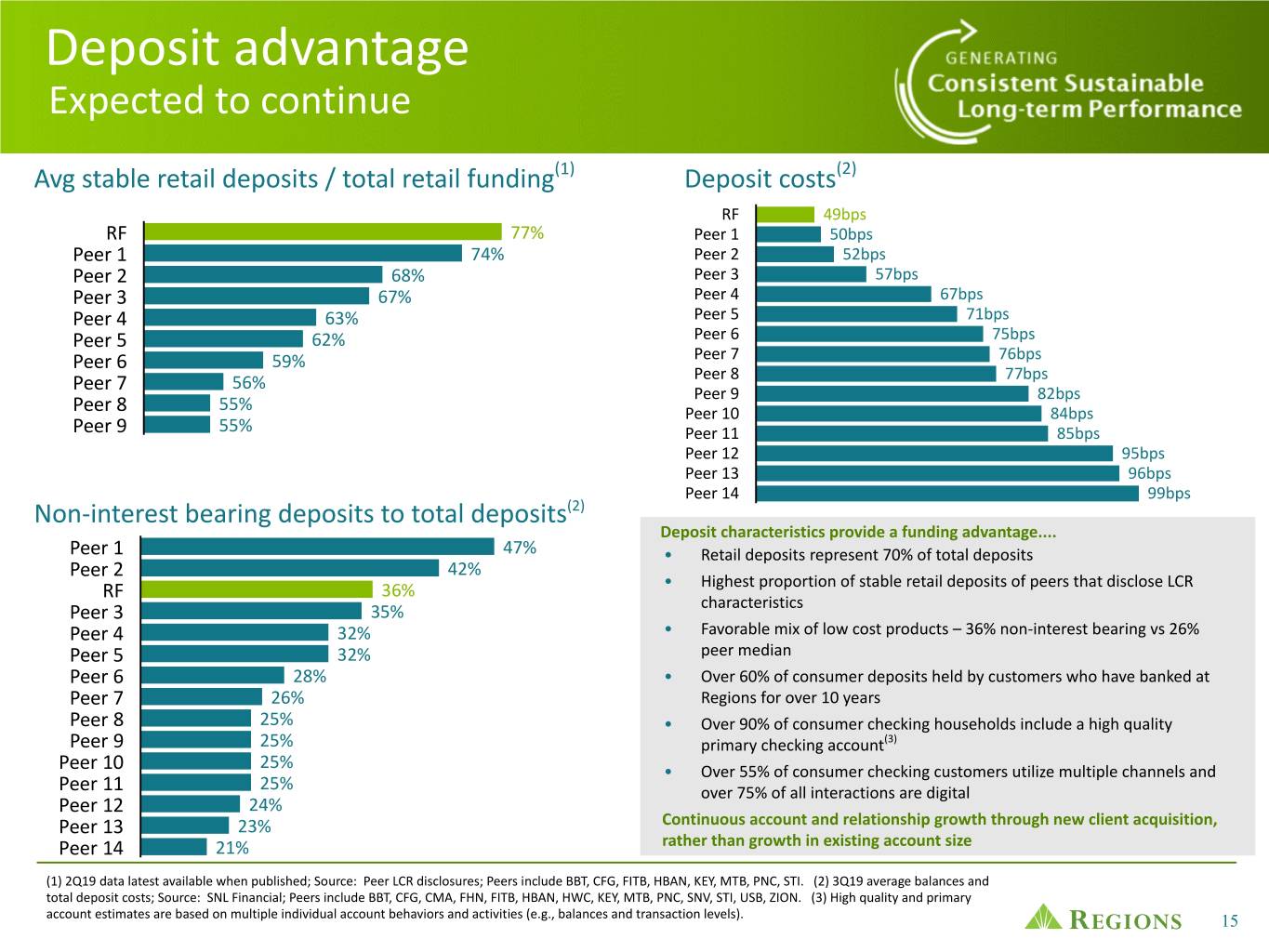
Deposit advantage Expected to continue Avg stable retail deposits / total retail funding(1) Deposit costs(2) RF 49bps RF 77% Peer 1 50bps Peer 1 74% Peer 2 52bps Peer 2 68% Peer 3 57bps Peer 3 67% Peer 4 67bps Peer 4 63% Peer 5 71bps Peer 5 62% Peer 6 75bps Peer 6 59% Peer 7 76bps 56% Peer 8 77bps Peer 7 Peer 9 82bps Peer 8 55% Peer 10 84bps Peer 9 55% Peer 11 85bps Peer 12 95bps Peer 13 96bps Peer 14 99bps Non-interest bearing deposits to total deposits(2) Deposit characteristics provide a funding advantage.... Peer 1 47% • Retail deposits represent 70% of total deposits Peer 2 42% RF 36% • Highest proportion of stable retail deposits of peers that disclose LCR Peer 3 35% characteristics Peer 4 32% • Favorable mix of low cost products – 36% non-interest bearing vs 26% Peer 5 32% peer median Peer 6 28% • Over 60% of consumer deposits held by customers who have banked at Peer 7 26% Regions for over 10 years Peer 8 25% • Over 90% of consumer checking households include a high quality Peer 9 25% primary checking account(3) Peer 10 25% • Over 55% of consumer checking customers utilize multiple channels and Peer 11 25% over 75% of all interactions are digital Peer 12 24% Peer 13 23% Continuous account and relationship growth through new client acquisition, Peer 14 21% rather than growth in existing account size (1) 2Q19 data latest available when published; Source: Peer LCR disclosures; Peers include BBT, CFG, FITB, HBAN, KEY, MTB, PNC, STI. (2) 3Q19 average balances and total deposit costs; Source: SNL Financial; Peers include BBT, CFG, CMA, FHN, FITB, HBAN, HWC, KEY, MTB, PNC, SNV, STI, USB, ZION. (3) High quality and primary account estimates are based on multiple individual account behaviors and activities (e.g., balances and transaction levels). 15
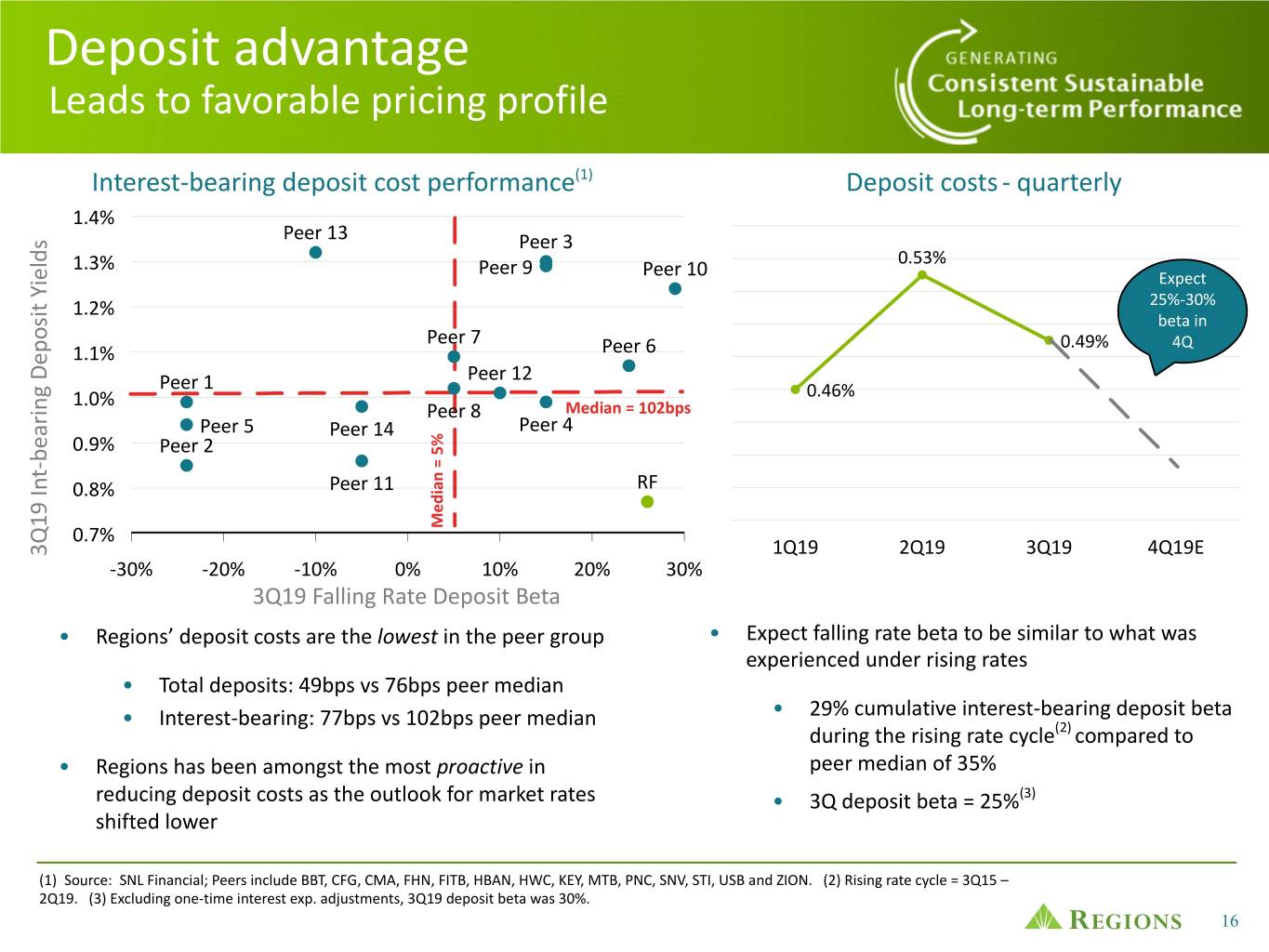
Deposit advantage Leads to favorable pricing profile Interest-bearing deposit cost performance(1) Deposit costs - quarterly 1.4% Peer 13 Peer 3 1.3% Peer 9 0.53% Peer 10 Expect 1.2% 25%-30% beta in Peer 7 0.49% 4Q 1.1% Peer 6 Peer 1 Peer 12 1.0% 0.46% Peer 8 Median = 102bps Peer 5 Peer 14 Peer 4 0.9% Peer 2 0.8% Peer 11 RF 0.7% Median = 5% 3Q19 Int-bearing Deposit Yields 3Q19 Int-bearing 1Q19 2Q19 3Q19 4Q19E -30% -20% -10% 0% 10% 20% 30% 3Q19 Falling Rate Deposit Beta • Regions’ deposit costs are the lowest in the peer group • Expect falling rate beta to be similar to what was experienced under rising rates • Total deposits: 49bps vs 76bps peer median • Interest-bearing: 77bps vs 102bps peer median • 29% cumulative interest-bearing deposit beta during the rising rate cycle(2) compared to • Regions has been amongst the most proactive in peer median of 35% reducing deposit costs as the outlook for market rates • 3Q deposit beta = 25%(3) shifted lower (1) Source: SNL Financial; Peers include BBT, CFG, CMA, FHN, FITB, HBAN, HWC, KEY, MTB, PNC, SNV, STI, USB and ZION. (2) Rising rate cycle = 3Q15 – 2Q19. (3) Excluding one-time interest exp. adjustments, 3Q19 deposit beta was 30%. 16
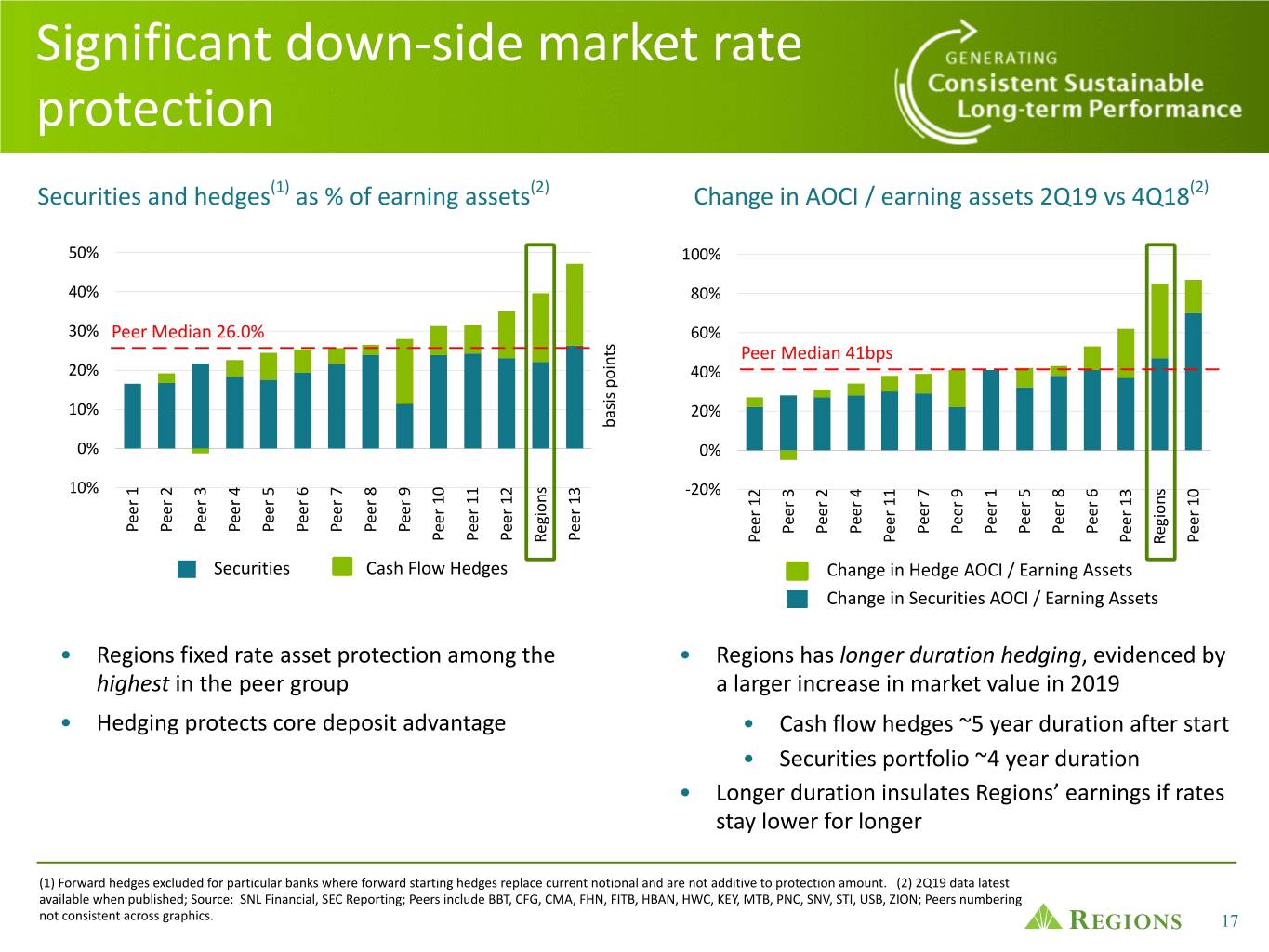
Significant down-side market rate protection Securities and hedges(1) as % of earning assets(2) Change in AOCI / earning assets 2Q19 vs 4Q18(2) 50% 100% 40% 80% 30% Peer Median 26.0% 60% Peer Median 41bps 20% 40% 10% 20% basis points 0% 0% s s 1 2 3 4 5 6 7 8 9 -10% 0 1 2 3 3 2 4 7 9 1 5 8 6 -20% 2 1 3 0 n n 1 1 1 1 r r r r r r r r r 1 1 1 1 r r r r r r r r r o o e e e e e e e e e r r r r i e e e e e e e e e r r r r i e e e e e e e e e e e e e g e e e e e e e e e e e e e g P P P P P P P P P e e e e e P P P P P P P P P e e e e e P P P P R P P P P R Securities Cash Flow Hedges Change in Hedge AOCI / Earning Assets Change in Securities AOCI / Earning Assets • Regions fixed rate asset protection among the • Regions has longer duration hedging, evidenced by highest in the peer group a larger increase in market value in 2019 • Hedging protects core deposit advantage • Cash flow hedges ~5 year duration after start • Securities portfolio ~4 year duration • Longer duration insulates Regions’ earnings if rates stay lower for longer (1) Forward hedges excluded for particular banks where forward starting hedges replace current notional and are not additive to protection amount. (2) 2Q19 data latest available when published; Source: SNL Financial, SEC Reporting; Peers include BBT, CFG, CMA, FHN, FITB, HBAN, HWC, KEY, MTB, PNC, SNV, STI, USB, ZION; Peers numbering not consistent across graphics. 17
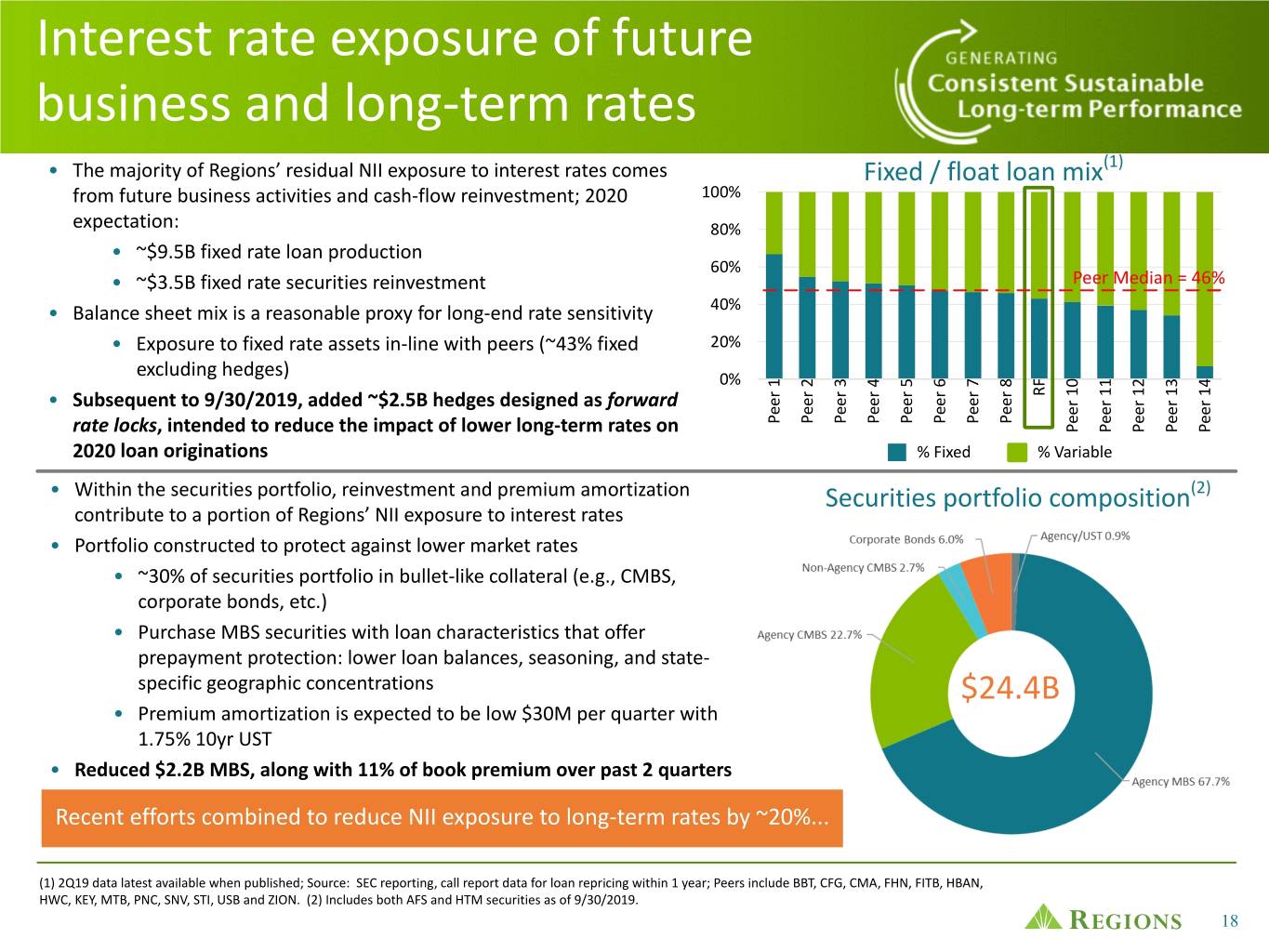
Interest rate exposure of future business and long-term rates • The majority of Regions’ residual NII exposure to interest rates comes Fixed / float loan mix(1) from future business activities and cash-flow reinvestment; 2020 100% expectation: 80% • ~$9.5B fixed rate loan production 60% • ~$3.5B fixed rate securities reinvestment Peer Median = 46% • Balance sheet mix is a reasonable proxy for long-end rate sensitivity 40% • Exposure to fixed rate assets in-line with peers (~43% fixed 20% excluding hedges) F 1 2 3 4 5 6 7 8 0% 0 1 2 3 4 R 1 1 1 1 1 r r r r r r r r e e e e e e e e • Subsequent to 9/30/2019, added ~$2.5B hedges designed as forward r r r r r e e e e e e e e e e e e e P P P P P P P P e e e e e rate locks, intended to reduce the impact of lower long-term rates on P P P P P 2020 loan originations % Fixed % Variable • Within the securities portfolio, reinvestment and premium amortization Securities portfolio composition(2) contribute to a portion of Regions’ NII exposure to interest rates • Portfolio constructed to protect against lower market rates • ~30% of securities portfolio in bullet-like collateral (e.g., CMBS, corporate bonds, etc.) • Purchase MBS securities with loan characteristics that offer prepayment protection: lower loan balances, seasoning, and state- specific geographic concentrations $24.4B • Premium amortization is expected to be low $30M per quarter with 1.75% 10yr UST • Reduced $2.2B MBS, along with 11% of book premium over past 2 quarters Recent efforts combined to reduce NII exposure to long-term rates by ~20%... (1) 2Q19 data latest available when published; Source: SEC reporting, call report data for loan repricing within 1 year; Peers include BBT, CFG, CMA, FHN, FITB, HBAN, HWC, KEY, MTB, PNC, SNV, STI, USB and ZION. (2) Includes both AFS and HTM securities as of 9/30/2019. 18

FEE INCOME AND EFFICIENCIES 19
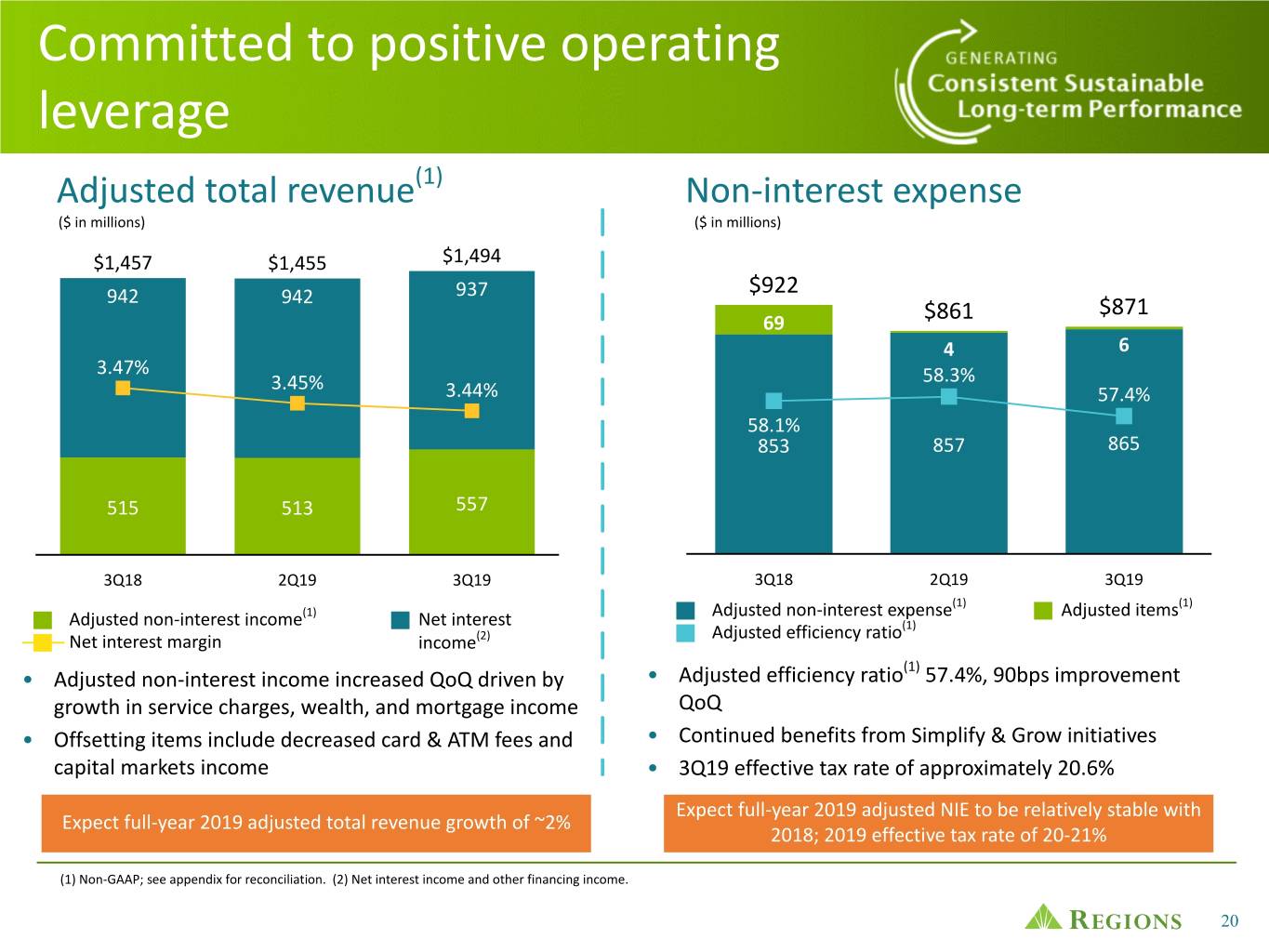
Committed to positive operating leverage Adjusted total revenue(1) Non-interest expense ($ in millions) ($ in millions) $1,457 $1,455 $1,494 937 $922 942 942 $871 69 $861 4 6 3.47% 3.45% 58.3% 3.44% 57.4% 58.1% 853 857 865 515 513 557 3Q18 2Q19 3Q19 3Q18 2Q19 3Q19 (1) (1) (1) Adjusted non-interest expense Adjusted items Adjusted non-interest income Net interest (1) (2) Adjusted efficiency ratio Net interest margin income (1) • Adjusted non-interest income increased QoQ driven by • Adjusted efficiency ratio 57.4%, 90bps improvement growth in service charges, wealth, and mortgage income QoQ • Offsetting items include decreased card & ATM fees and • Continued benefits from Simplify & Grow initiatives capital markets income • 3Q19 effective tax rate of approximately 20.6% Expect full-year 2019 adjusted NIE to be relatively stable with Expect full-year 2019 adjusted total revenue growth of ~2% 2018; 2019 effective tax rate of 20-21% (1) Non-GAAP; see appendix for reconciliation. (2) Net interest income and other financing income. 20
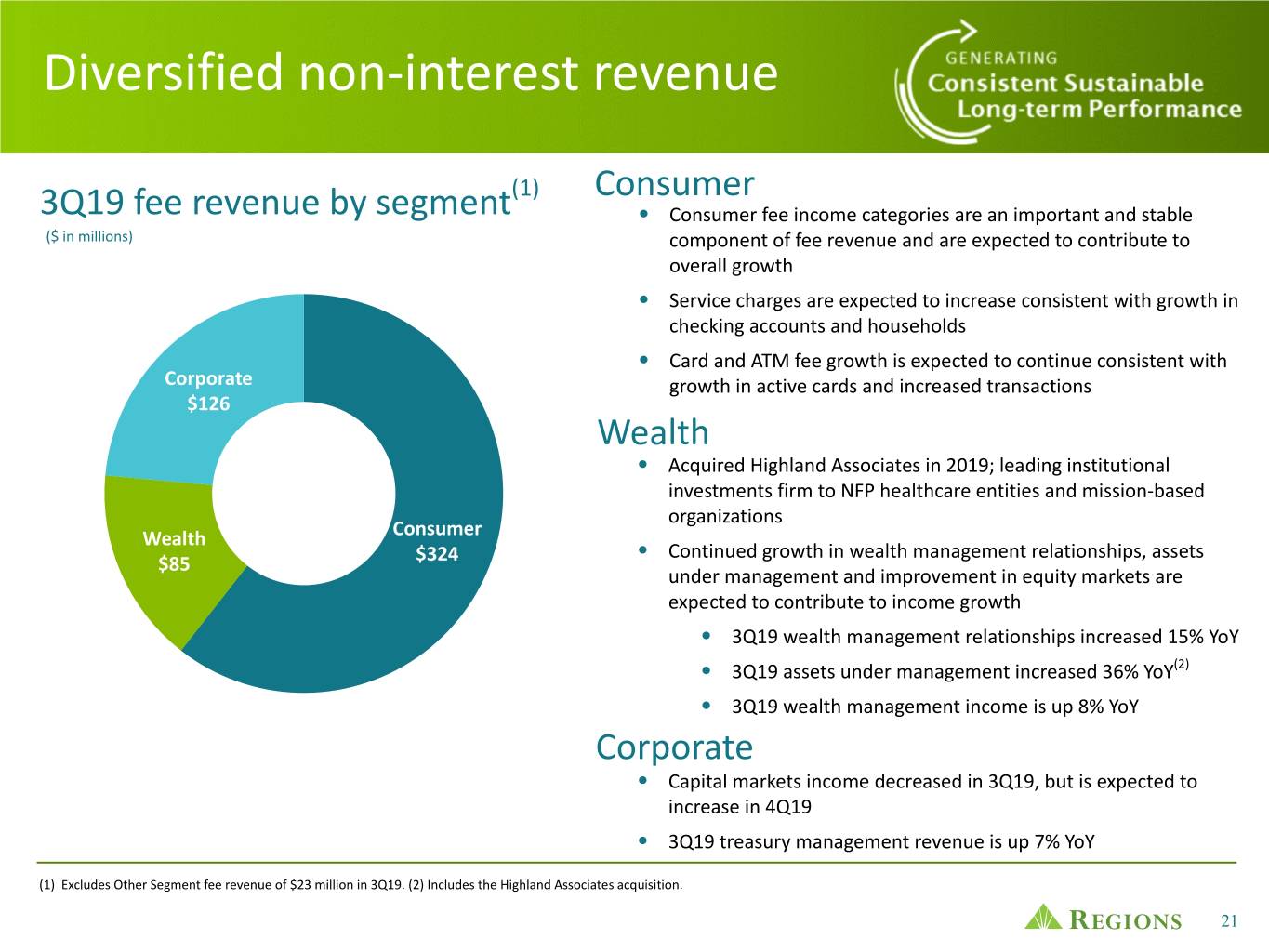
Diversified non-interest revenue (1) Consumer 3Q19 fee revenue by segment • Consumer fee income categories are an important and stable ($ in millions) component of fee revenue and are expected to contribute to overall growth • Service charges are expected to increase consistent with growth in checking accounts and households • Card and ATM fee growth is expected to continue consistent with Corporate growth in active cards and increased transactions $126 Wealth • Acquired Highland Associates in 2019; leading institutional investments firm to NFP healthcare entities and mission-based organizations Wealth Consumer • Continued growth in wealth management relationships, assets $85 $324 under management and improvement in equity markets are expected to contribute to income growth • 3Q19 wealth management relationships increased 15% YoY • 3Q19 assets under management increased 36% YoY(2) • 3Q19 wealth management income is up 8% YoY Corporate • Capital markets income decreased in 3Q19, but is expected to increase in 4Q19 • 3Q19 treasury management revenue is up 7% YoY (1) Excludes Other Segment fee revenue of $23 million in 3Q19. (2) Includes the Highland Associates acquisition. 21
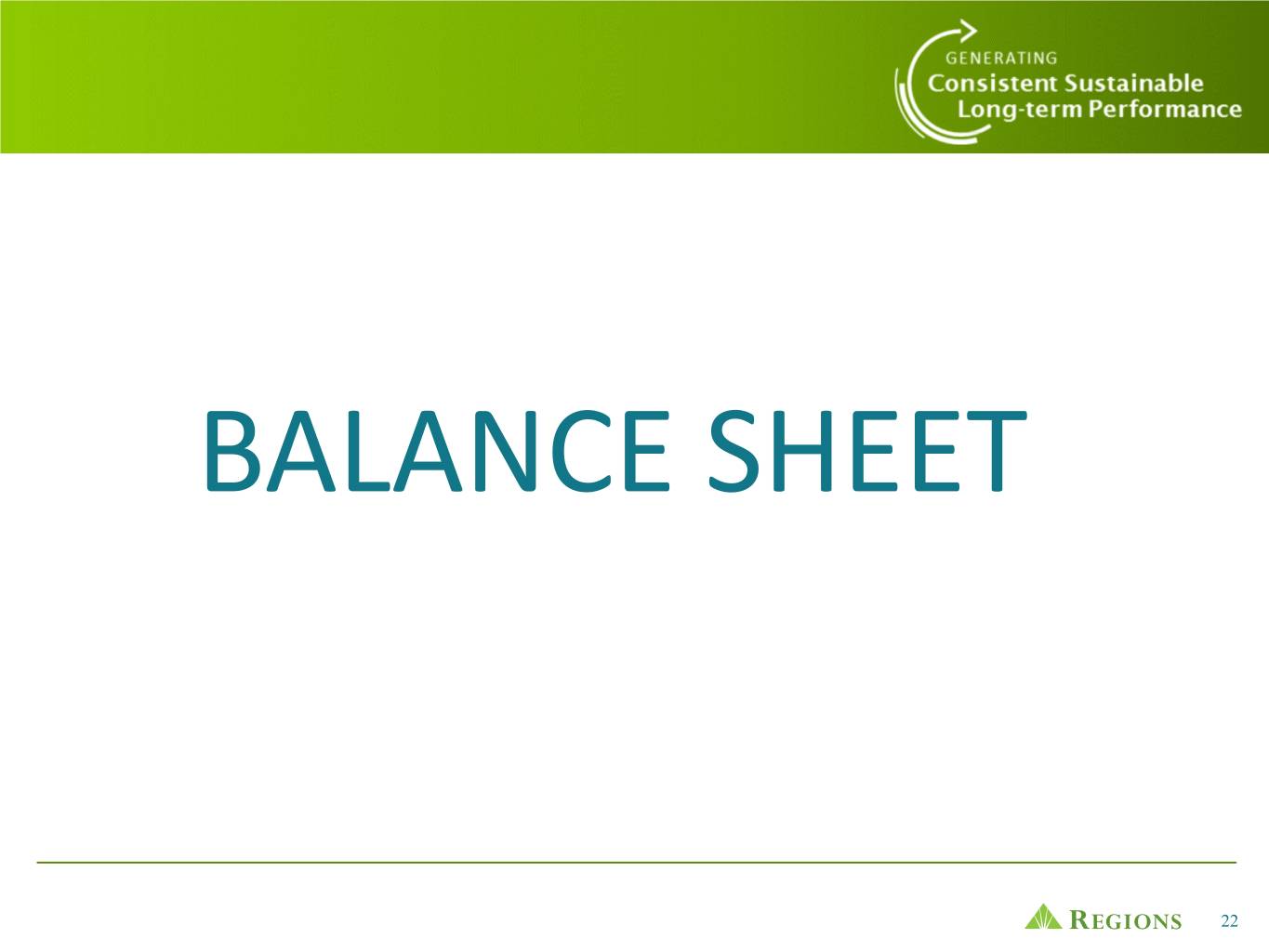
BALANCE SHEET 22

Focus on risk-adjusted returns Capital Optimization Investments Mortgage Corporate/Commercial Mortgage Servicing Rights • Sold ~$1.3B of primarily under- • ~$102B of loan exposures • ~$17B in MSR bulk purchases since performing loans in recent years have been reviewed in depth beginning of 2016 by Capital Commitments • Began flow-deal arrangement in 2016, Indirect Working Group since 2016 resulting in ~$2.3B in MSR purchases • ~$6.4B of strategic runoff • Continuous improvements to • Third-party originated auto runoff of risk ratings & capital Corporate Banking ~$2.0B starting in 2016 allocation models • First Sterling, acquired in 2016, a leading • Dealer Financial Services auto national syndicator of investment funds portfolio runoff of ~$2.4B starting in Regions Insurance Group benefiting from Low Income Housing Tax early 2019 • Sold in July 2018 resulting Credits • GSKY unsecured consumer loans in ~$300M of capital runoff of ~$2.0B starting in Dec redeployed to shareholders Wealth Management 2019 • Highland Associates, acquired in 2019, a leading institutional investment firm to NFP Regions has made challenging decisions in order to healthcare entities and mission-based orgs. optimize the balance sheet: improving capital Talent and Technology allocation by divesting low risk-adjusted return • Expansion in priority growth markets businesses, all while making revenue enhancing • Corporate bankers, MLOs, Wealth Advisors • System enhancements and new technology investments. • Data and analytics 23
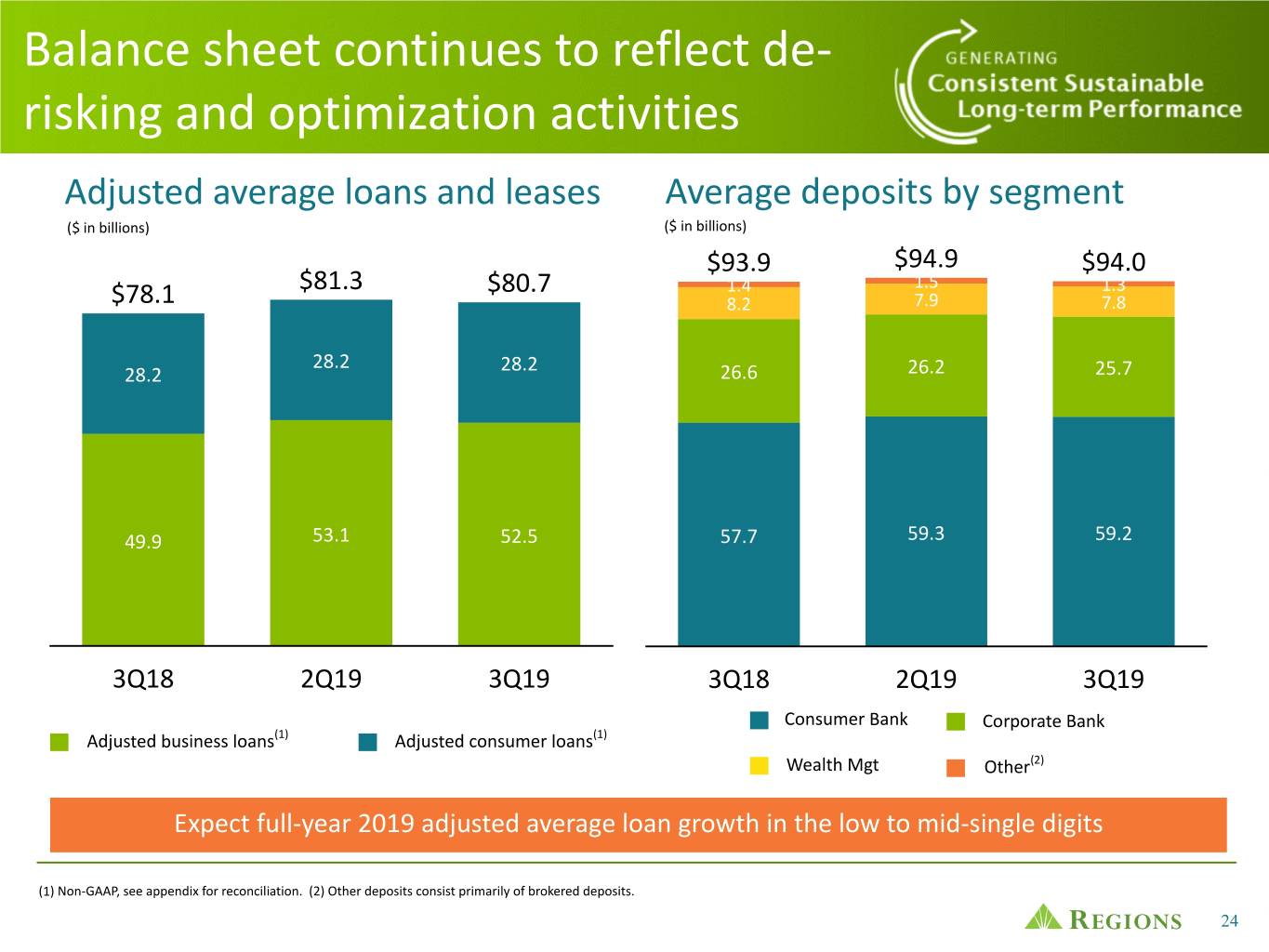
Balance sheet continues to reflect de- risking and optimization activities Adjusted average loans and leases Average deposits by segment ($ in billions) ($ in billions) $93.9 $94.9 $94.0 $81.3 $80.7 1.4 1.5 1.3 $78.1 8.2 7.9 7.8 28.2 28.2 28.2 26.6 26.2 25.7 49.9 53.1 52.5 57.7 59.3 59.2 3Q18 2Q19 3Q19 3Q18 2Q19 3Q19 Consumer Bank Corporate Bank Adjusted business loans(1) Adjusted consumer loans(1) Wealth Mgt Other(2) Expect full-year 2019 adjusted average loan growth in the low to mid-single digits (1) Non-GAAP, see appendix for reconciliation. (2) Other deposits consist primarily of brokered deposits. 24
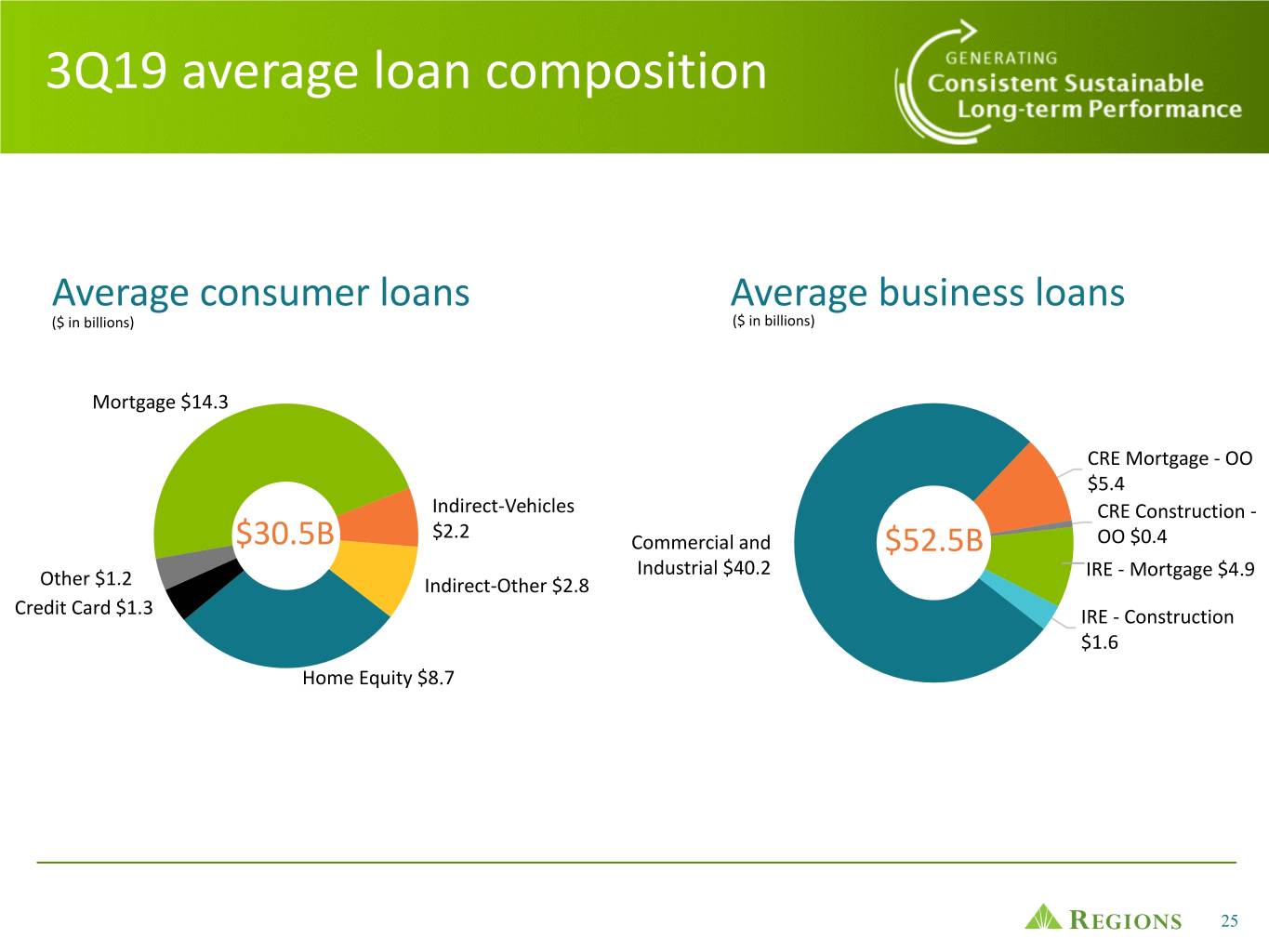
3Q19 average loan composition Average consumer loans Average business loans ($ in billions) ($ in billions) Mortgage $14.3 CRE Mortgage - OO $5.4 Indirect-Vehicles CRE Construction - $2.2 $30.5B Commercial and $52.5B OO $0.4 Industrial $40.2 IRE - Mortgage $4.9 Other $1.2 Indirect-Other $2.8 Credit Card $1.3 IRE - Construction $1.6 Home Equity $8.7 25
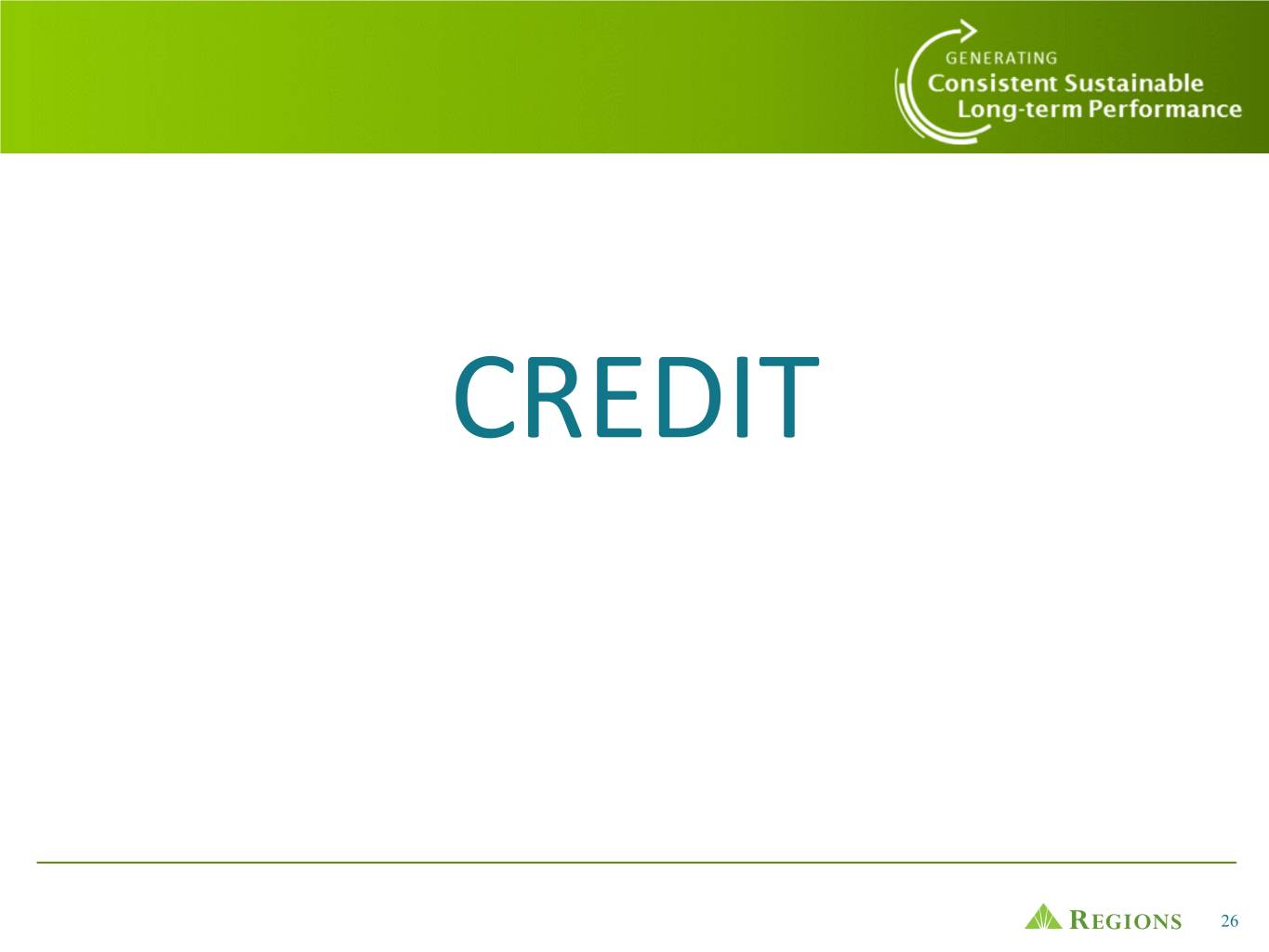
CREDIT 26

Diversification through comprehensive concentration framework Industry Concentrations Geographic Concentrations • Risk Appetite driven approach • Market scorecards are product Concentration Risk Framework specific • Multi-tiered hierarchy e.g., Consumer vs. Investor Real Estate 9 sectors, 24 industries, 96 sub-industries • Concentration limits at state and • Dynamic limits tied to capital metro levels • Emerging risk research drives • Market and product trends drive origination strategy origination strategies Product Concentrations Single-Name Concentrations • Examples: Investor Real Estate, • Risk-based limits define direct and Technology, Defense, Utilities total exposure Sub-limits constrain highest risk segments Limited hold limit exceptions • Specialized bankers, underwriters • 3Q19 outstanding balances of top and credit professionals 20 relationships < 12% of TCE • Large exposures have strong credit profile 27

Significant expansion of portfolio risk indicators Portfolio Performance Metrics Early Warning Indicators Regions maintains a robust library of over 150 quantitative and qualitative Metrics are cascaded to ensure measures accountability and permit strategic allocation of risk capacity Capital Market Loss / Default Macroeconomic Stress Index Indicator Stress Indicator 28

Asset quality performing as expected Criticized business loans NPLs and coverage ratio ($ in millions) ($ in millions) $2,319 $539 $533 $2,029 $2,124 $462 840 1,048 1,158 188% 1,479 156% 160% 981 966 53 3Q18 2Q19 3Q19 3Q18 2Q19 3Q19 Classified Special Mention NPLs - excluding LHFS Coverage ratio Net charge-offs and ratio • 3Q19 NCOs unchanged at 0.44% of avg. loans, YTD ($ in millions) NCOs 0.42% - within full-year expectations $92 $92 • ALLL represented 1.05% of total loans and 188% of $82 37 30 NPLs 30 0.44% 0.44% 0.40% • Credit metrics include results of most recent SNC exam 62 52 55 • Expect allowance for credit losses may increase by $500M - $600M(1) upon adoption of CECL 3Q18 2Q19 3Q19 Consumer net Commercial net Net charge-offs rate Expect full-year 2019 net charge-offs of 40 - 50 bps charge-offs charge-offs (1) Based on loan exposure balances and Regions' internally developed macroeconomic forecast as of 6/30/2019. 29
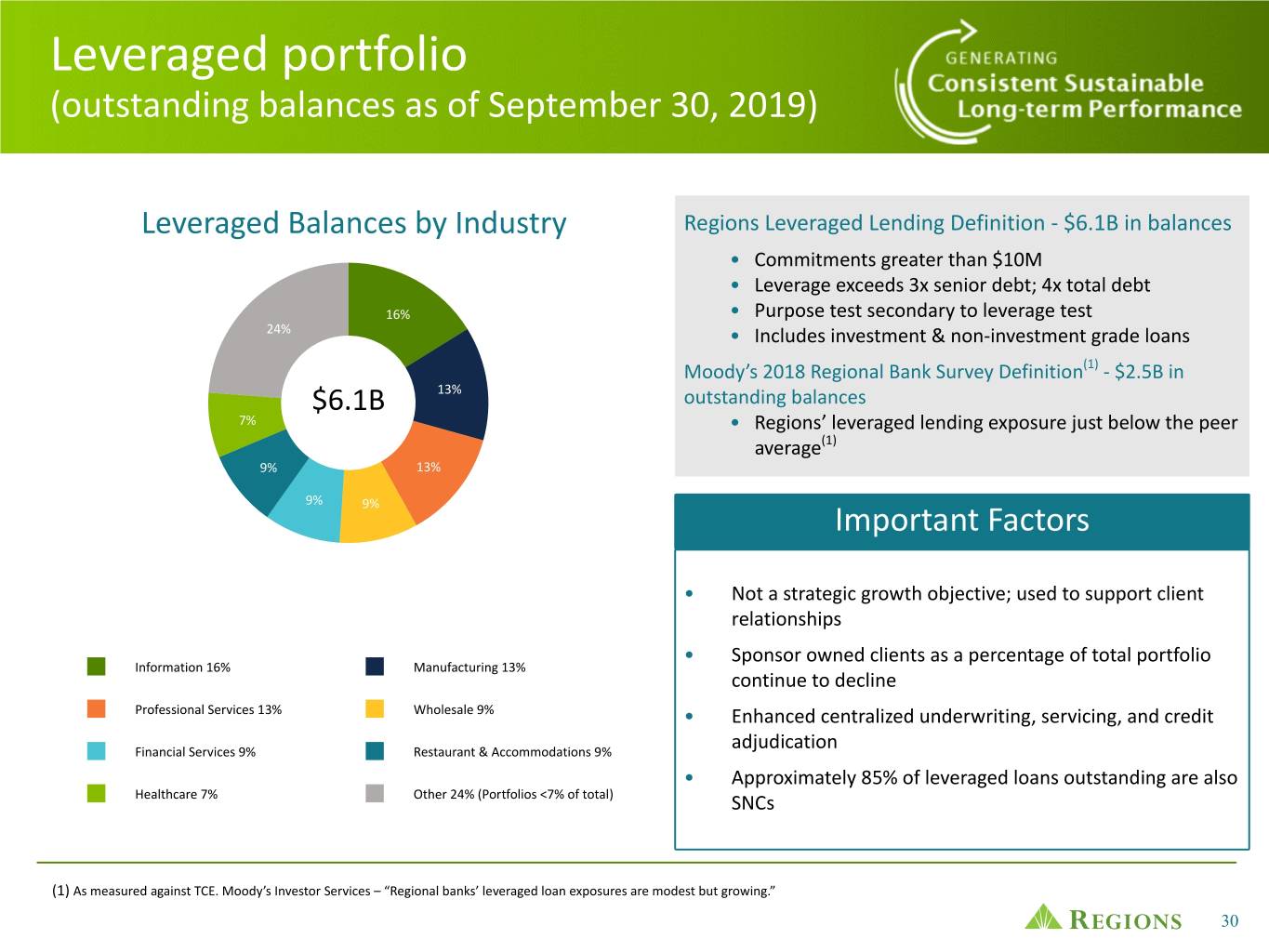
Leveraged portfolio (outstanding balances as of September 30, 2019) Leveraged Balances by Industry Regions Leveraged Lending Definition - $6.1B in balances • Commitments greater than $10M • Leverage exceeds 3x senior debt; 4x total debt 16% • Purpose test secondary to leverage test 24% • Includes investment & non-investment grade loans Moody’s 2018 Regional Bank Survey Definition(1) - $2.5B in $6.1B 13% outstanding balances 7% • Regions’ leveraged lending exposure just below the peer average(1) 9% 13% 9% 9% Important Factors • Not a strategic growth objective; used to support client relationships • Sponsor owned clients as a percentage of total portfolio Information 16% Manufacturing 13% continue to decline Professional Services 13% Wholesale 9% • Enhanced centralized underwriting, servicing, and credit Financial Services 9% Restaurant & Accommodations 9% adjudication • Approximately 85% of leveraged loans outstanding are also Healthcare 7% Other 24% (Portfolios <7% of total) SNCs (1) As measured against TCE. Moody’s Investor Services – “Regional banks’ leveraged loan exposures are modest but growing.” 30

SNC portfolio (outstanding balances as of September 30, 2019) Shared National Credit Balances by Industry 10% Portfolio Characteristics 9% • Diverse industry mix 46% $20.6B 8% 7% • 41% of balances are investment grade 7% • 25% of balances are leveraged 6% 7% • 25% of balances are sponsor backed • 4% of SNC outstandings are criticized Financial Services 10% Energy 9% Manufacturing 8% Wholesale 7% Retail 7% Healthcare 7% Information 6% Other 46% (Portfolios <6% of total) 31
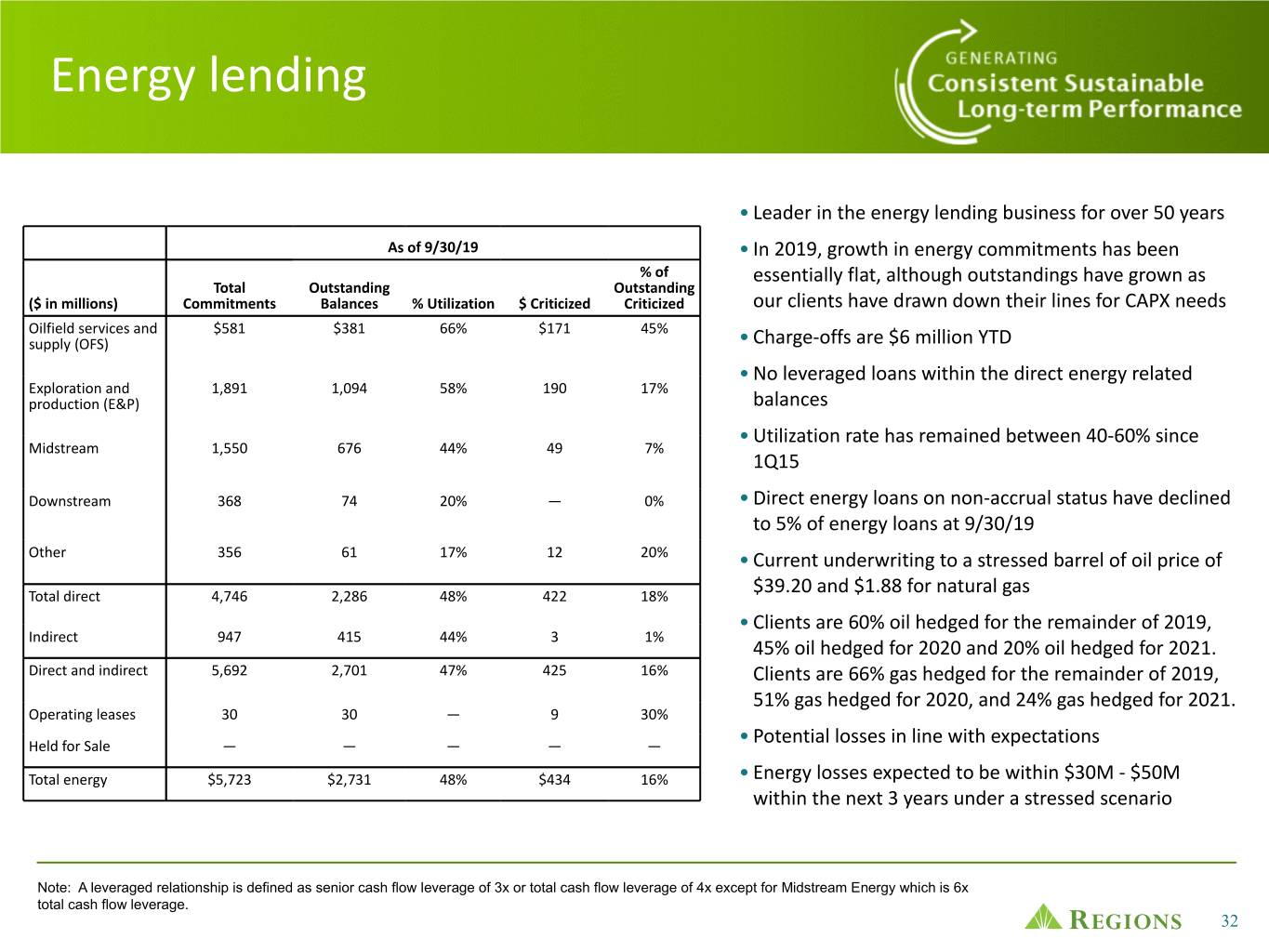
Energy lending • Leader in the energy lending business for over 50 years As of 9/30/19 • In 2019, growth in energy commitments has been % of essentially flat, although outstandings have grown as Total Outstanding Outstanding ($ in millions) Commitments Balances % Utilization $ Criticized Criticized our clients have drawn down their lines for CAPX needs Oilfield services and $581 $381 66% $171 45% supply (OFS) • Charge-offs are $6 million YTD 53 • No leveraged loans within the direct energy related Exploration and 1,891 1,094 58% 190 17% production (E&P) balances • Utilization rate has remained between 40-60% since Midstream 1,550 676 44% 49 7% 1Q15 Downstream 368 74 20% — 0% • Direct energy loans on non-accrual status have declined to 5% of energy loans at 9/30/19 Other 356 61 17% 12 20% • Current underwriting to a stressed barrel of oil price of Total direct 4,746 2,286 48% 422 18% $39.20 and $1.88 for natural gas • Clients are 60% oil hedged for the remainder of 2019, Indirect 947 415 44% 3 1% 45% oil hedged for 2020 and 20% oil hedged for 2021. Direct and indirect 5,692 2,701 47% 425 16% Clients are 66% gas hedged for the remainder of 2019, 51% gas hedged for 2020, and 24% gas hedged for 2021. Operating leases 30 30 — 9 30% Held for Sale — — — — — • Potential losses in line with expectations Total energy $5,723 $2,731 48% $434 16% • Energy losses expected to be within $30M - $50M within the next 3 years under a stressed scenario Note: A leveraged relationship is defined as senior cash flow leverage of 3x or total cash flow leverage of 4x except for Midstream Energy which is 6x total cash flow leverage. 32
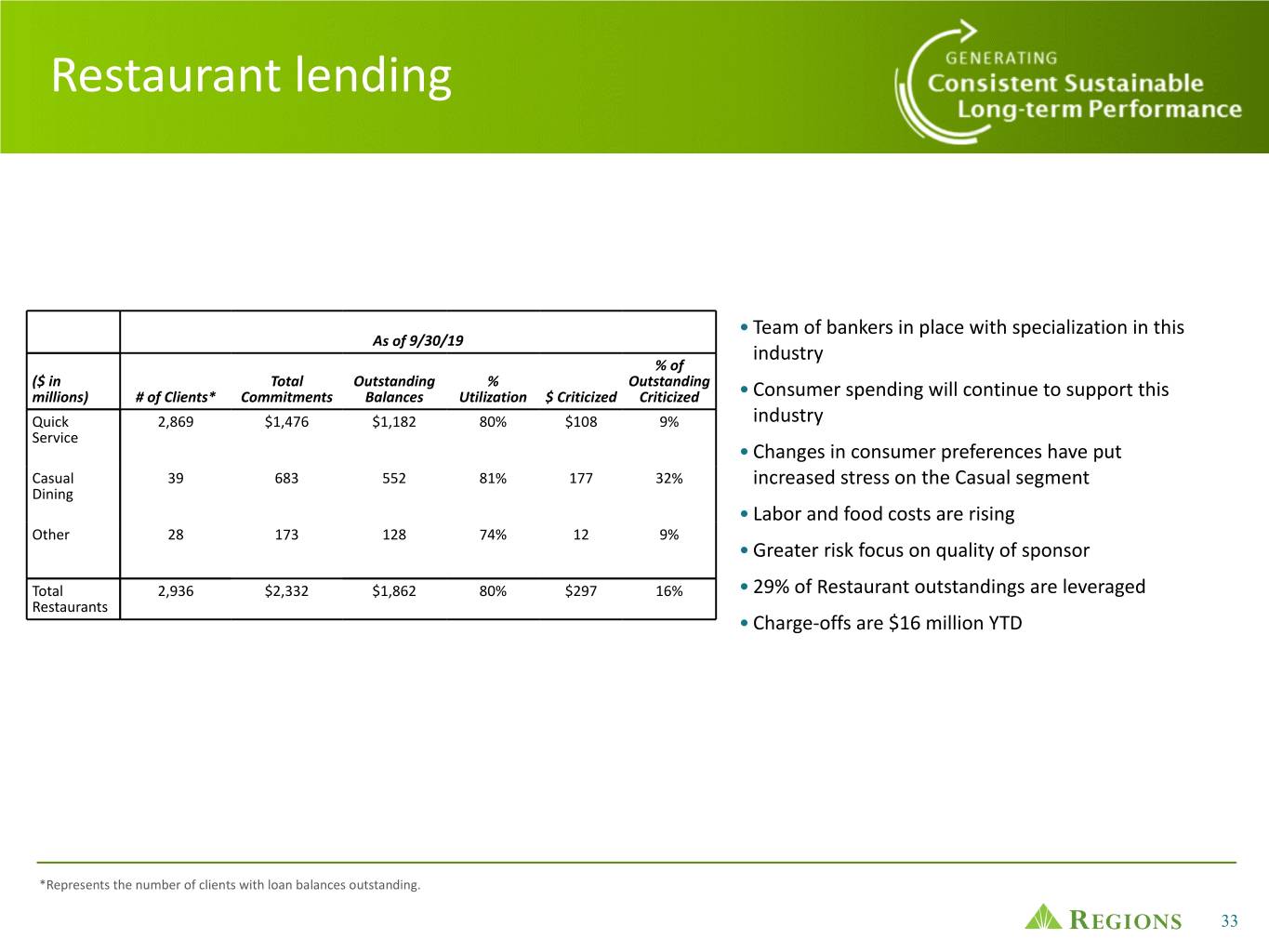
Restaurant lending • Team of bankers in place with specialization in this As of 9/30/19 industry 53 % of ($ in Total Outstanding % Outstanding millions) # of Clients* Commitments Balances Utilization $ Criticized Criticized • Consumer spending will continue to support this Quick 2,869 $1,476 $1,182 80% $108 9% industry Service • Changes in consumer preferences have put Casual 39 683 552 81% 177 32% increased stress on the Casual segment Dining • Labor and food costs are rising Other 28 173 128 74% 12 9% • Greater risk focus on quality of sponsor Total 2,936 $2,332 $1,862 80% $297 16% • 29% of Restaurant outstandings are leveraged Restaurants • Charge-offs are $16 million YTD *Represents the number of clients with loan balances outstanding. 33
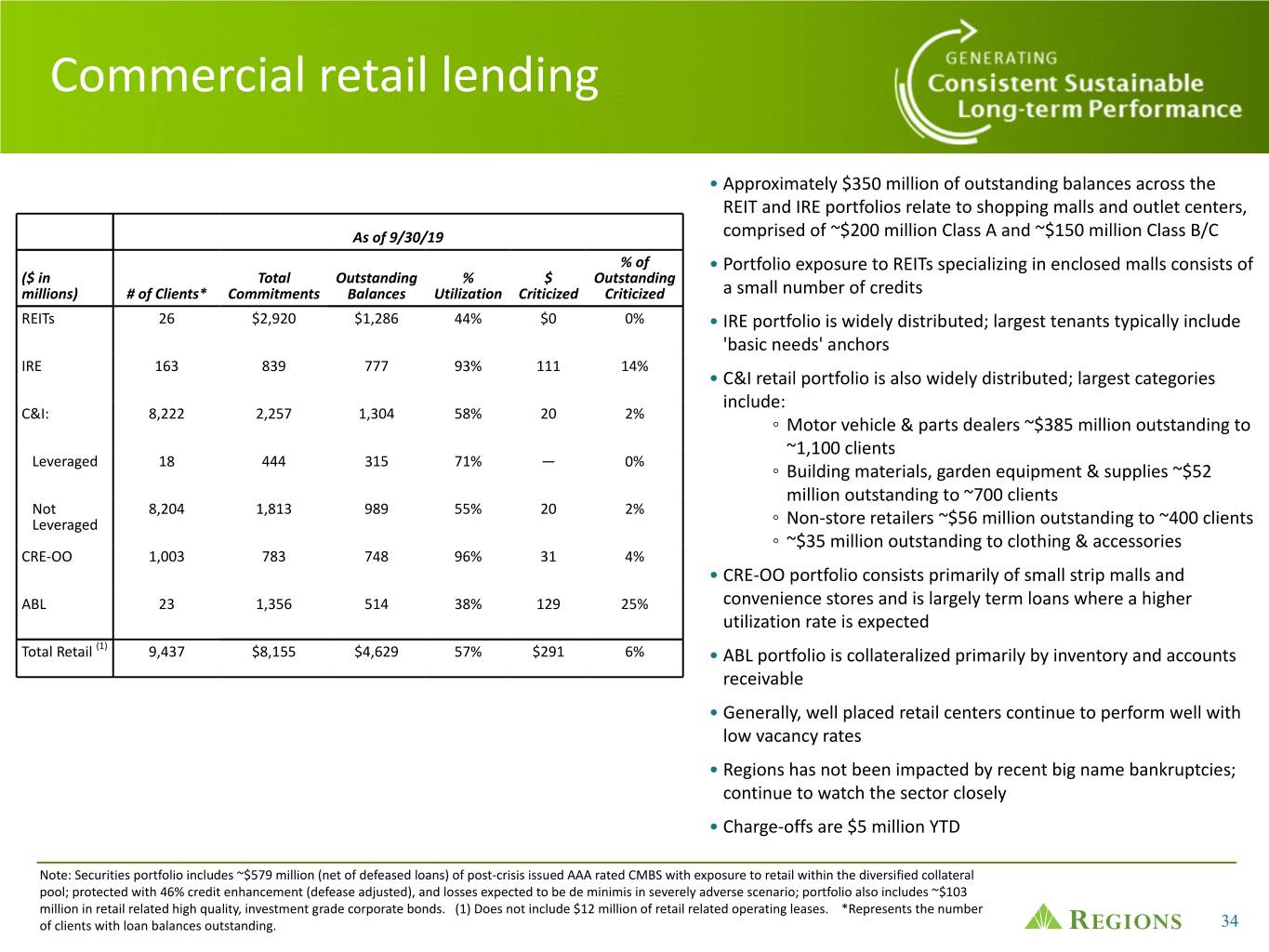
Commercial retail lending • Approximately $350 million of outstanding balances across the REIT and IRE portfolios relate to shopping malls and outlet centers, As of 9/30/19 comprised of ~$200 million Class A and ~$150 million Class B/C % of • Portfolio exposure to REITs specializing in enclosed malls consists of ($ in Total Outstanding % $ Outstanding millions) # of Clients* Commitments Balances Utilization Criticized Criticized a small number of credits REITs 26 $2,920 $1,286 44% $0 0% • IRE portfolio is widely distributed; largest tenants typically include 'basic needs' anchors IRE 163 839 777 53 93% 111 14% • C&I retail portfolio is also widely distributed; largest categories include: C&I: 8,222 2,257 1,304 58% 20 2% ◦ Motor vehicle & parts dealers ~$385 million outstanding to ~1,100 clients Leveraged 18 444 315 71% — 0% ◦ Building materials, garden equipment & supplies ~$52 million outstanding to ~700 clients Not 8,204 1,813 989 55% 20 2% Leveraged ◦ Non-store retailers ~$56 million outstanding to ~400 clients ◦ ~$35 million outstanding to clothing & accessories CRE-OO 1,003 783 748 96% 31 4% • CRE-OO portfolio consists primarily of small strip malls and ABL 23 1,356 514 38% 129 25% convenience stores and is largely term loans where a higher utilization rate is expected (1) Total Retail 9,437 $8,155 $4,629 57% $291 6% • ABL portfolio is collateralized primarily by inventory and accounts receivable • Generally, well placed retail centers continue to perform well with low vacancy rates • Regions has not been impacted by recent big name bankruptcies; continue to watch the sector closely • Charge-offs are $5 million YTD Note: Securities portfolio includes ~$579 million (net of defeased loans) of post-crisis issued AAA rated CMBS with exposure to retail within the diversified collateral pool; protected with 46% credit enhancement (defease adjusted), and losses expected to be de minimis in severely adverse scenario; portfolio also includes ~$103 million in retail related high quality, investment grade corporate bonds. (1) Does not include $12 million of retail related operating leases. *Represents the number of clients with loan balances outstanding. 34

Other portfolios Manufacturing - Consumer Balances by Industry Transportation Balances by Industry As of 9/30/19 As of 9/30/19 % of % of Total Outstanding Outstanding Total Outstanding Outstanding ($ in millions) Commitments Balances % Utilization $ Criticized Criticized ($ in millions) Commitments Balances % Utilization $ Criticized Criticized Food, Beverage $1,287 $626 49% $41 7% General Freight $908 $578 64% $23 4% & Tobacco 53 Trucking - Long Distance Wood & Related 605 385 64% 12 3% Support 412 282 68% — 0% Products Activities for Water Transportation Paper, Packaging 736 357 49% 21 6% & Printing Inland Water 379 279 74% — 0% Transportation Textile & 521 292 56% 44 15% Apparel Specialized 250 176 70% 6 3% Freight Trucking Computer & 417 204 49% 15 7% Electronic Couriers & 195 18 9% — 0% Products Messengers All Other 238 165 69% 9 5% Rail 165 157 95% — 0% Transportation Total $3,804 $2,029 53% $142 7% Manufacturing- Scheduled Air 145 127 88% — 0% Consumer Transportation Other 657 348 53% 17 5% •Manufacturing charge-offs are $7 million YTD •Transportation charge-offs are $5 million YTD Total $3,111 $1,965 63% $46 2% Transportation 35

Consumer lending portfolio statistics Residential Mortgage Home Equity Portfolio Statistics • Avg. origination FICO 768 • Avg. origination FICO 756 • Current LTV 59% • Current LTV 46% • 95% owner occupied • Only $409M of resets through 2021 • 66% of portfolio is 1st lien • Avg. loan size $40,567 Consumer Credit Card Consumer Third-Party Lending Other Consumer Unsecured Portfolio Statistics • Avg. origination FICO 736 • Avg. origination FICO 755 • Avg. origination FICO 737 • Avg. new line $5,639 • Avg. new line $16,250 • Avg. new loan $8,903 • Yield 13.1% • 66% home improvement loans • 3Q19 NCO 4.3% • Yield 9.2% • 3Q19 NCO 2.8% 36
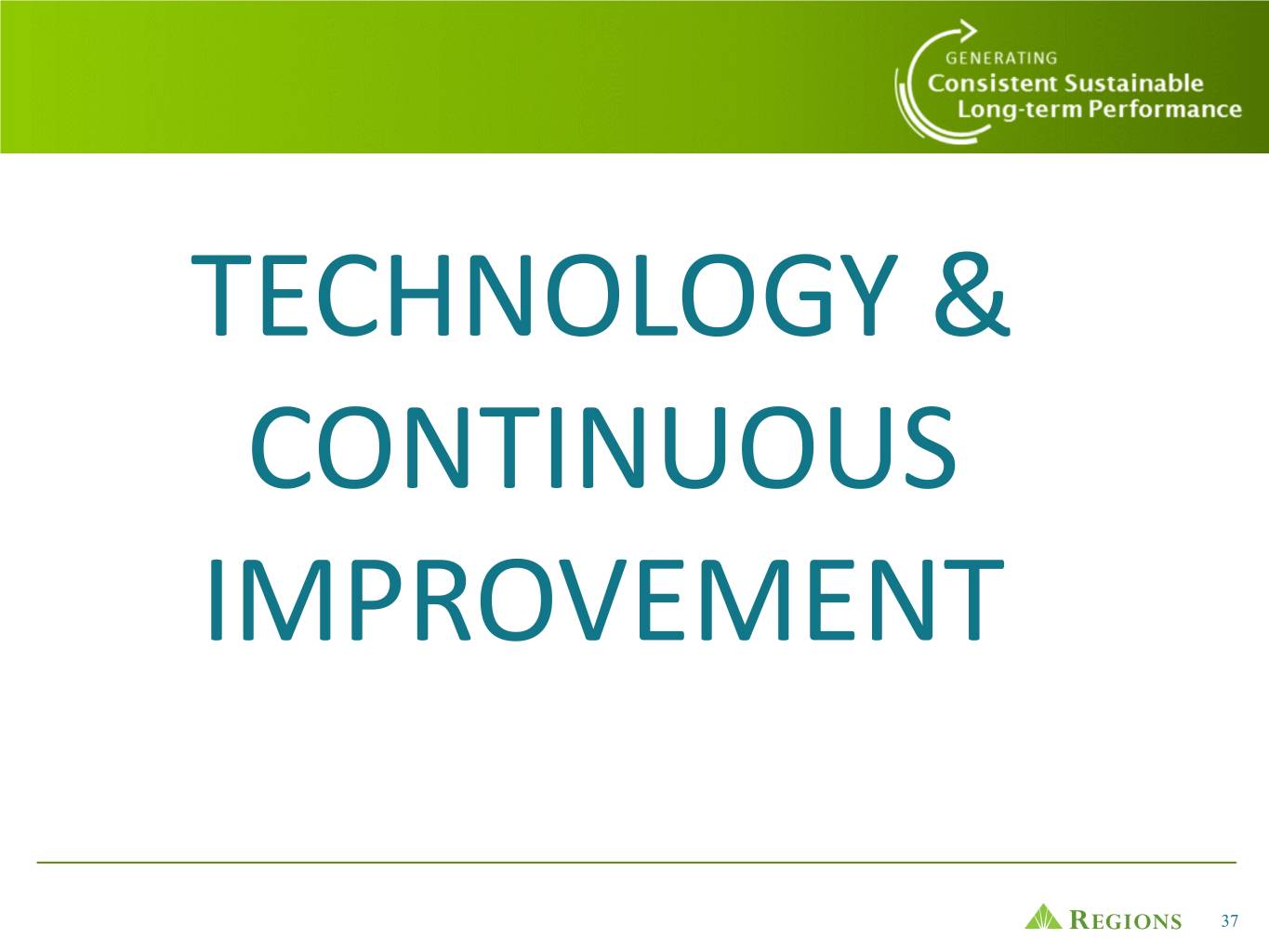
TECHNOLOGY & CONTINUOUS IMPROVEMENT 37

Focused technology strategy Innovation Customer Experiences • Continue deployment of AI • Mobile-first thinking • Strategic investments and • Continued digitization of customer partnerships experiences • Talent acquisition • Making banking easier • Develop processes that enable continuous agility Core Capabilities and Delivery Optimization Infrastructure • Enhancing speed to market • Investing in core as well as new • Utilizing Agile methodology technology investments • Leveraging data and analytics • Harnessing the power of the Cloud • Delivering robust cyber defenses 38
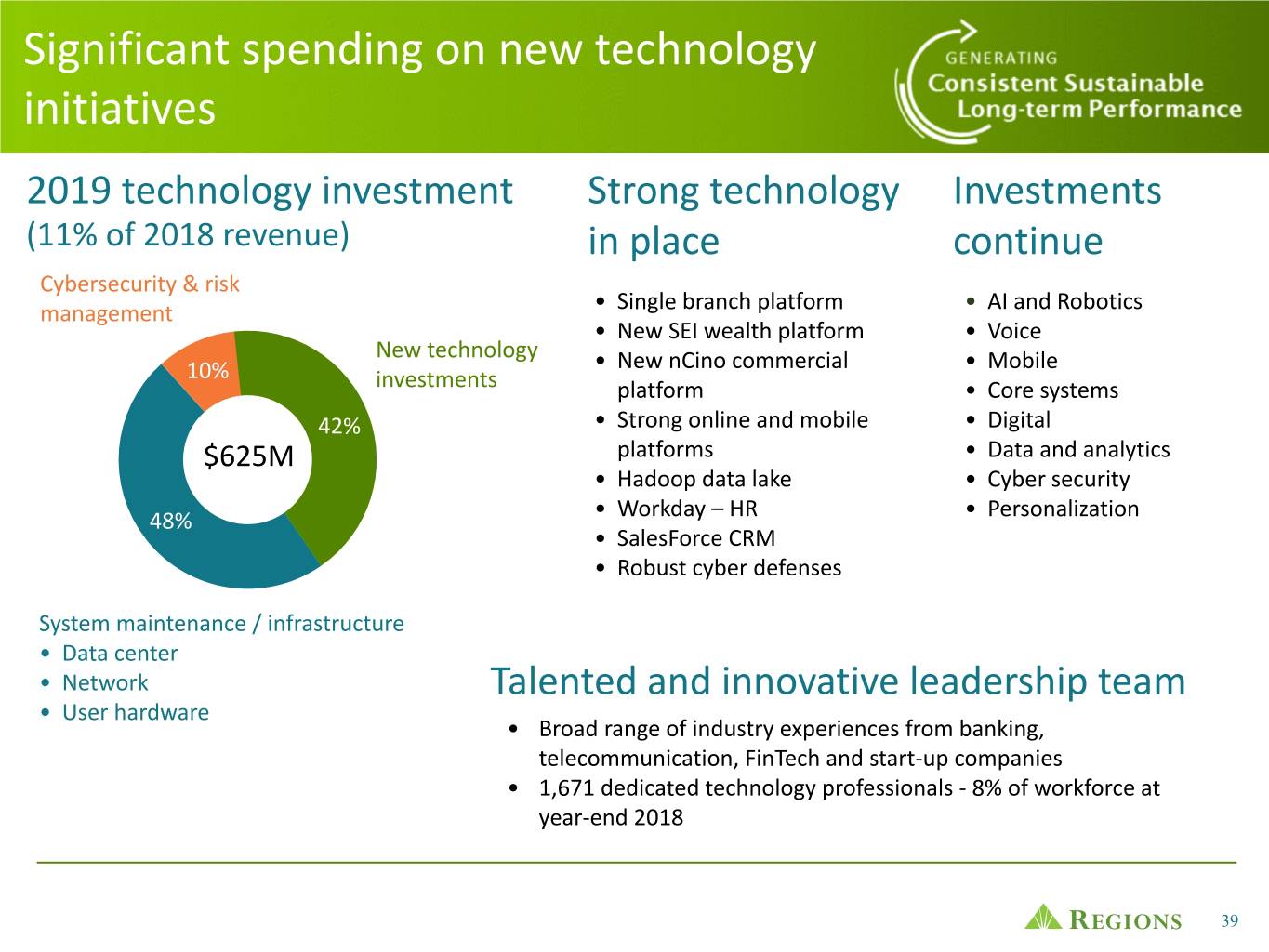
Significant spending on new technology initiatives 2019 technology investment Strong technology Investments (11% of 2018 revenue) in place continue Cybersecurity & risk management • Single branch platform • AI and Robotics • New SEI wealth platform • Voice New technology 10% • New nCino commercial • Mobile investments platform • Core systems 42% • Strong online and mobile • Digital $625M platforms • Data and analytics • Hadoop data lake • Cyber security • Workday – HR • Personalization 48% • SalesForce CRM • Robust cyber defenses System maintenance / infrastructure • Data center • Network Talented and innovative leadership team • User hardware • Broad range of industry experiences from banking, telecommunication, FinTech and start-up companies • 1,671 dedicated technology professionals - 8% of workforce at year-end 2018 39
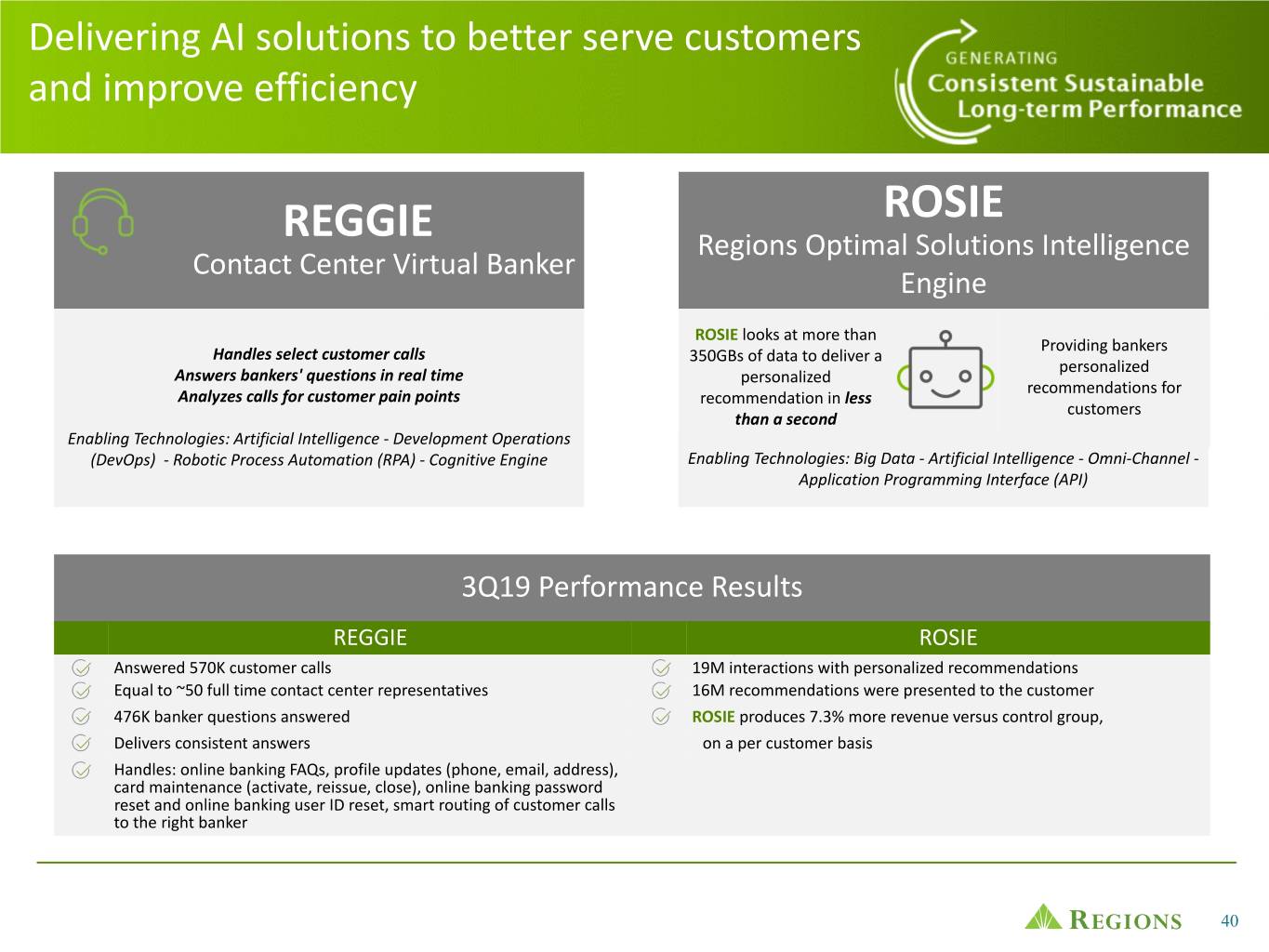
Delivering AI solutions to better serve customers and improve efficiency ROSIE REGGIE Regions Optimal Solutions Intelligence Contact Center Virtual Banker Engine ROSIE looks at more than Providing bankers Handles select customer calls 350GBs of data to deliver a personalized Answers bankers' questions in real time personalized recommendations for Analyzes calls for customer pain points recommendation in less customers than a second Enabling Technologies: Artificial Intelligence - Development Operations (DevOps) - Robotic Process Automation (RPA) - Cognitive Engine Enabling Technologies: Big Data - Artificial Intelligence - Omni-Channel - Application Programming Interface (API) 3Q19 Performance Results REGGIE ROSIE Answered 570K customer calls 19M interactions with personalized recommendations Equal to ~50 full time contact center representatives 16M recommendations were presented to the customer 476K banker questions answered ROSIE produces 7.3% more revenue versus control group, Delivers consistent answers on a per customer basis Handles: online banking FAQs, profile updates (phone, email, address), card maintenance (activate, reissue, close), online banking password reset and online banking user ID reset, smart routing of customer calls to the right banker 40
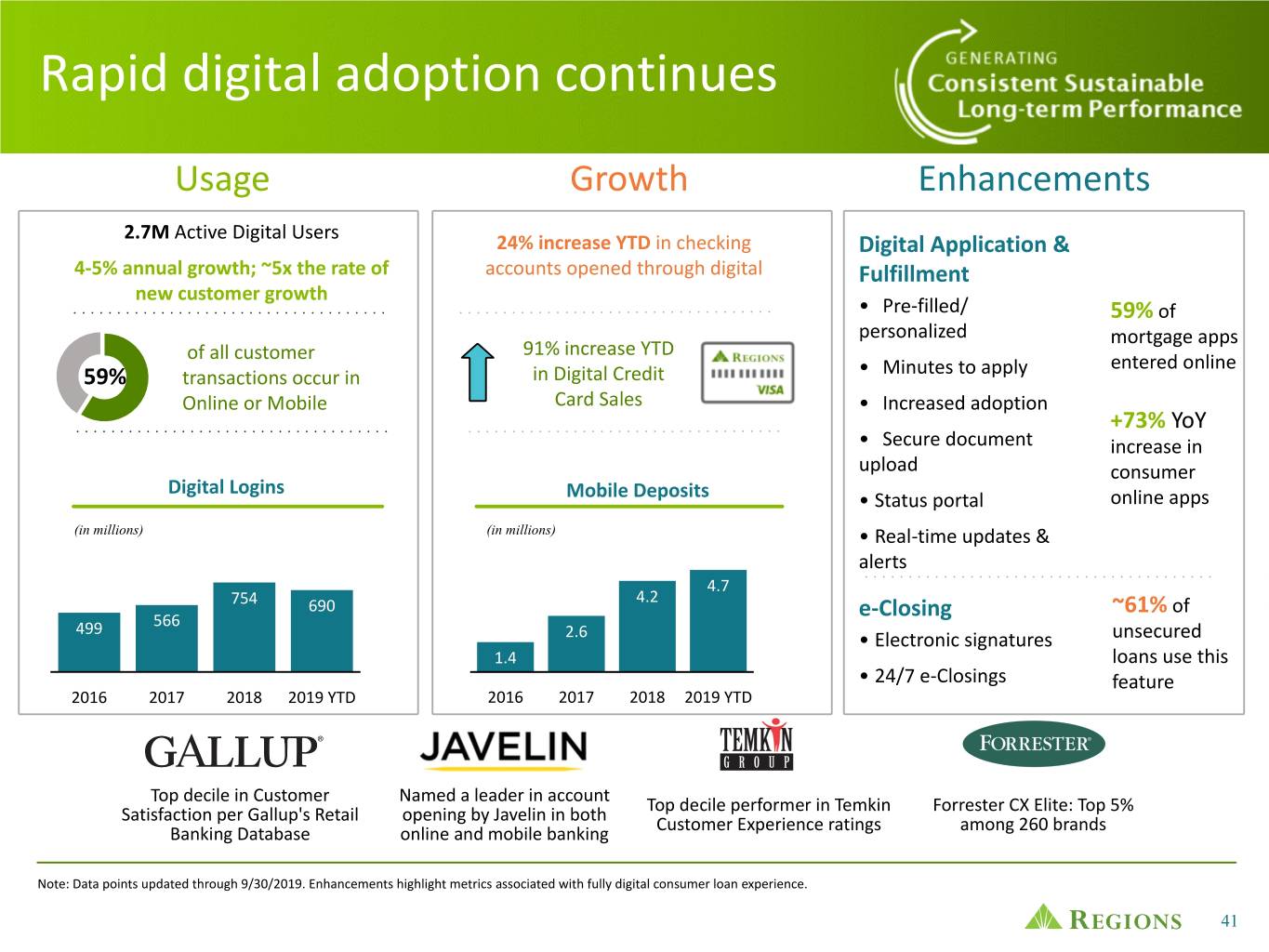
Rapid digital adoption continues Usage Growth Enhancements 2.7M Active Digital Users 24% increase YTD in checking Digital Application & 4-5% annual growth; ~5x the rate of accounts opened through digital Fulfillment new customer growth • Pre-filled/ 59% of personalized mortgage apps of all customer 91% increase YTD • Minutes to apply entered online 59% transactions occur in in Digital Credit Online or Mobile Card Sales • Increased adoption +73% YoY • Secure document increase in upload consumer Digital Logins Mobile Deposits • Status portal online apps (in millions) (in millions) • Real-time updates & alerts 4.7 4.2 754 690 e-Closing ~61% of 499 566 2.6 • Electronic signatures unsecured 1.4 loans use this • 24/7 e-Closings feature 2016 2017 2018 2019 YTD 2016 2017 2018 2019 YTD Top decile in Customer Named a leader in account Satisfaction per Gallup's Retail opening by Javelin in both Top decile performer in Temkin Forrester CX Elite: Top 5% Banking Database online and mobile banking Customer Experience ratings among 260 brands Note: Data points updated through 9/30/2019. Enhancements highlight metrics associated with fully digital consumer loan experience. 41

Simplify & Grow: a continuous improvement journey 2018 - 2019 YTD successes Making Banking Easier • Completed 16 of 67 Simplify & Grow Revenue Growth initiatives Efficiency Improvements • Completed organizational simplification including spans and layers improvements • ~2.6M calls handled by AI virtual banker in the contact center Key results • Over 19K consumer loan applications submitted online in 3Q19 (73% increase YoY) • Reduced staffing by ~2,200 (includes sale of Regions Insurance) since 12/31/2017 • 59% of mortgage applications submitted through Mortgage Portal in 3Q19 • Reduced ~1.9M square feet of occupied space since 12/31/2017 • 63% of Direct Loans closed through eSign (rolled out December of 2018) • Renegotiated 3rd-party contracts estimated savings by year-end in excess of $42M since 12/31/2017 Note: data through 3Q19. 42
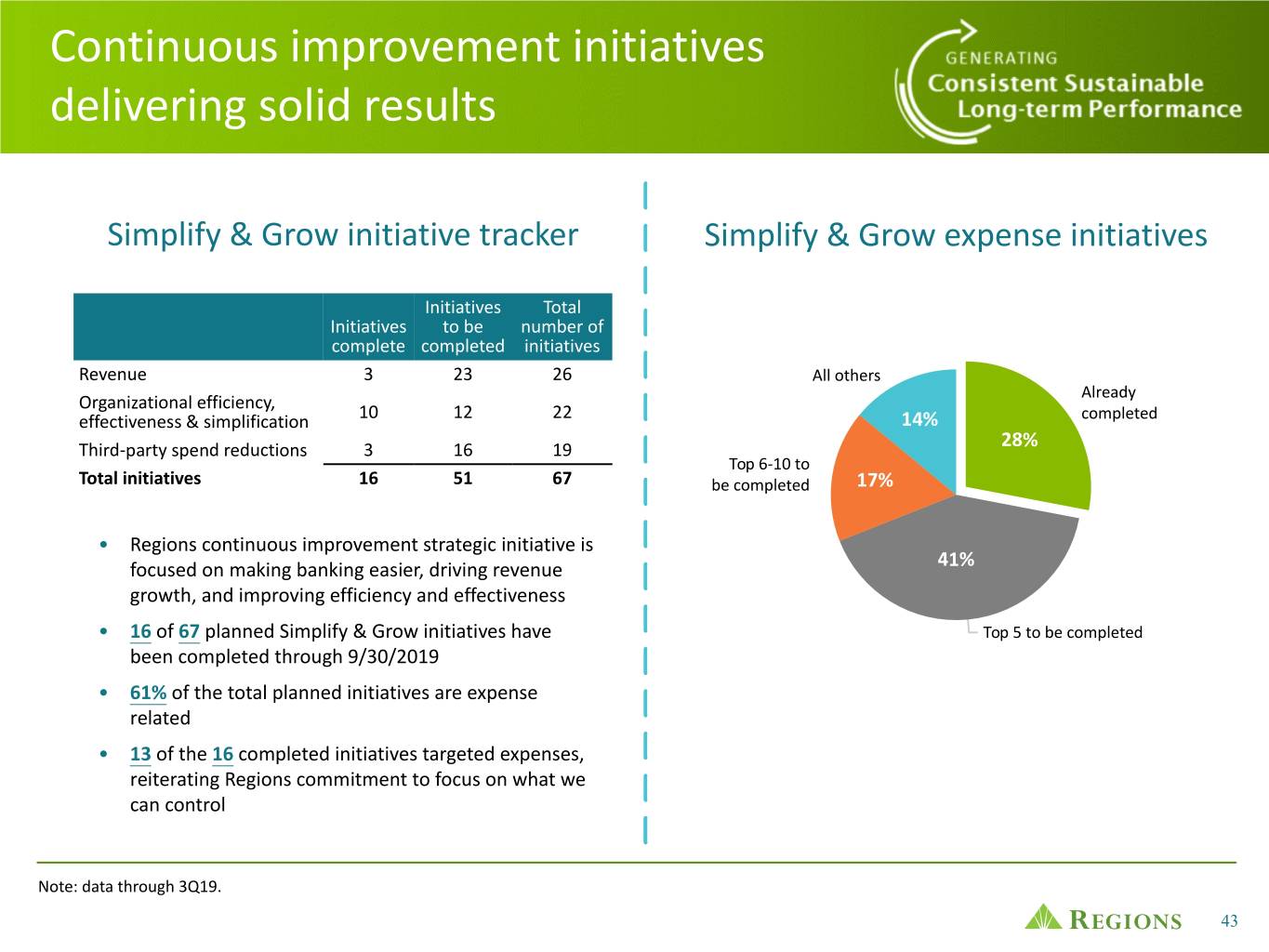
Continuous improvement initiatives delivering solid results Simplify & Grow initiative tracker Simplify & Grow expense initiatives Initiatives Total Initiatives to be number of complete completed initiatives Revenue 3 23 26 All others Already Organizational efficiency, effectiveness & simplification 10 12 22 14% completed Third-party spend reductions 3 16 19 28% Top 6-10 to Total initiatives 16 51 67 be completed 17% • Regions continuous improvement strategic initiative is 41% focused on making banking easier, driving revenue growth, and improving efficiency and effectiveness • 16 of 67 planned Simplify & Grow initiatives have Top 5 to be completed been completed through 9/30/2019 • 61% of the total planned initiatives are expense related • 13 of the 16 completed initiatives targeted expenses, reiterating Regions commitment to focus on what we can control Note: data through 3Q19. 43
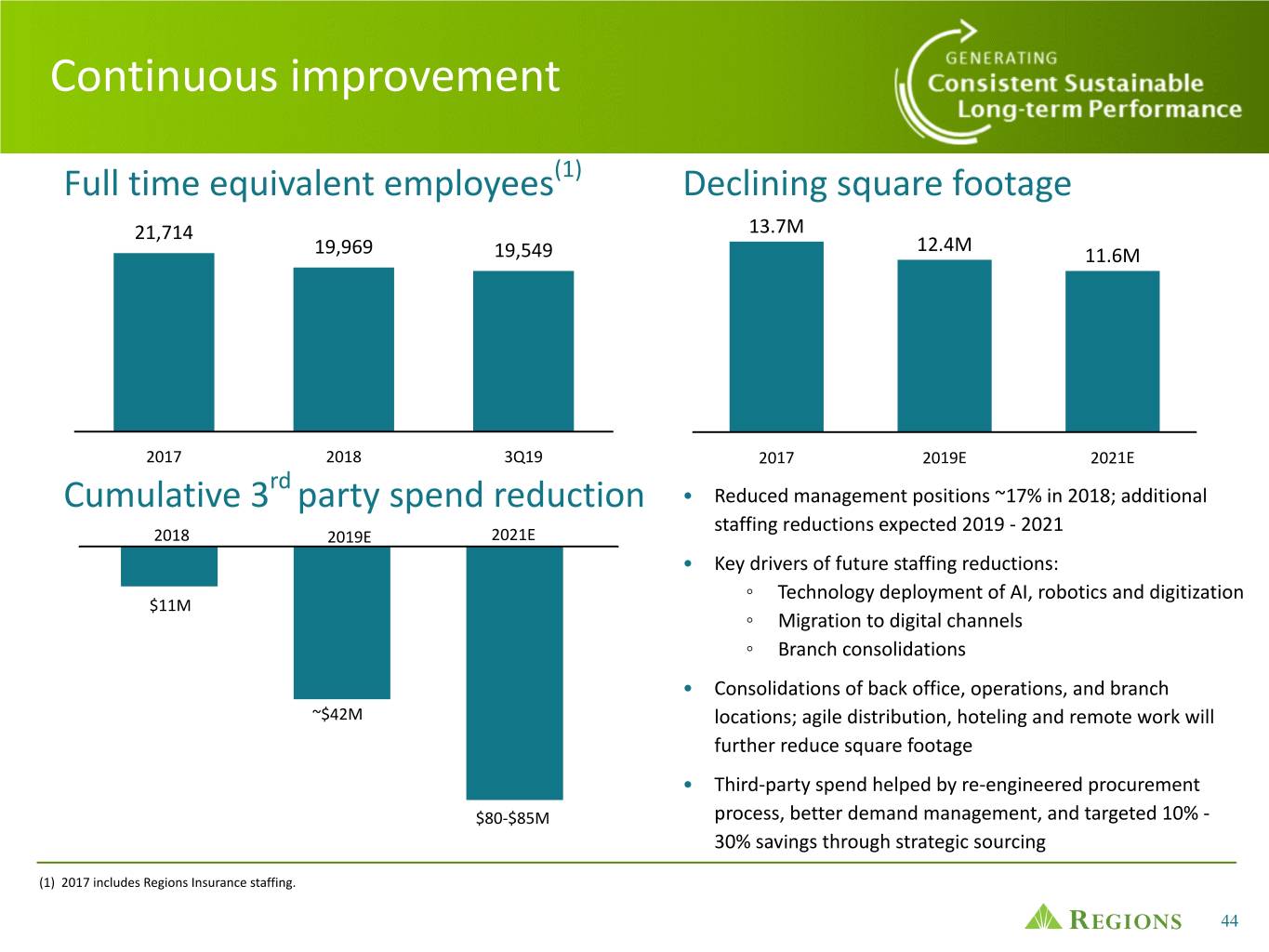
Continuous improvement Full time equivalent employees(1) Declining square footage 21,714 13.7M 12.4M 19,969 19,549 11.6M 53 2017 2018 3Q19 2017 2019E 2021E rd Cumulative 3 party spend reduction • Reduced management positions ~17% in 2018; additional staffing reductions expected 2019 - 2021 2018 2019E 2021E • Key drivers of future staffing reductions: ◦ Technology deployment of AI, robotics and digitization $11M ◦ Migration to digital channels ◦ Branch consolidations • Consolidations of back office, operations, and branch ~$42M locations; agile distribution, hoteling and remote work will further reduce square footage • Third-party spend helped by re-engineered procurement $80-$85M process, better demand management, and targeted 10% - 30% savings through strategic sourcing (1) 2017 includes Regions Insurance staffing. 44
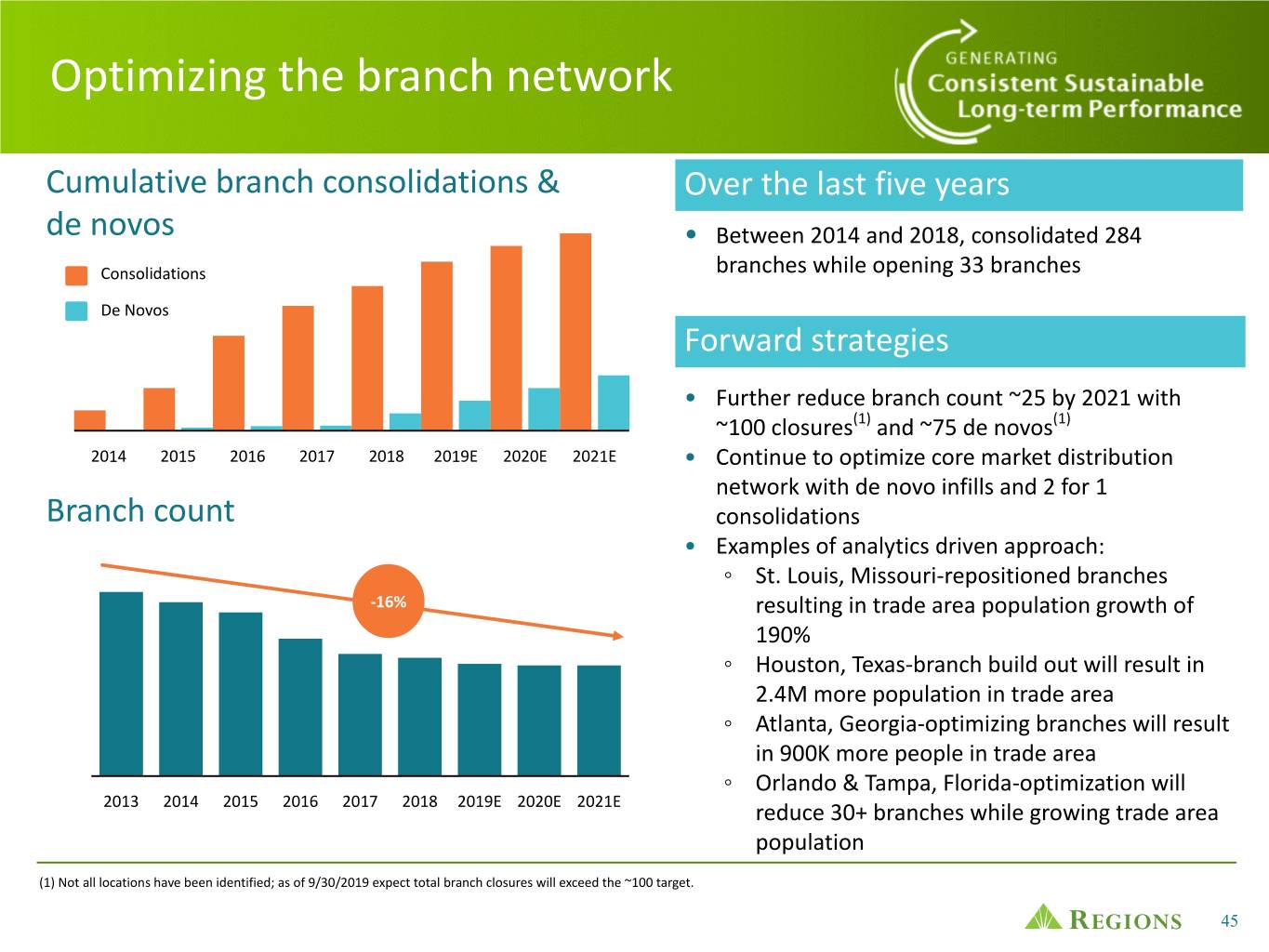
Optimizing the branch network Cumulative branch consolidations & Over the last five years de novos • Between 2014 and 2018, consolidated 284 Consolidations branches while opening 33 branches De Novos 53 Forward strategies • Further reduce branch count ~25 by 2021 with ~100 closures(1) and ~75 de novos(1) 2014 2015 2016 2017 2018 2019E 2020E 2021E • Continue to optimize core market distribution network with de novo infills and 2 for 1 Branch count consolidations • Examples of analytics driven approach: ◦ St. Louis, Missouri-repositioned branches -16% resulting in trade area population growth of 190% ◦ Houston, Texas-branch build out will result in 2.4M more population in trade area ◦ Atlanta, Georgia-optimizing branches will result in 900K more people in trade area ◦ Orlando & Tampa, Florida-optimization will 2013 2014 2015 2016 2017 2018 2019E 2020E 2021E reduce 30+ branches while growing trade area population (1) Not all locations have been identified; as of 9/30/2019 expect total branch closures will exceed the ~100 target. 45

CAPITAL, DEBT & LIQUIDITY 46

Capital targets framework • Capital targets calibrated using internal scenario planning • Strong capital position provides flexibility to manage effectively in any environment Strong Capital Position – CET1 A Macro Stresses • Stress informed quantitative buffer is calibrated using Regions' internally modeled capital performance over a 9-quarter stressed period 0.50% 9.50% • Macro assumptions are generally consistent with severe economic stress; 2.00% in line with levels present during the great recession 7.00% B Strategic Management Buffer • Established to supplement the pure quantitative capital targets at Management’s discretion ◦ Can be deployed opportunistically or to support the balance sheet in periods of stress • This buffer is not required from a capital adequacy perspective • Given current economic conditions, Regions expects to operate at ~9.5% CET1 over the near term Post Stress Stress Strategic CET1 Target Limit Informed Management Quantitative Buffer Buffer 47

Prudently managing and optimizing capital Capital priorities Organic growth Dividend per common53 share $0.46 $0.435 Dividends $0.23 2015 2018 2019 YTD Strategic investments Share repurchases 48
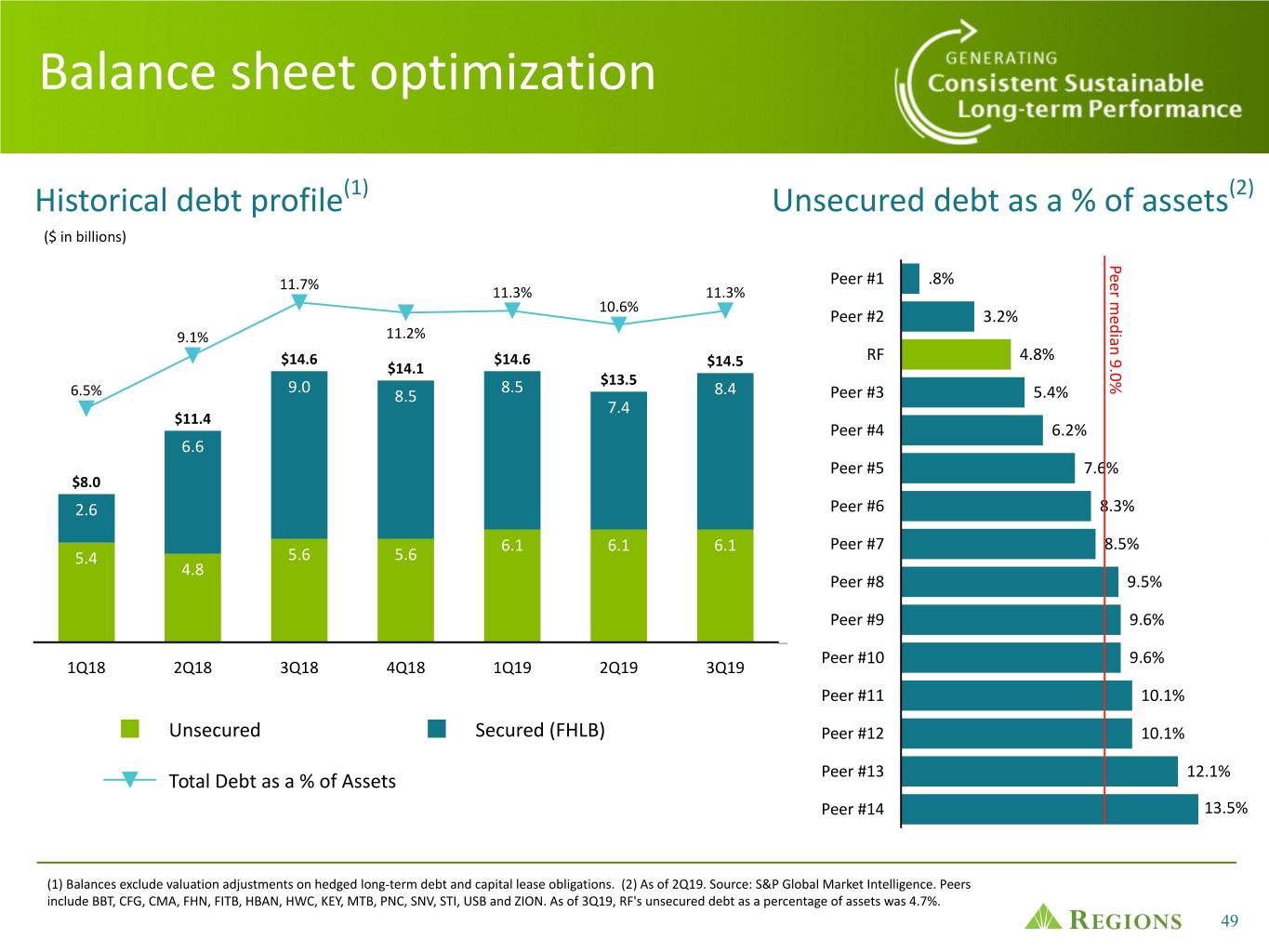
Balance sheet optimization Historical debt profile(1) Unsecured debt as a % of assets(2) ($ in billions) Peer median 9.0% 11.7% Peer #1 .8% 11.3% 11.3% 10.6% Peer #2 3.2% 9.1% 11.2% $14.6 $14.6 RF 4.8% $14.1 $14.5 9.0 8.5 $13.5 6.5% 8.5 8.4 Peer #3 5.4% 7.4 $11.4 Peer #4 6.2% 6.6 Peer #5 7.6% $8.0 2.6 Peer #6 8.3% 6.1 6.1 6.1 Peer #7 8.5% 5.4 5.6 5.6 4.8 Peer #8 9.5% Peer #9 9.6% Peer #10 9.6% 1Q18 2Q18 3Q18 4Q18 1Q19 2Q19 3Q19 Peer #11 10.1% Unsecured Secured (FHLB) Peer #12 10.1% Total Debt as a % of Assets Peer #13 12.1% Peer #14 13.5% (1) Balances exclude valuation adjustments on hedged long-term debt and capital lease obligations. (2) As of 2Q19. Source: S&P Global Market Intelligence. Peers include BBT, CFG, CMA, FHN, FITB, HBAN, HWC, KEY, MTB, PNC, SNV, STI, USB and ZION. As of 3Q19, RF's unsecured debt as a percentage of assets was 4.7%. 49
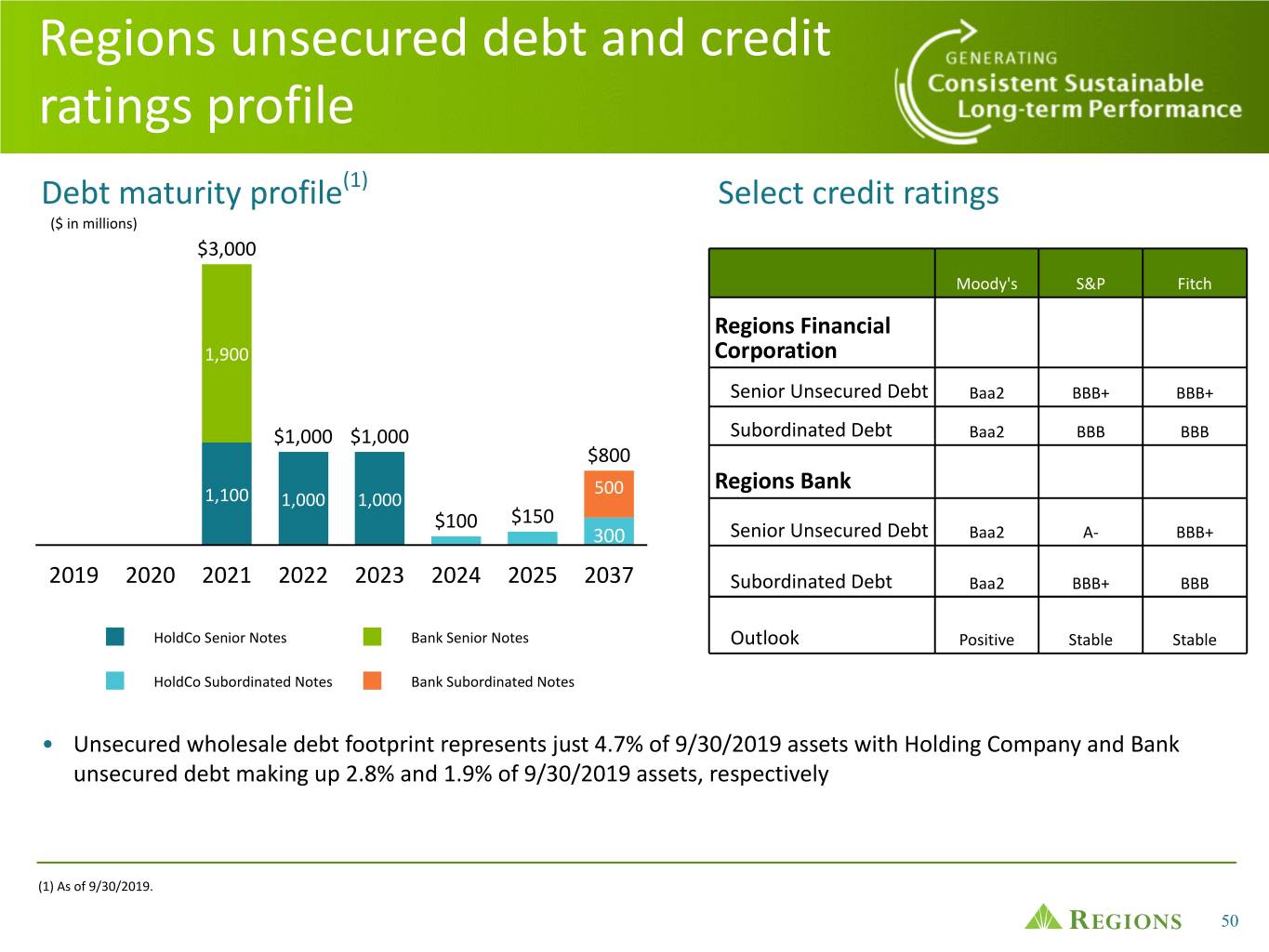
Regions unsecured debt and credit ratings profile Debt maturity profile(1) Select credit ratings ($ in millions) $3,000 Moody's S&P Fitch Regions Financial 1,900 Corporation Senior Unsecured Debt Baa2 BBB+ BBB+ $1,000 $1,000 Subordinated Debt Baa2 BBB BBB $800 500 Regions Bank 1,100 1,000 1,000 $100 $150 300 Senior Unsecured Debt Baa2 A- BBB+ 2019 2020 2021 2022 2023 2024 2025 2037 Subordinated Debt Baa2 BBB+ BBB HoldCo Senior Notes Bank Senior Notes Outlook Positive Stable Stable HoldCo Subordinated Notes Bank Subordinated Notes • Unsecured wholesale debt footprint represents just 4.7% of 9/30/2019 assets with Holding Company and Bank unsecured debt making up 2.8% and 1.9% of 9/30/2019 assets, respectively (1) As of 9/30/2019. 50
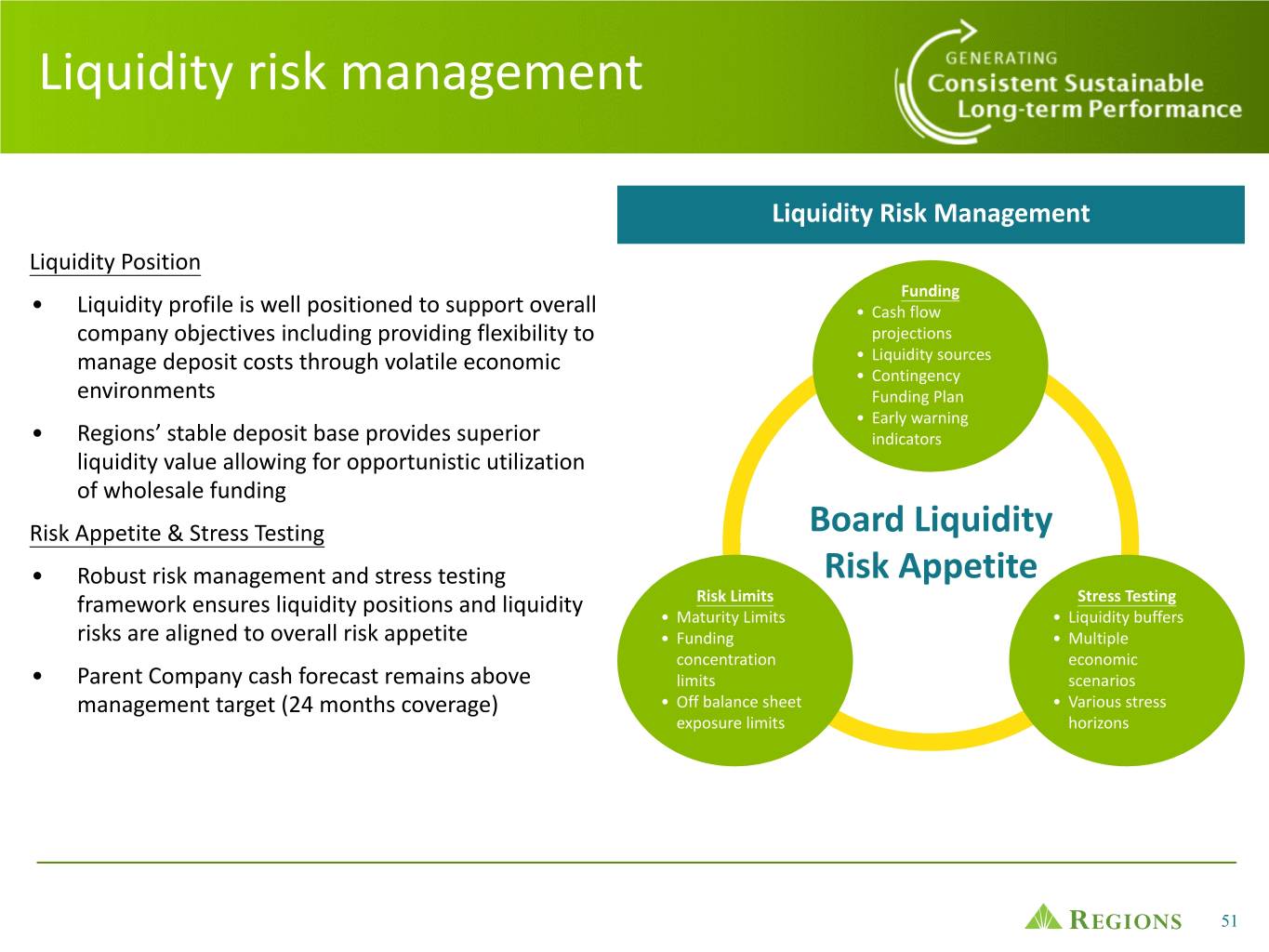
Liquidity risk management Liquidity Risk Management Liquidity Position Funding • Liquidity profile is well positioned to support overall • Cash flow company objectives including providing flexibility to projections manage deposit costs through volatile economic • Liquidity sources • Contingency environments Funding Plan • Early warning • Regions’ stable deposit base provides superior indicators liquidity value allowing for opportunistic utilization of wholesale funding Risk Appetite & Stress Testing Board Liquidity • Robust risk management and stress testing Risk Appetite Risk Limits Stress Testing framework ensures liquidity positions and liquidity • Maturity Limits • Liquidity buffers risks are aligned to overall risk appetite • Funding • Multiple concentration economic • Parent Company cash forecast remains above limits scenarios management target (24 months coverage) • Off balance sheet • Various stress exposure limits horizons 51

ENVIRONMENTAL, SOCIAL & CORPORATE GOVERNANCE 52
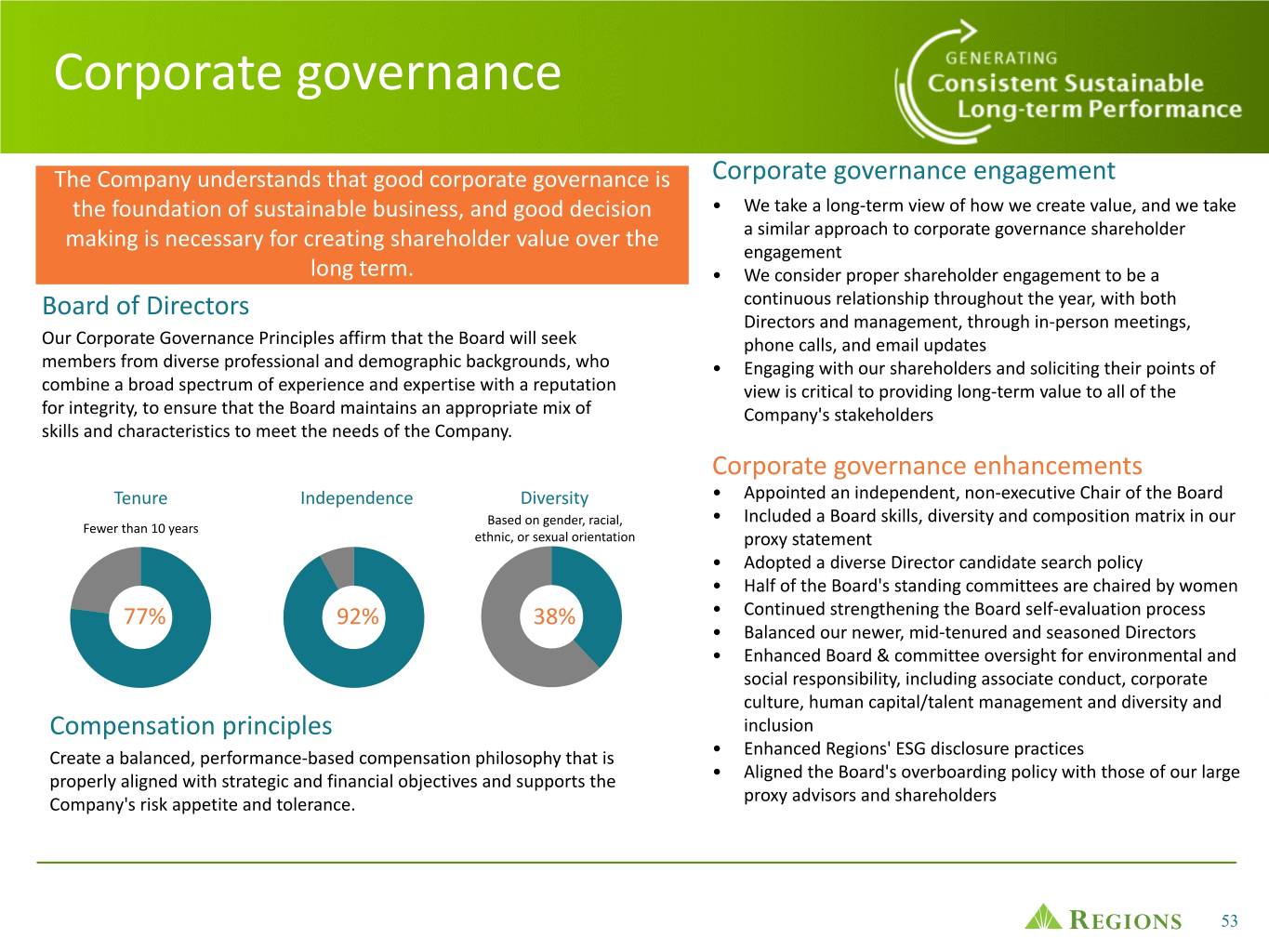
Corporate governance The Company understands that good corporate governance is Corporate governance engagement the foundation of sustainable business, and good decision • We take a long-term view of how we create value, and we take making is necessary for creating shareholder value over the a similar approach to corporate governance shareholder engagement long term. • We consider proper shareholder engagement to be a Board of Directors continuous relationship throughout the year, with both Directors and management, through in-person meetings, Our Corporate Governance Principles affirm that the Board will seek phone calls, and email updates members from diverse professional and demographic backgrounds, who • Engaging with our shareholders and soliciting their points of combine a broad spectrum of experience and expertise with a reputation view is critical to providing long-term value to all of the for integrity, to ensure that the Board maintains an appropriate mix of Company's stakeholders skills and characteristics to meet the needs of the Company. Corporate governance enhancements Tenure Independence Diversity • Appointed an independent, non-executive Chair of the Board Based on gender, racial, • Included a Board skills, diversity and composition matrix in our Fewer than 10 years ethnic, or sexual orientation proxy statement • Adopted a diverse Director candidate search policy • Half of the Board's standing committees are chaired by women 77% 92% 38% • Continued strengthening the Board self-evaluation process • Balanced our newer, mid-tenured and seasoned Directors • Enhanced Board & committee oversight for environmental and social responsibility, including associate conduct, corporate culture, human capital/talent management and diversity and Compensation principles inclusion Create a balanced, performance-based compensation philosophy that is • Enhanced Regions' ESG disclosure practices properly aligned with strategic and financial objectives and supports the • Aligned the Board's overboarding policy with those of our large Company's risk appetite and tolerance. proxy advisors and shareholders 53

Environmental & social highlights(1) ASSOCIATES 12 weeks 5% $15/hour Continued to invest in the Expanded parental leave plan to Increased the 401(k) Plan Raised the entry-level wage to development of our associates provide 12 weeks of fully paid matching contribution from 4% $15 an hour, while also Created a Diversity and to prepare them for the rapidly leave for birth mothers and 6 to 5%, in addition to the annual providing career paths and Inclusion Center of Expertise, changing work environment weeks of fully paid leave for 2% contribution that all eligible professional growth led by the Head of Diversity and (2) (2) through re-skilling and up- birth and adoptive parents associates receive opportunities for our associates Inclusion skilling programs CUSTOMERS AND COMMUNITIES (3) Formed the Corporate Responsibility and Community 94,000 $100 million Engagement team to address local community development needs and promote inclusive economic Contributed to the Regions Foundation to make growth through: Financial education presentations delivered by the purpose-led, performance-driven community Next Step®Elevate team investments Economic and Community Development 56,000 $4.8 billion Ed Education and Workforce Readiness Community service hours logged by our associates Invested in community development $ Financial Wellness ENVIRONMENT AND SUSTAINABILITY 18% 145 megawatts 2023 Environmental Goals(4) Reduced internal copy paper Provided capital in the form of sale-leasebacks to utility scale and Reduce Emissions by: Reduce Energy Use by: use by 18% over the past commercial photovoltaic solar projects with overall generating capacity year through process of 145 megawatts improvements 30% 30% Adopted an Environmental Sustainability Policy Statement and created an Environmental Working Group to support the implementation of the 20% achieved 12% achieved policy and engage associates on sustainability (1) Represents activity between January 1, 2018 and December 31, 2018, unless otherwise noted. (2) Parental leave plan and 401(k) Plan changes went into effect January 1, 2019. (3) Regions contributed $40 million to the Regions Foundation in 2017 and $60 million in 2018. (4) 2015 baseline. 54
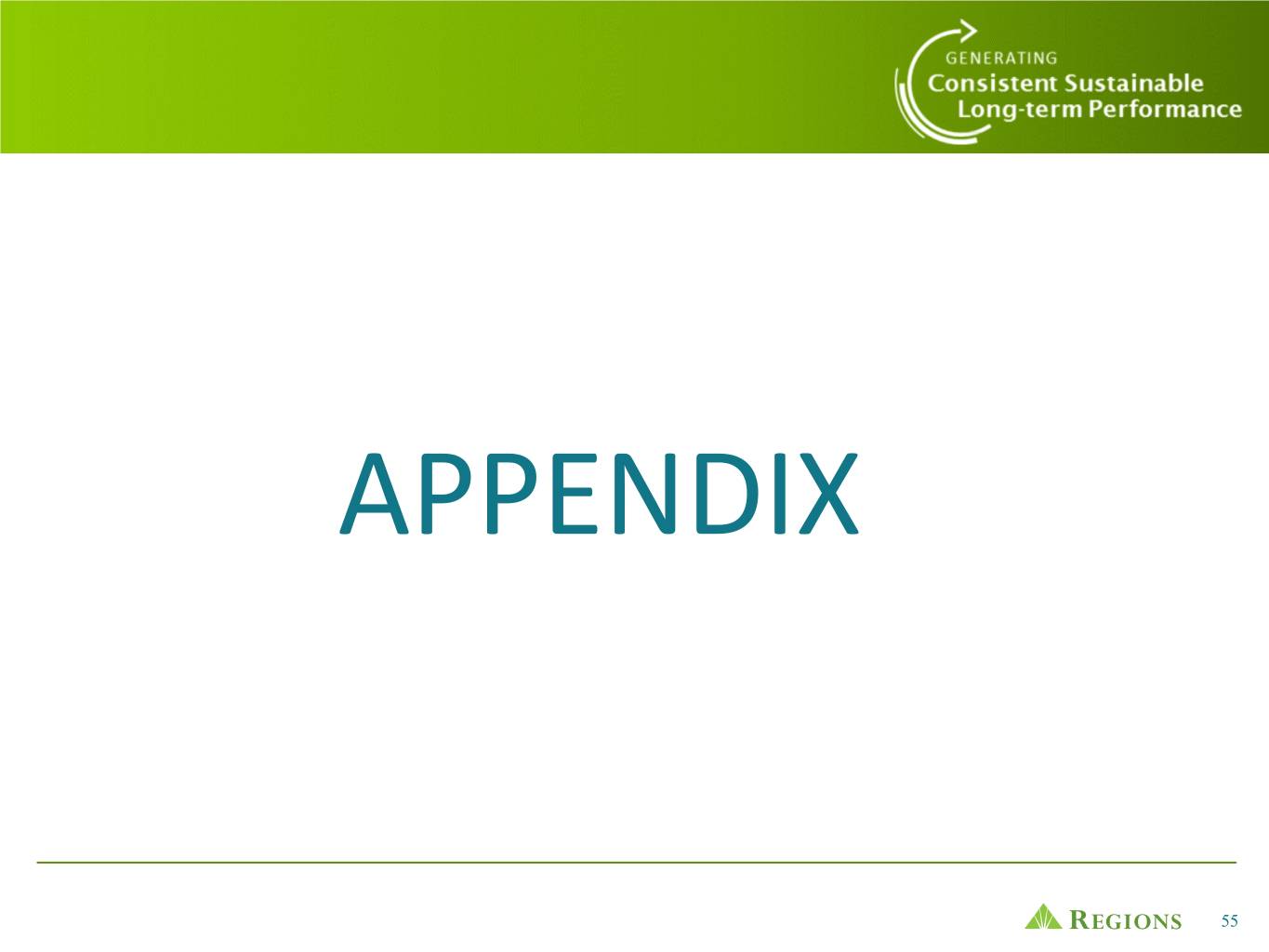
APPENDIX 55
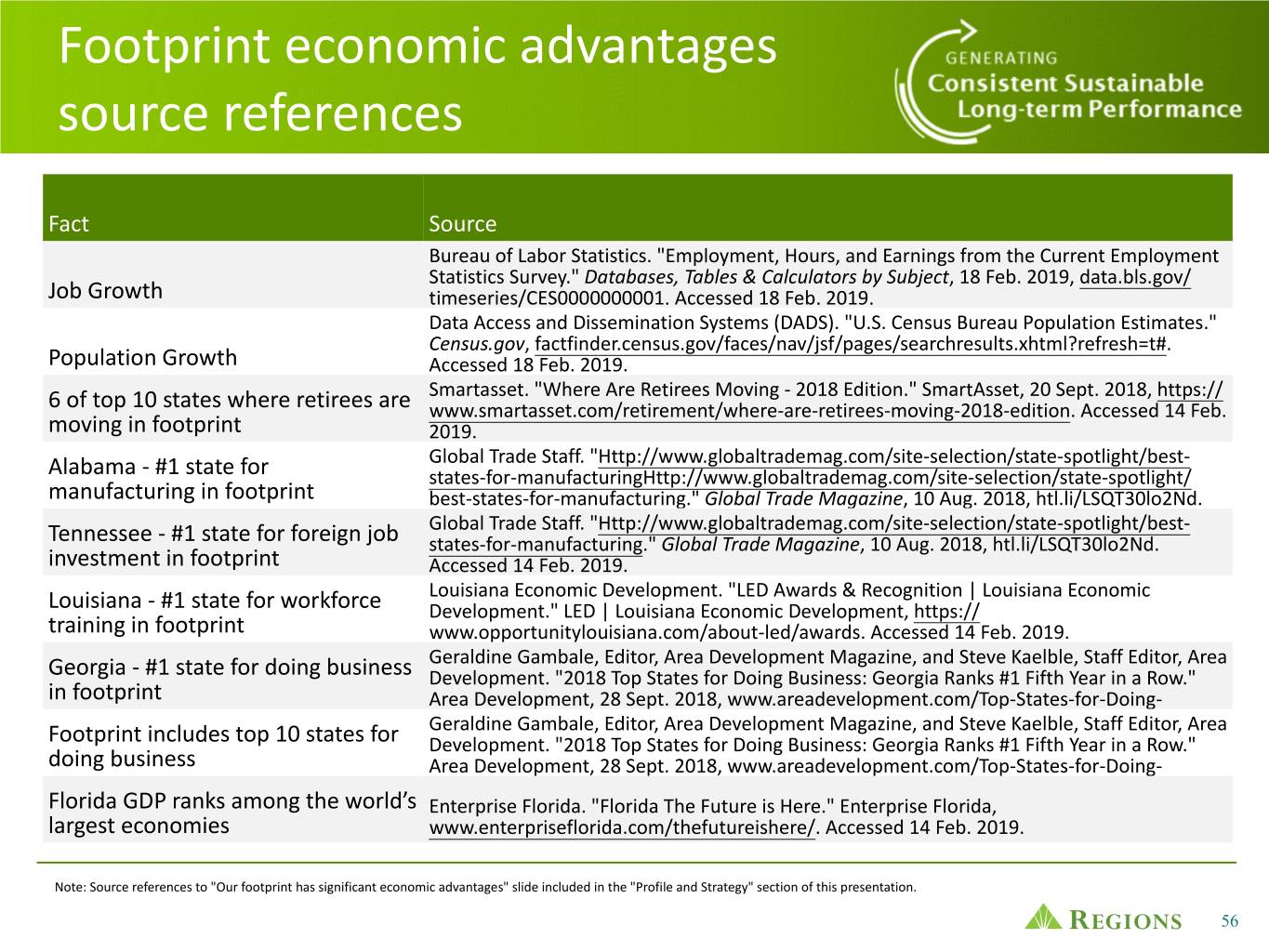
Footprint economic advantages source references Fact Source Bureau of Labor Statistics. "Employment, Hours, and Earnings from the Current Employment Statistics Survey." Databases, Tables & Calculators by Subject, 18 Feb. 2019, data.bls.gov/ Job Growth timeseries/CES0000000001. Accessed 18 Feb. 2019. Data Access and Dissemination Systems (DADS). "U.S. Census Bureau Population Estimates." Census.gov, factfinder.census.gov/faces/nav/jsf/pages/searchresults.xhtml?refresh=t#. Population Growth Accessed 18 Feb. 2019. Smartasset. "Where Are Retirees Moving - 2018 Edition." SmartAsset, 20 Sept. 2018, https:// 6 of top 10 states where retirees are www.smartasset.com/retirement/where-are-retirees-moving-2018-edition. Accessed 14 Feb. moving in footprint 2019. Global Trade Staff. "Http://www.globaltrademag.com/site-selection/state-spotlight/best- Alabama - #1 state for states-for-manufacturingHttp://www.globaltrademag.com/site-selection/state-spotlight/ manufacturing in footprint best-states-for-manufacturing." Global Trade Magazine, 10 Aug. 2018, htl.li/LSQT30lo2Nd. Global Trade Staff. "Http://www.globaltrademag.com/site-selection/state-spotlight/best- Tennessee - #1 state for foreign job states-for-manufacturing." Global Trade Magazine, 10 Aug. 2018, htl.li/LSQT30lo2Nd. investment in footprint Accessed 14 Feb. 2019. Louisiana Economic Development. "LED Awards & Recognition | Louisiana Economic Louisiana - #1 state for workforce Development." LED | Louisiana Economic Development, https:// training in footprint www.opportunitylouisiana.com/about-led/awards. Accessed 14 Feb. 2019. Geraldine Gambale, Editor, Area Development Magazine, and Steve Kaelble, Staff Editor, Area Georgia - #1 state for doing business Development. "2018 Top States for Doing Business: Georgia Ranks #1 Fifth Year in a Row." in footprint Area Development, 28 Sept. 2018, www.areadevelopment.com/Top-States-for-Doing- Geraldine Gambale, Editor, Area Development Magazine, and Steve Kaelble, Staff Editor, Area Footprint includes top 10 states for Development. "2018 Top States for Doing Business: Georgia Ranks #1 Fifth Year in a Row." doing business Area Development, 28 Sept. 2018, www.areadevelopment.com/Top-States-for-Doing- Florida GDP ranks among the world’s Enterprise Florida. "Florida The Future is Here." Enterprise Florida, largest economies www.enterpriseflorida.com/thefutureishere/. Accessed 14 Feb. 2019. Note: Source references to "Our footprint has significant economic advantages" slide included in the "Profile and Strategy" section of this presentation. 56
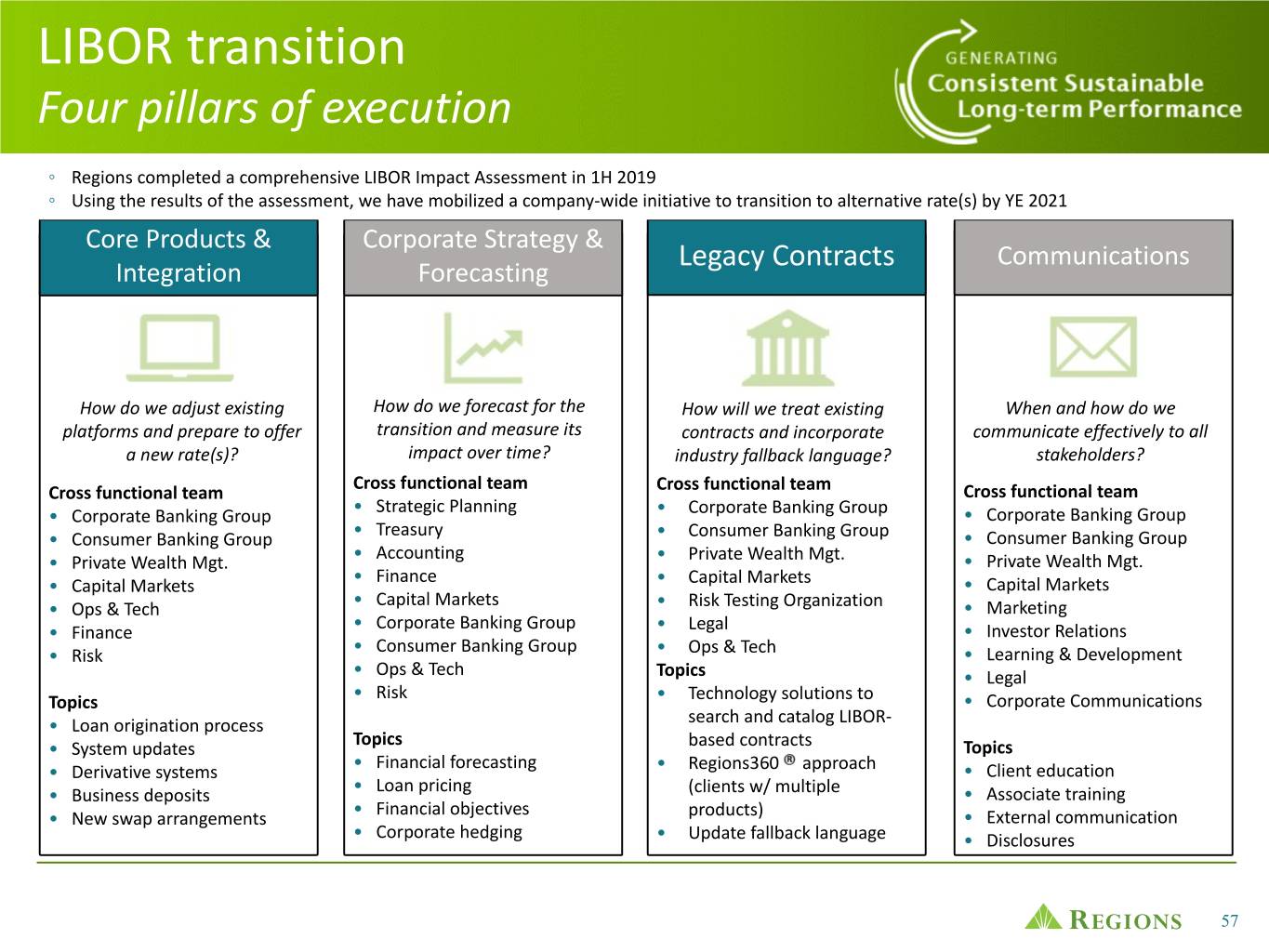
LIBOR transition Four pillars of execution ◦ Regions completed a comprehensive LIBOR Impact Assessment in 1H 2019 ◦ Using the results of the assessment, we have mobilized a company-wide initiative to transition to alternative rate(s) by YE 2021 Core Products & Corporate Strategy & Legacy Contracts Communications Integration Forecasting How do we adjust existing How do we forecast for the How will we treat existing When and how do we platforms and prepare to offer transition and measure its contracts and incorporate communicate effectively to all a new rate(s)? impact over time? industry fallback language? stakeholders? Cross functional team Cross functional team Cross functional team Cross functional team • Strategic Planning • Corporate Banking Group • Corporate Banking Group • Corporate Banking Group • Treasury • Consumer Banking Group • Consumer Banking Group • Consumer Banking Group • Accounting • Private Wealth Mgt. • Private Wealth Mgt. • Private Wealth Mgt. • Finance • Capital Markets • Capital Markets • Capital Markets • Capital Markets • Ops & Tech • Risk Testing Organization • Marketing • Corporate Banking Group • Finance • Legal • Investor Relations • Consumer Banking Group • Risk • Ops & Tech • Learning & Development • Ops & Tech Topics • Legal • Risk Topics • Technology solutions to • Corporate Communications • Loan origination process search and catalog LIBOR- Topics • System updates based contracts Topics • Financial forecasting • Derivative systems • Regions360 approach • Client education • Loan pricing • Business deposits (clients w/ multiple • Associate training • Financial objectives • New swap arrangements products) • External communication • Corporate hedging • Update fallback language • Disclosures 57

Non-GAAP information This document contains non-GAAP financial measures, which exclude certain items management does not consider indicative of the Company’s on-going financial performance. Management believes that the exclusion of these items provides a meaningful base for period- to-period comparisons, which management believes will assist investors in analyzing the operating results of the Company and predicting future performance. These non-GAAP financial measures are also used by management to assess the performance of Regions’ business. It is possible that the activities related to these adjustments may recur; however, management does not consider these activities to be indications of ongoing operations. Management believes that presentation of these non-GAAP financial measures will permit investors to assess the performance of the Company on the same basis as that applied by management. Other companies may use similarly titled non-GAAP financial measures that are calculated differently from the way we calculate such measures. Accordingly, our non-GAAP financial measures may not be comparable to similar measures used by other companies. We caution investors not to place undue reliance on such non-GAAP financial measures, but to consider them with the most directly comparable GAAP measures. Non-GAAP financial measures have limitations as analytical tools and should not be considered in isolation or as a substitute for our results reported under GAAP. The following tables present reconciliations of Regions' non-GAAP measures to the most directly comparable GAAP financial measures. 58
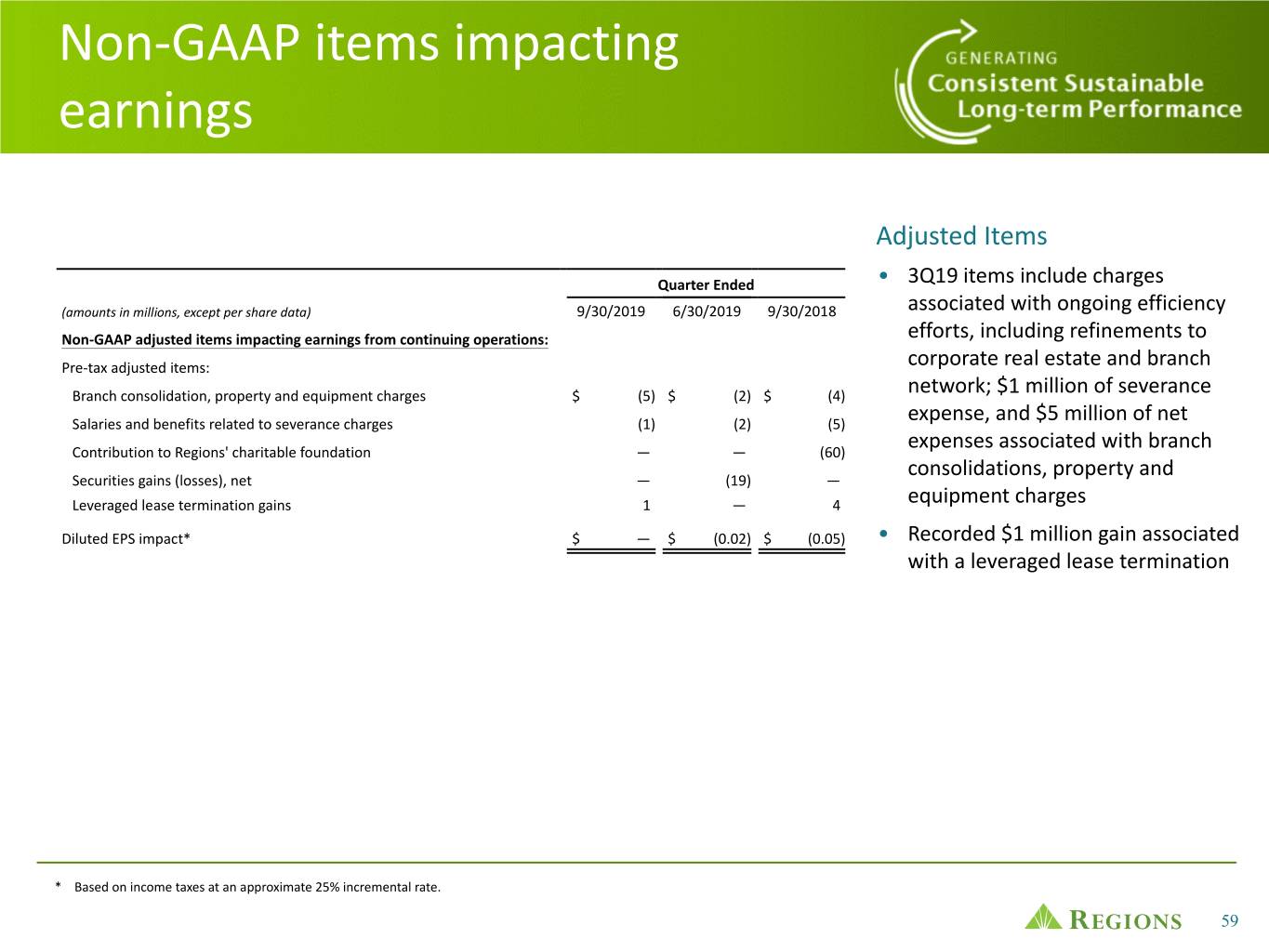
Non-GAAP items impacting earnings Adjusted Items Quarter Ended • 3Q19 items include charges (amounts in millions, except per share data) 9/30/2019 6/30/2019 9/30/2018 associated with ongoing efficiency Non-GAAP adjusted items impacting earnings from continuing operations: efforts, including refinements to Pre-tax adjusted items: corporate real estate and branch Branch consolidation, property and equipment charges $ (5) $ (2) $ (4) network; $1 million of severance Salaries and benefits related to severance charges (1) (2) (5) expense, and $5 million of net expenses associated with branch Contribution to Regions' charitable foundation — — (60) consolidations, property and Securities gains (losses), net — (19) — Leveraged lease termination gains 1 — 4 equipment charges Diluted EPS impact* $ — $ (0.02) $ (0.05) • Recorded $1 million gain associated with a leveraged lease termination * Based on income taxes at an approximate 25% incremental rate. 59
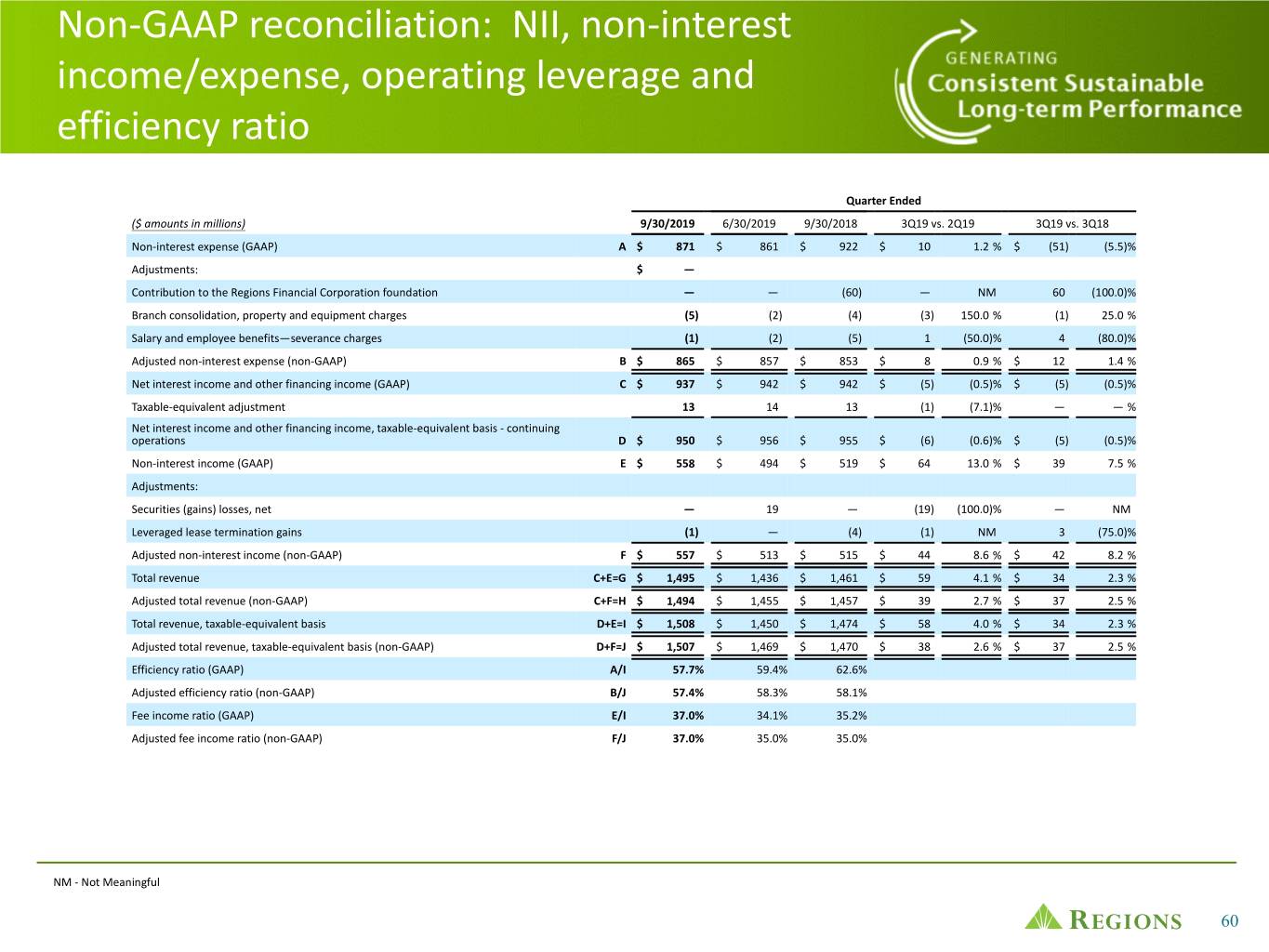
Non-GAAP reconciliation: NII, non-interest income/expense, operating leverage and efficiency ratio Quarter Ended ($ amounts in millions) 9/30/2019 6/30/2019 9/30/2018 3Q19 vs. 2Q19 3Q19 vs. 3Q18 Non-interest expense (GAAP) A $ 871 $ 861 $ 922 $ 10 1.2 % $ (51) (5.5)% Adjustments: $ — Contribution to the Regions Financial Corporation foundation — — (60) — NM 60 (100.0)% Branch consolidation, property and equipment charges (5) (2) (4) (3) 150.0 % (1) 25.0 % Salary and employee benefits—severance charges (1) (2) (5) 1 (50.0)% 4 (80.0)% Adjusted non-interest expense (non-GAAP) B $ 865 $ 857 $ 853 $ 8 0.9 % $ 12 1.4 % Net interest income and other financing income (GAAP) C $ 937 $ 942 $ 942 $ (5) (0.5)% $ (5) (0.5)% Taxable-equivalent adjustment 13 14 13 (1) (7.1)% — — % Net interest income and other financing income, taxable-equivalent basis - continuing operations D $ 950 $ 956 $ 955 $ (6) (0.6)% $ (5) (0.5)% Non-interest income (GAAP) E $ 558 $ 494 $ 519 $ 64 13.0 % $ 39 7.5 % Adjustments: Securities (gains) losses, net — 19 — (19) (100.0)% — NM Leveraged lease termination gains (1) — (4) (1) NM 3 (75.0)% Adjusted non-interest income (non-GAAP) F $ 557 $ 513 $ 515 $ 44 8.6 % $ 42 8.2 % Total revenue C+E=G $ 1,495 $ 1,436 $ 1,461 $ 59 4.1 % $ 34 2.3 % Adjusted total revenue (non-GAAP) C+F=H $ 1,494 $ 1,455 $ 1,457 $ 39 2.7 % $ 37 2.5 % Total revenue, taxable-equivalent basis D+E=I $ 1,508 $ 1,450 $ 1,474 $ 58 4.0 % $ 34 2.3 % Adjusted total revenue, taxable-equivalent basis (non-GAAP) D+F=J $ 1,507 $ 1,469 $ 1,470 $ 38 2.6 % $ 37 2.5 % Efficiency ratio (GAAP) A/I 57.7% 59.4% 62.6% Adjusted efficiency ratio (non-GAAP) B/J 57.4% 58.3% 58.1% Fee income ratio (GAAP) E/I 37.0% 34.1% 35.2% Adjusted fee income ratio (non-GAAP) F/J 37.0% 35.0% 35.0% NM - Not Meaningful 60
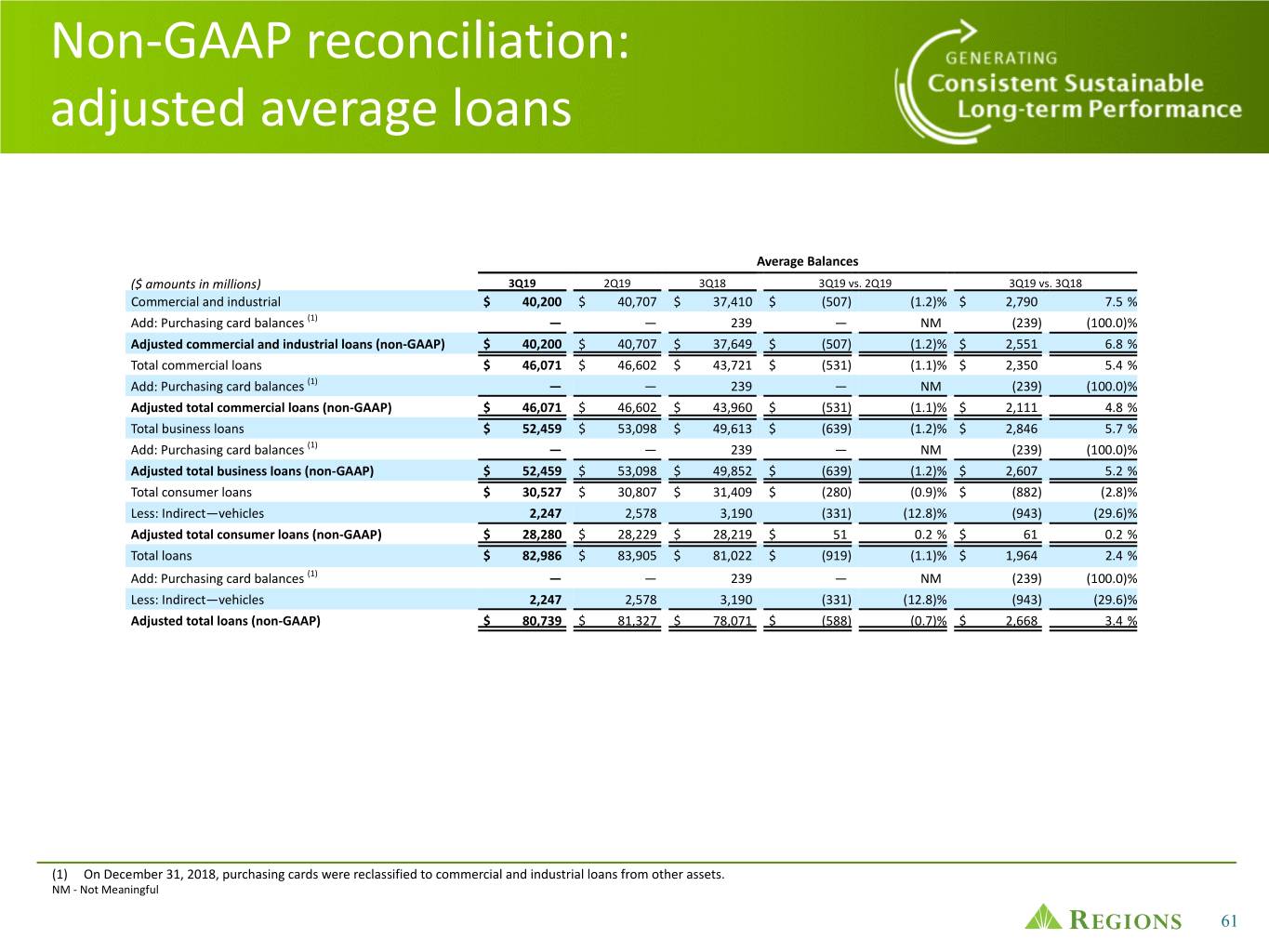
Non-GAAP reconciliation: adjusted average loans Average Balances ($ amounts in millions) 3Q19 2Q19 3Q18 3Q19 vs. 2Q19 3Q19 vs. 3Q18 Commercial and industrial $ 40,200 $ 40,707 $ 37,410 $ (507) (1.2)% $ 2,790 7.5 % Add: Purchasing card balances (1) — — 239 — NM (239) (100.0)% Adjusted commercial and industrial loans (non-GAAP) $ 40,200 $ 40,707 $ 37,649 $ (507) (1.2)% $ 2,551 6.8 % Total commercial loans $ 46,071 $ 46,602 $ 43,721 $ (531) (1.1)% $ 2,350 5.4 % Add: Purchasing card balances (1) — — 239 — NM (239) (100.0)% Adjusted total commercial loans (non-GAAP) $ 46,071 $ 46,602 $ 43,960 $ (531) (1.1)% $ 2,111 4.8 % Total business loans $ 52,459 $ 53,098 $ 49,613 $ (639) (1.2)% $ 2,846 5.7 % Add: Purchasing card balances (1) — — 239 — NM (239) (100.0)% Adjusted total business loans (non-GAAP) $ 52,459 $ 53,098 $ 49,852 $ (639) (1.2)% $ 2,607 5.2 % Total consumer loans $ 30,527 $ 30,807 $ 31,409 $ (280) (0.9)% $ (882) (2.8)% Less: Indirect—vehicles 2,247 2,578 3,190 (331) (12.8)% (943) (29.6)% Adjusted total consumer loans (non-GAAP) $ 28,280 $ 28,229 $ 28,219 $ 51 0.2 % $ 61 0.2 % Total loans $ 82,986 $ 83,905 $ 81,022 $ (919) (1.1)% $ 1,964 2.4 % Add: Purchasing card balances (1) — — 239 — NM (239) (100.0)% Less: Indirect—vehicles 2,247 2,578 3,190 (331) (12.8)% (943) (29.6)% Adjusted total loans (non-GAAP) $ 80,739 $ 81,327 $ 78,071 $ (588) (0.7)% $ 2,668 3.4 % (1) On December 31, 2018, purchasing cards were reclassified to commercial and industrial loans from other assets. NM - Not Meaningful 61

Forward-looking statements This presentation may include forward-looking statements as defined in the Private Securities Litigation Reform Act of 1995. Forward-looking statements are not based on historical information, but rather are related to future operations, strategies, financial results or other developments. Forward-looking statements are based on management’s current expectations as well as certain assumptions and estimates made by, and information available to, management at the time the statements are made. Those statements are based on general assumptions and are subject to various risks, and because they also relate to the future they are likewise subject to inherent uncertainties and other factors that may cause actual results to differ materially from the views, beliefs and projections expressed in such statements. Therefore, we caution you against relying on any of these forward-looking statements. These risks, uncertainties and other factors include, but are not limited to, those described below: • Current and future economic and market conditions in the United States generally or in the communities we serve, including the effects of possible declines in property values, increases in unemployment rates and potential reductions of economic growth, which may adversely affect our lending and other businesses and our financial results and conditions. • Possible changes in trade, monetary and fiscal policies of, and other activities undertaken by, governments, agencies, central banks and similar organizations, which could have a material adverse effect on our earnings. • Possible changes in market interest rates or capital markets could adversely affect our revenue and expense, the value of assets and obligations, and the availability and cost of capital and liquidity. • Any impairment of our goodwill or other intangibles, any repricing of assets, or any adjustment of valuation allowances on our deferred tax assets due to changes in law, adverse changes in the economic environment, declining operations of the reporting unit or other factors. • The effect of changes in tax laws, including the effect of any future interpretations of or amendments to Tax Reform, which may impact our earnings, capital ratios and our ability to return capital to stockholders. • Possible changes in the creditworthiness of customers and the possible impairment of the collectability of loans and leases, including operating leases. • Changes in the speed of loan prepayments, loan origination and sale volumes, charge-offs, loan loss provisions or actual loan losses where our allowance for loan losses may not be adequate to cover our eventual losses. • Possible acceleration of prepayments on mortgage-backed securities due to low interest rates, and the related acceleration of premium amortization on those securities. • Loss of customer checking and savings account deposits as customers pursue other, higher-yield investments, which could increase our funding costs. • Possible changes in consumer and business spending and saving habits and the related effect on our ability to increase assets and to attract deposits, which could adversely affect our net income. • Our ability to effectively compete with other traditional and non-traditional financial services companies, some of whom possess greater financial resources than we do or are subject to different regulatory standards than we are. • Our inability to develop and gain acceptance from current and prospective customers for new products and services and the enhancement of existing products and services to meet customers’ needs and respond to emerging technological trends in a timely manner could have a negative impact on our revenue. • Our inability to keep pace with technological changes could result in losing business to competitors. • Changes in laws and regulations affecting our businesses, including legislation and regulations relating to bank products and services, as well as changes in the enforcement and interpretation of such laws and regulations by applicable governmental and self-regulatory agencies, which could require us to change certain business practices, increase compliance risk, reduce our revenue, impose additional costs on us, or otherwise negatively affect our businesses. • Our ability to obtain a regulatory non-objection (as part of the CCAR process or otherwise) to take certain capital actions, including paying dividends and any plans to increase common stock dividends, repurchase common stock under current or future programs, or redeem preferred stock or other regulatory capital instruments, may impact our ability to return capital to stockholders and market perceptions of us. • Our ability to comply with stress testing and capital planning requirements (as part of the CCAR process or otherwise) may continue to require a significant investment of our managerial resources due to the importance of such tests and requirements. • Our ability to comply with applicable capital and liquidity requirements (including, among other things, the Basel III capital standards and the LCR rule), including our ability to generate capital internally or raise capital on favorable terms, and if we fail to meet requirements, our financial condition could be negatively impacted. • The effects of any developments, changes or actions relating to any litigation or regulatory proceedings brought against us or any of our subsidiaries. • The costs, including possibly incurring fines, penalties, or other negative effects (including reputational harm) of any adverse judicial, administrative, or arbitral rulings or proceedings, regulatory enforcement actions, or other legal actions to which we or any of our subsidiaries are a party, and which may adversely affect our results. • Our ability to manage fluctuations in the value of assets and liabilities and off-balance sheet exposure so as to maintain sufficient capital and liquidity to support our business. • Our ability to execute on our strategic and operational plans, including our ability to fully realize the financial and non-financial benefits relating to our strategic initiatives. • The risks and uncertainties related to our acquisition or divestiture of businesses. • The success of our marketing efforts in attracting and retaining customers. 62
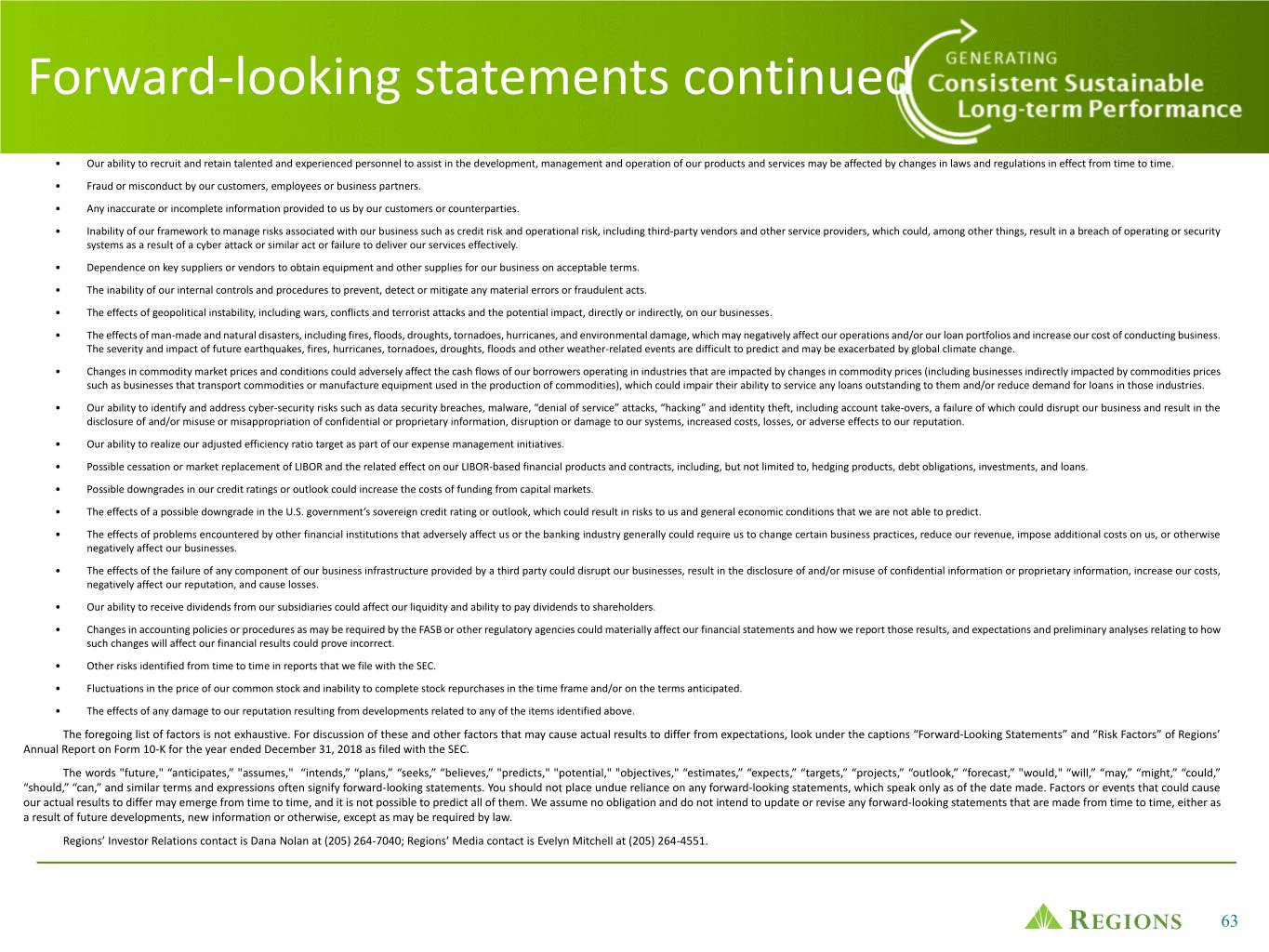
Forward-looking statements continued • Our ability to recruit and retain talented and experienced personnel to assist in the development, management and operation of our products and services may be affected by changes in laws and regulations in effect from time to time. • Fraud or misconduct by our customers, employees or business partners. • Any inaccurate or incomplete information provided to us by our customers or counterparties. • Inability of our framework to manage risks associated with our business such as credit risk and operational risk, including third-party vendors and other service providers, which could, among other things, result in a breach of operating or security systems as a result of a cyber attack or similar act or failure to deliver our services effectively. • Dependence on key suppliers or vendors to obtain equipment and other supplies for our business on acceptable terms. • The inability of our internal controls and procedures to prevent, detect or mitigate any material errors or fraudulent acts. • The effects of geopolitical instability, including wars, conflicts and terrorist attacks and the potential impact, directly or indirectly, on our businesses. • The effects of man-made and natural disasters, including fires, floods, droughts, tornadoes, hurricanes, and environmental damage, which may negatively affect our operations and/or our loan portfolios and increase our cost of conducting business. The severity and impact of future earthquakes, fires, hurricanes, tornadoes, droughts, floods and other weather-related events are difficult to predict and may be exacerbated by global climate change. • Changes in commodity market prices and conditions could adversely affect the cash flows of our borrowers operating in industries that are impacted by changes in commodity prices (including businesses indirectly impacted by commodities prices such as businesses that transport commodities or manufacture equipment used in the production of commodities), which could impair their ability to service any loans outstanding to them and/or reduce demand for loans in those industries. • Our ability to identify and address cyber-security risks such as data security breaches, malware, “denial of service” attacks, “hacking” and identity theft, including account take-overs, a failure of which could disrupt our business and result in the disclosure of and/or misuse or misappropriation of confidential or proprietary information, disruption or damage to our systems, increased costs, losses, or adverse effects to our reputation. • Our ability to realize our adjusted efficiency ratio target as part of our expense management initiatives. • Possible cessation or market replacement of LIBOR and the related effect on our LIBOR-based financial products and contracts, including, but not limited to, hedging products, debt obligations, investments, and loans. • Possible downgrades in our credit ratings or outlook could increase the costs of funding from capital markets. • The effects of a possible downgrade in the U.S. government’s sovereign credit rating or outlook, which could result in risks to us and general economic conditions that we are not able to predict. • The effects of problems encountered by other financial institutions that adversely affect us or the banking industry generally could require us to change certain business practices, reduce our revenue, impose additional costs on us, or otherwise negatively affect our businesses. • The effects of the failure of any component of our business infrastructure provided by a third party could disrupt our businesses, result in the disclosure of and/or misuse of confidential information or proprietary information, increase our costs, negatively affect our reputation, and cause losses. • Our ability to receive dividends from our subsidiaries could affect our liquidity and ability to pay dividends to shareholders. • Changes in accounting policies or procedures as may be required by the FASB or other regulatory agencies could materially affect our financial statements and how we report those results, and expectations and preliminary analyses relating to how such changes will affect our financial results could prove incorrect. • Other risks identified from time to time in reports that we file with the SEC. • Fluctuations in the price of our common stock and inability to complete stock repurchases in the time frame and/or on the terms anticipated. • The effects of any damage to our reputation resulting from developments related to any of the items identified above. The foregoing list of factors is not exhaustive. For discussion of these and other factors that may cause actual results to differ from expectations, look under the captions “Forward-Looking Statements” and “Risk Factors” of Regions’ Annual Report on Form 10-K for the year ended December 31, 2018 as filed with the SEC. The words "future," “anticipates,” "assumes," “intends,” “plans,” “seeks,” “believes,” "predicts," "potential," "objectives," “estimates,” “expects,” “targets,” “projects,” “outlook,” “forecast,” "would," “will,” “may,” “might,” “could,” “should,” “can,” and similar terms and expressions often signify forward-looking statements. You should not place undue reliance on any forward-looking statements, which speak only as of the date made. Factors or events that could cause our actual results to differ may emerge from time to time, and it is not possible to predict all of them. We assume no obligation and do not intend to update or revise any forward-looking statements that are made from time to time, either as a result of future developments, new information or otherwise, except as may be required by law. Regions’ Investor Relations contact is Dana Nolan at (205) 264-7040; Regions’ Media contact is Evelyn Mitchell at (205) 264-4551. 63
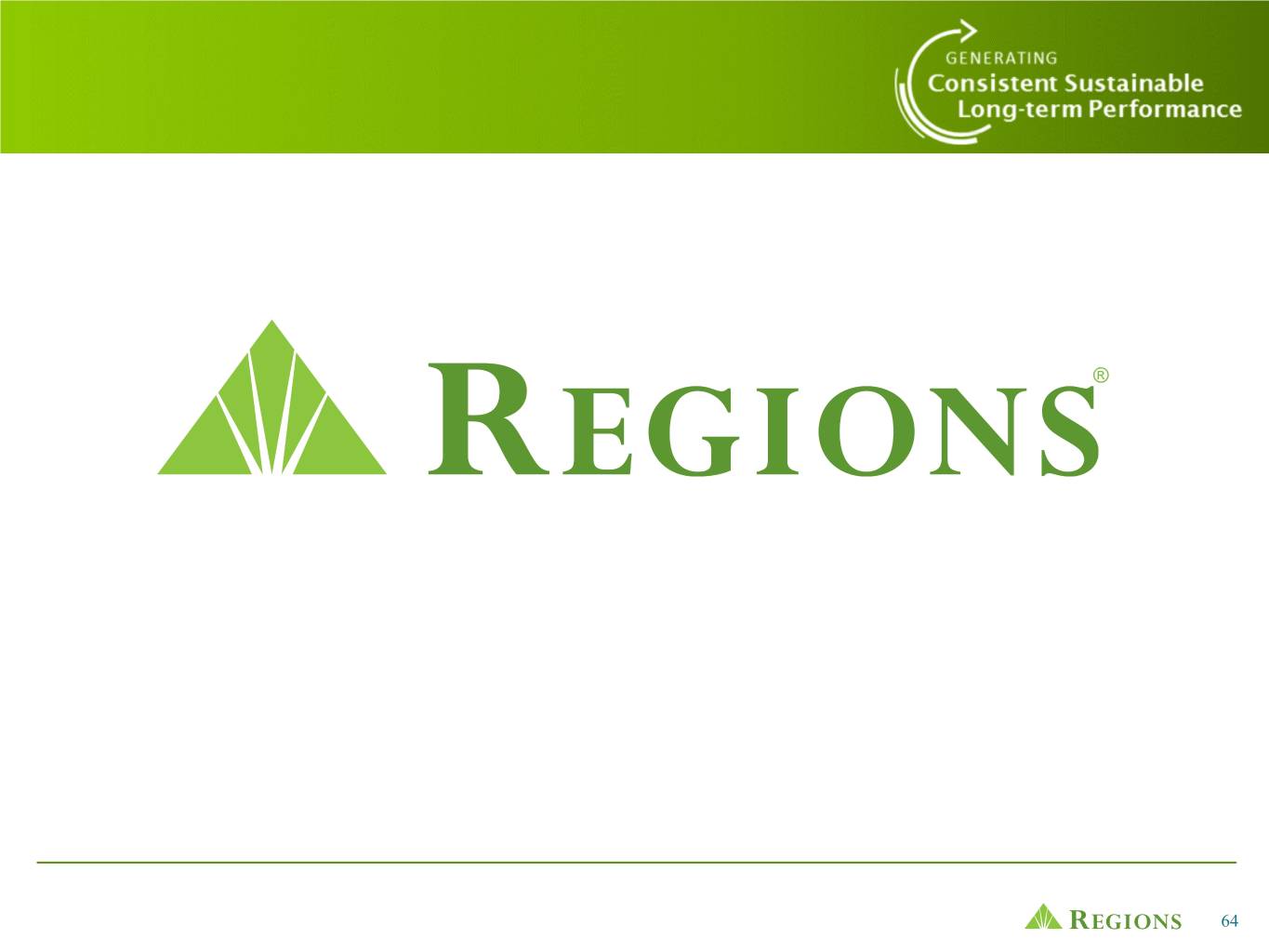
® 64































































